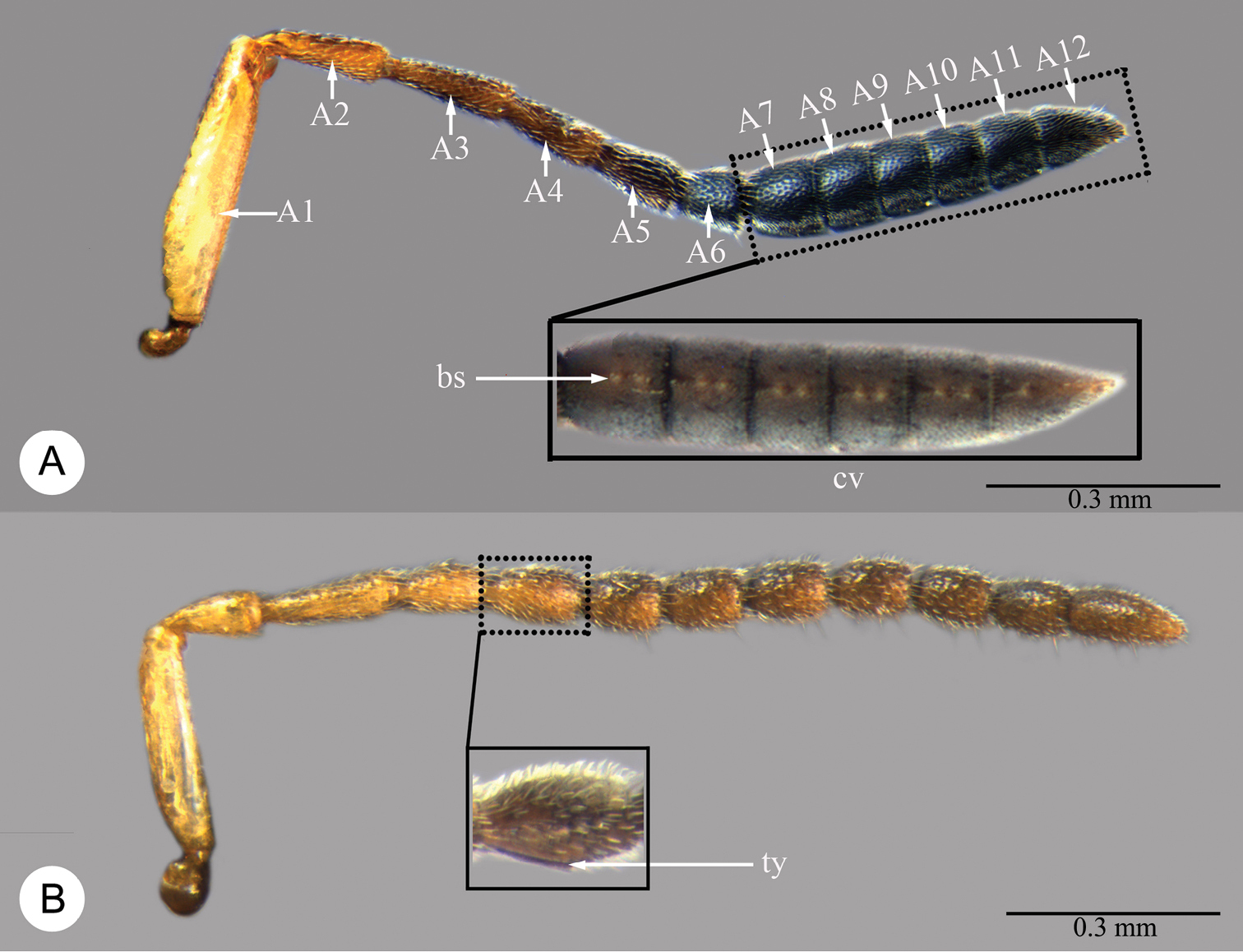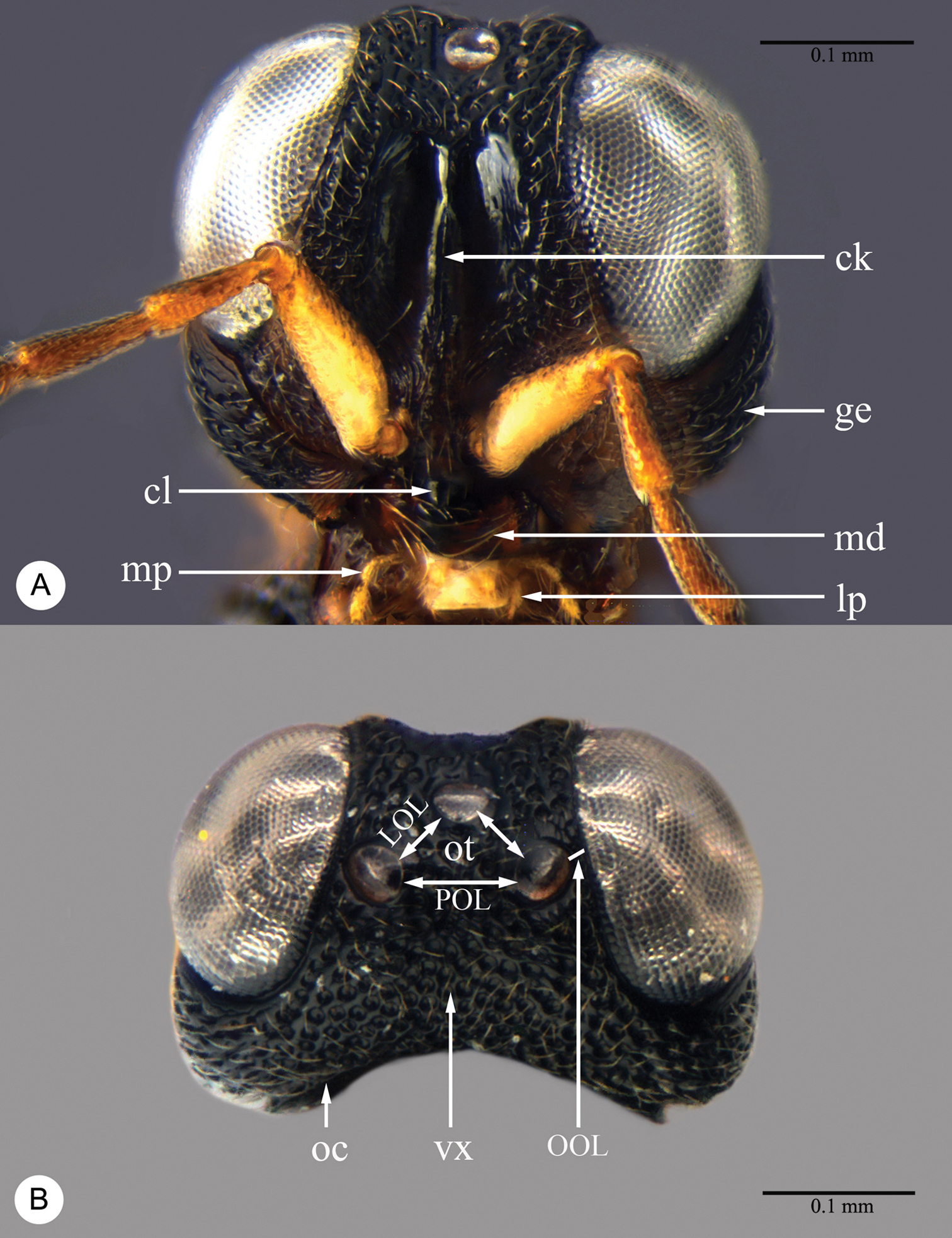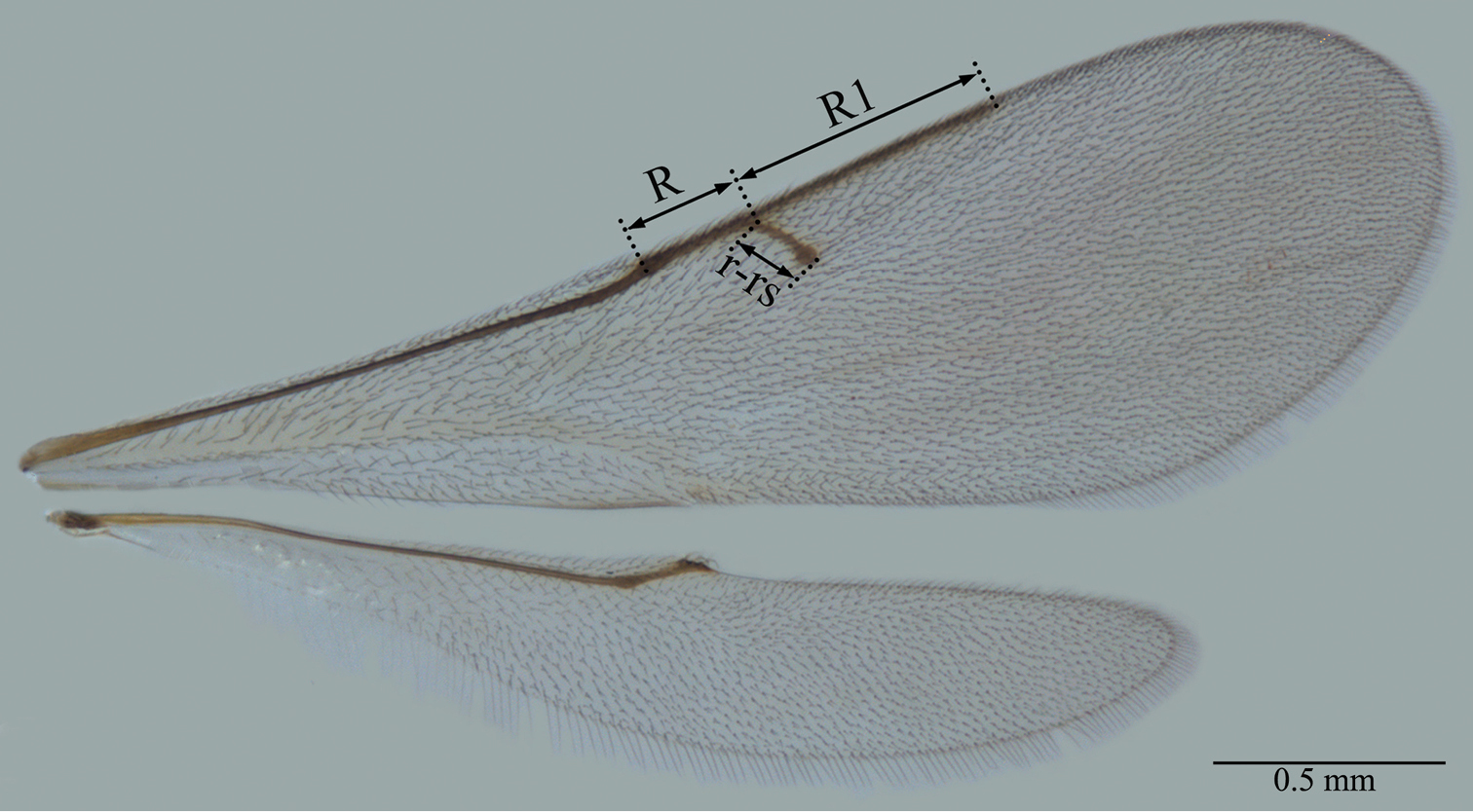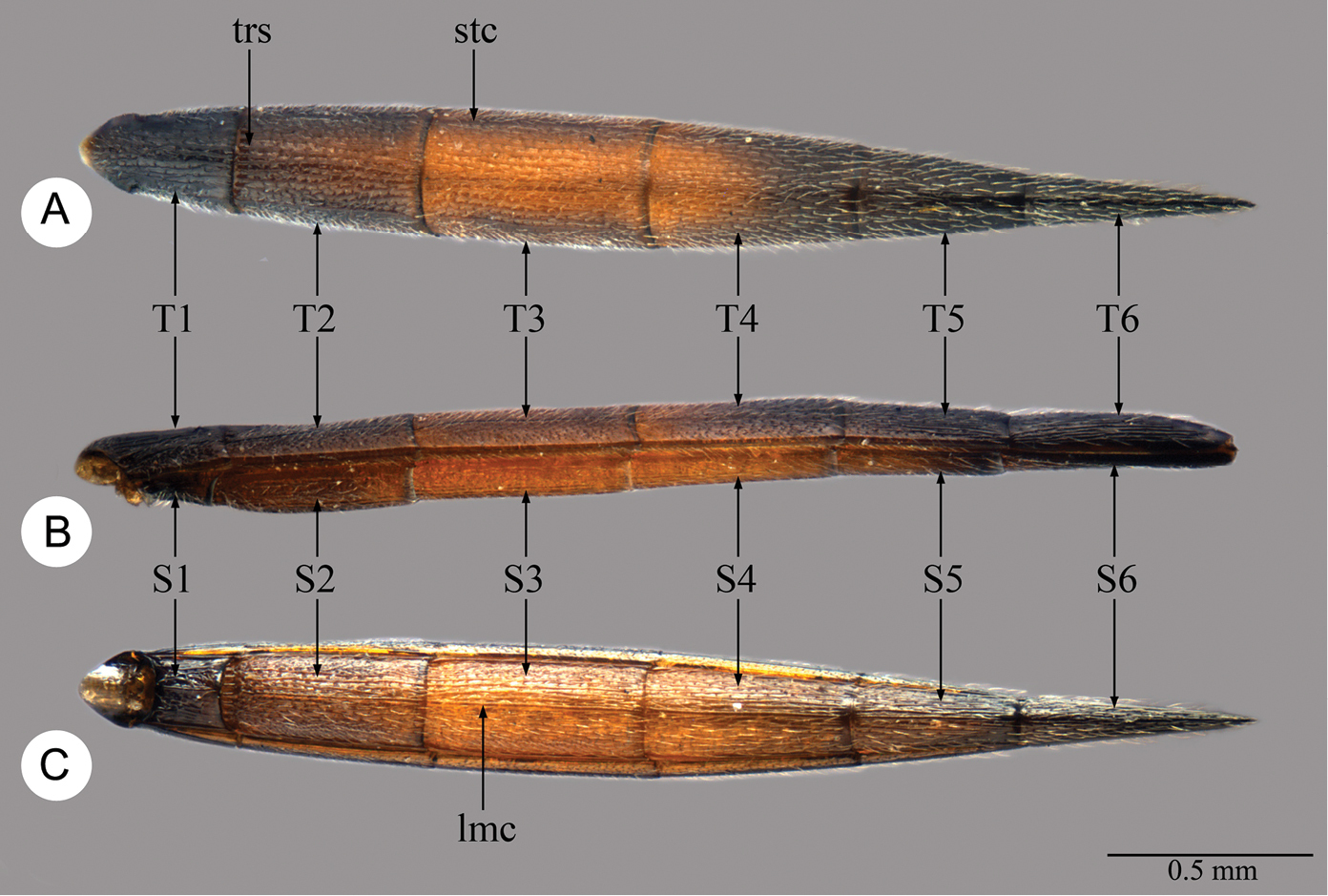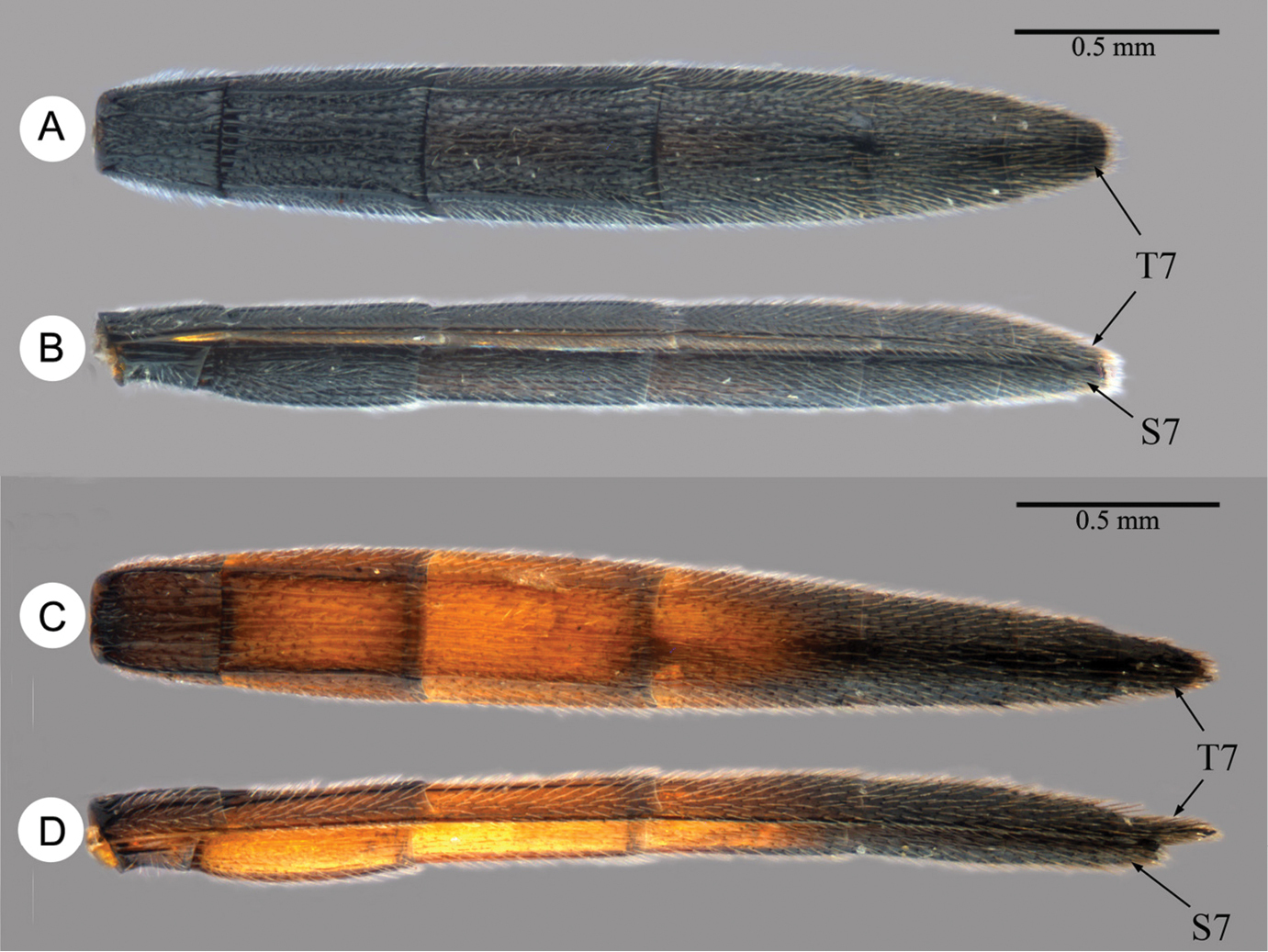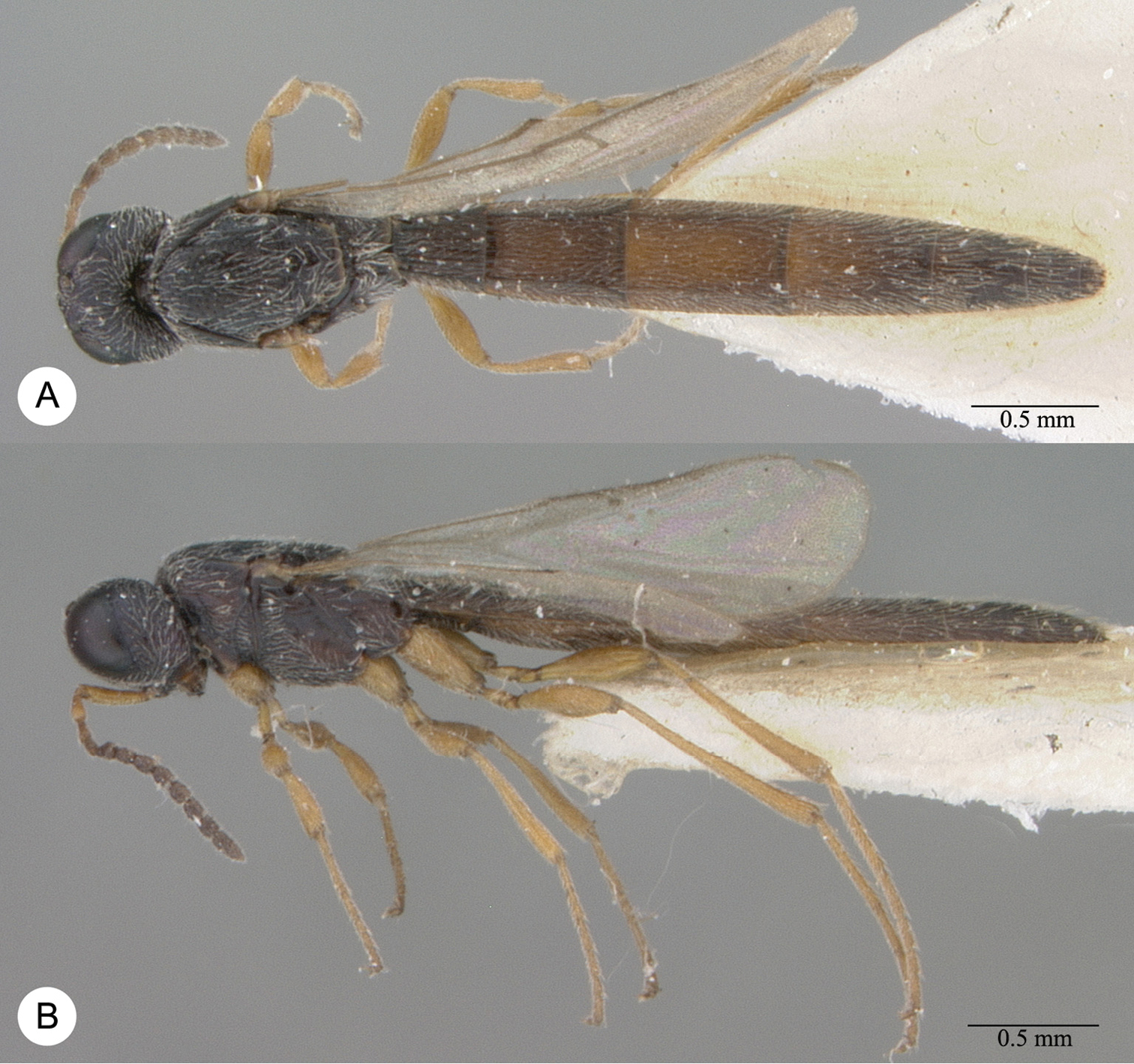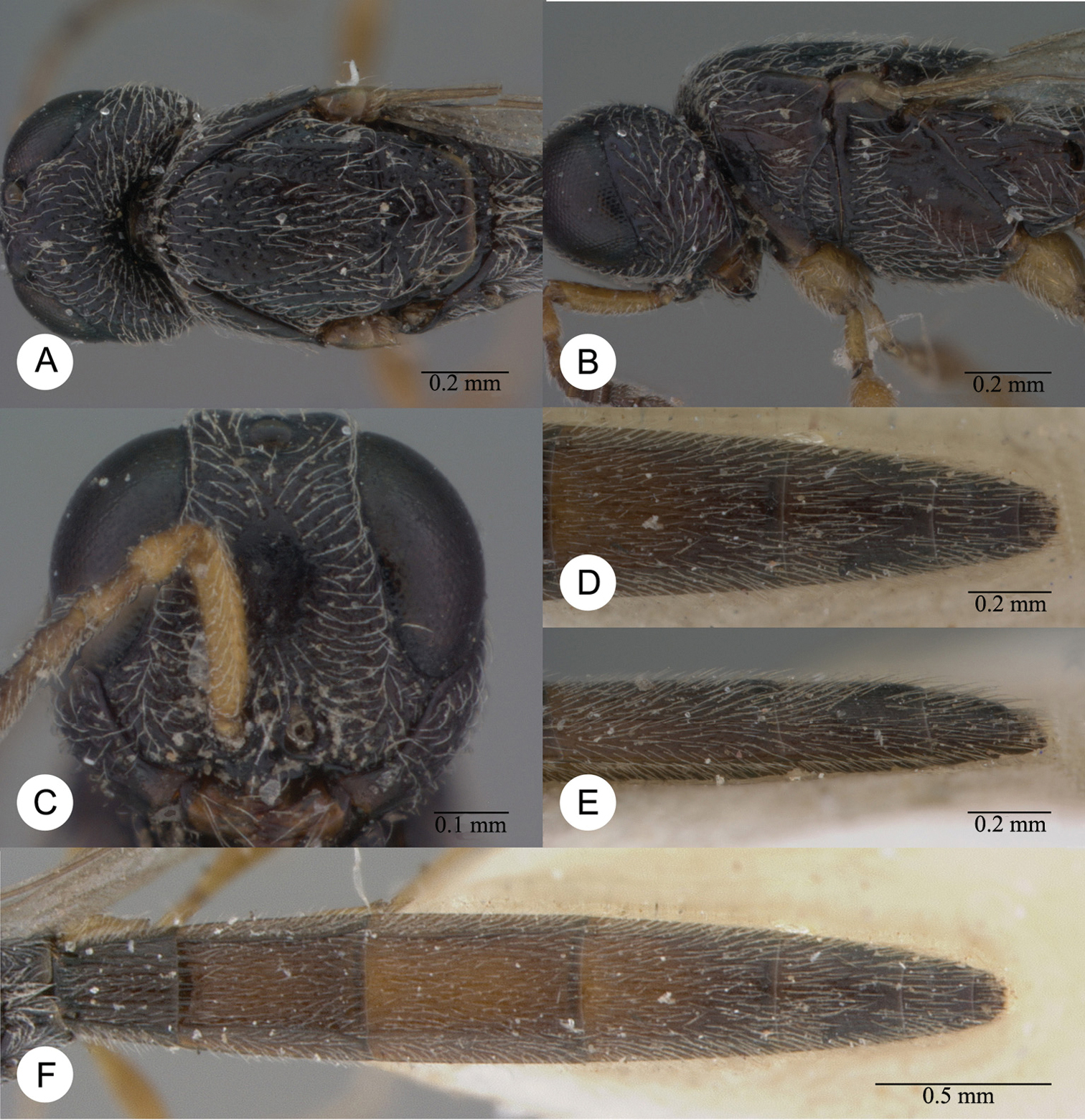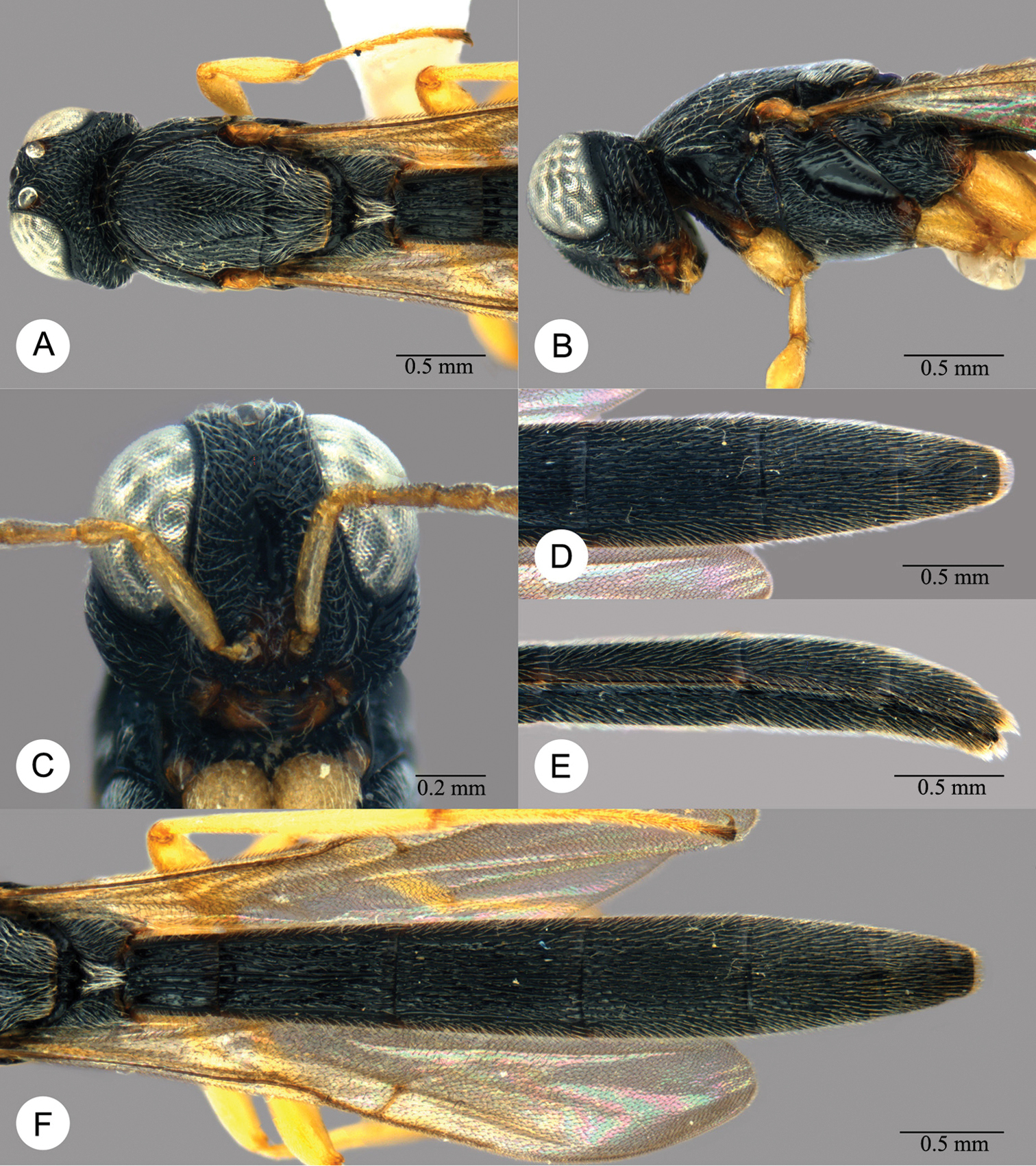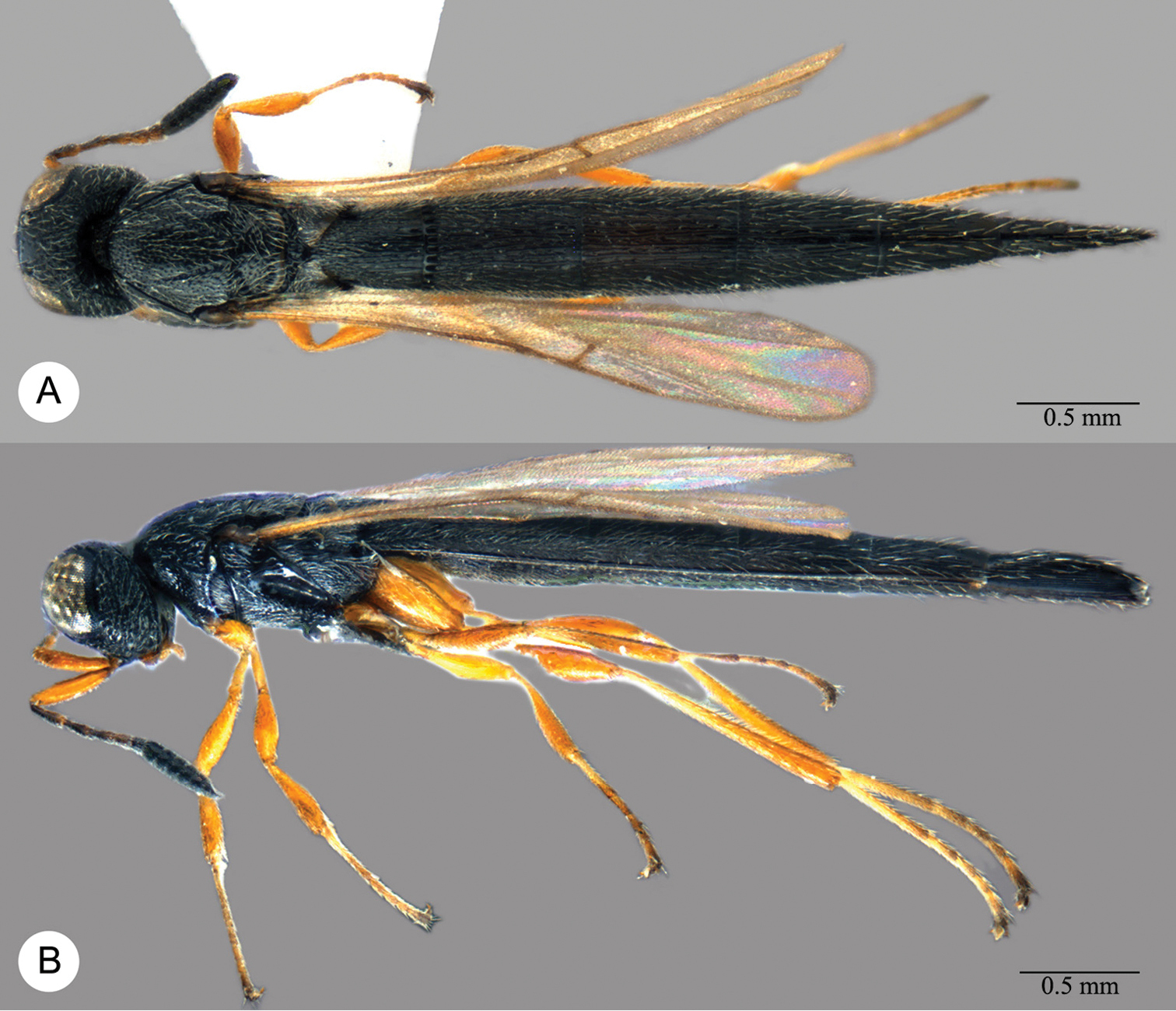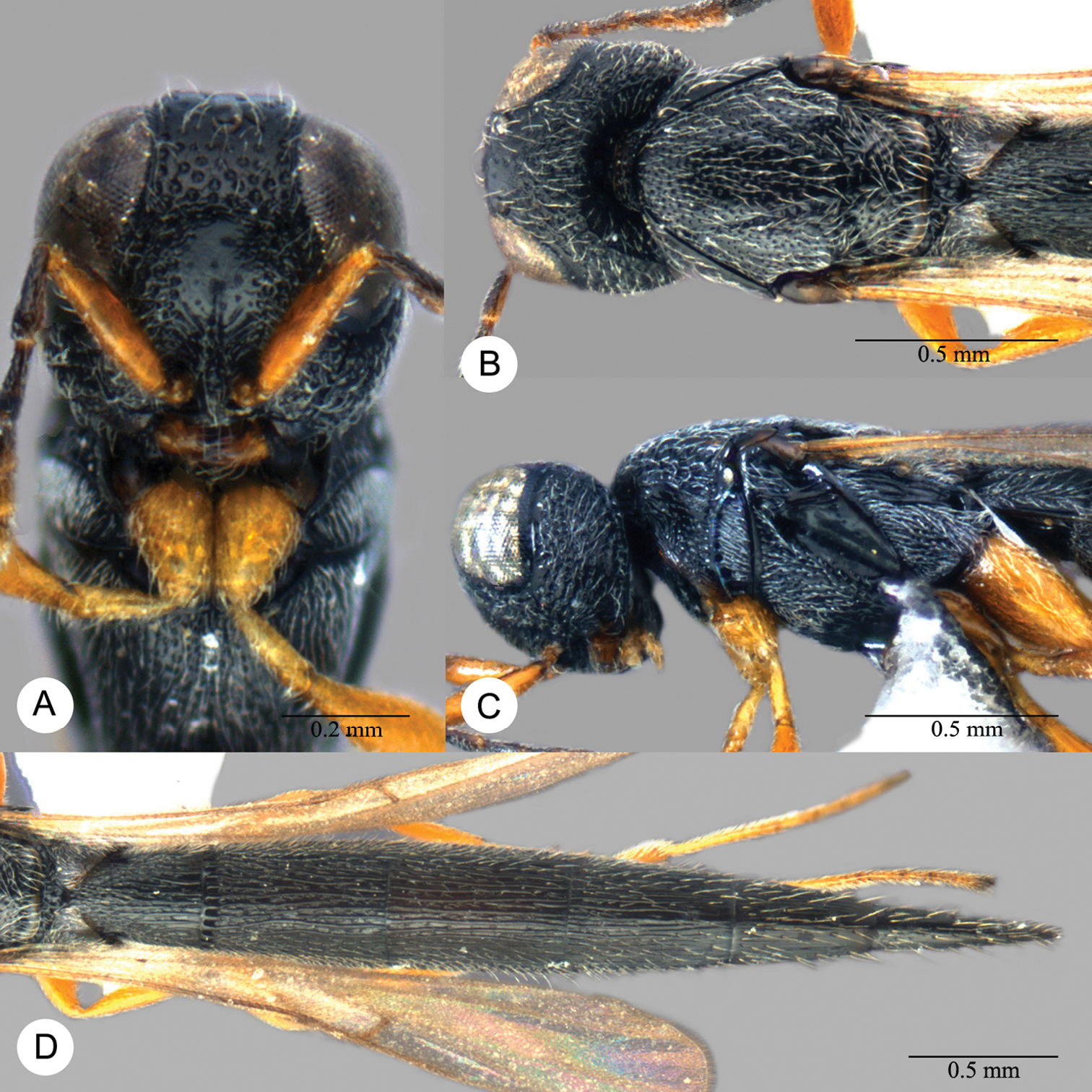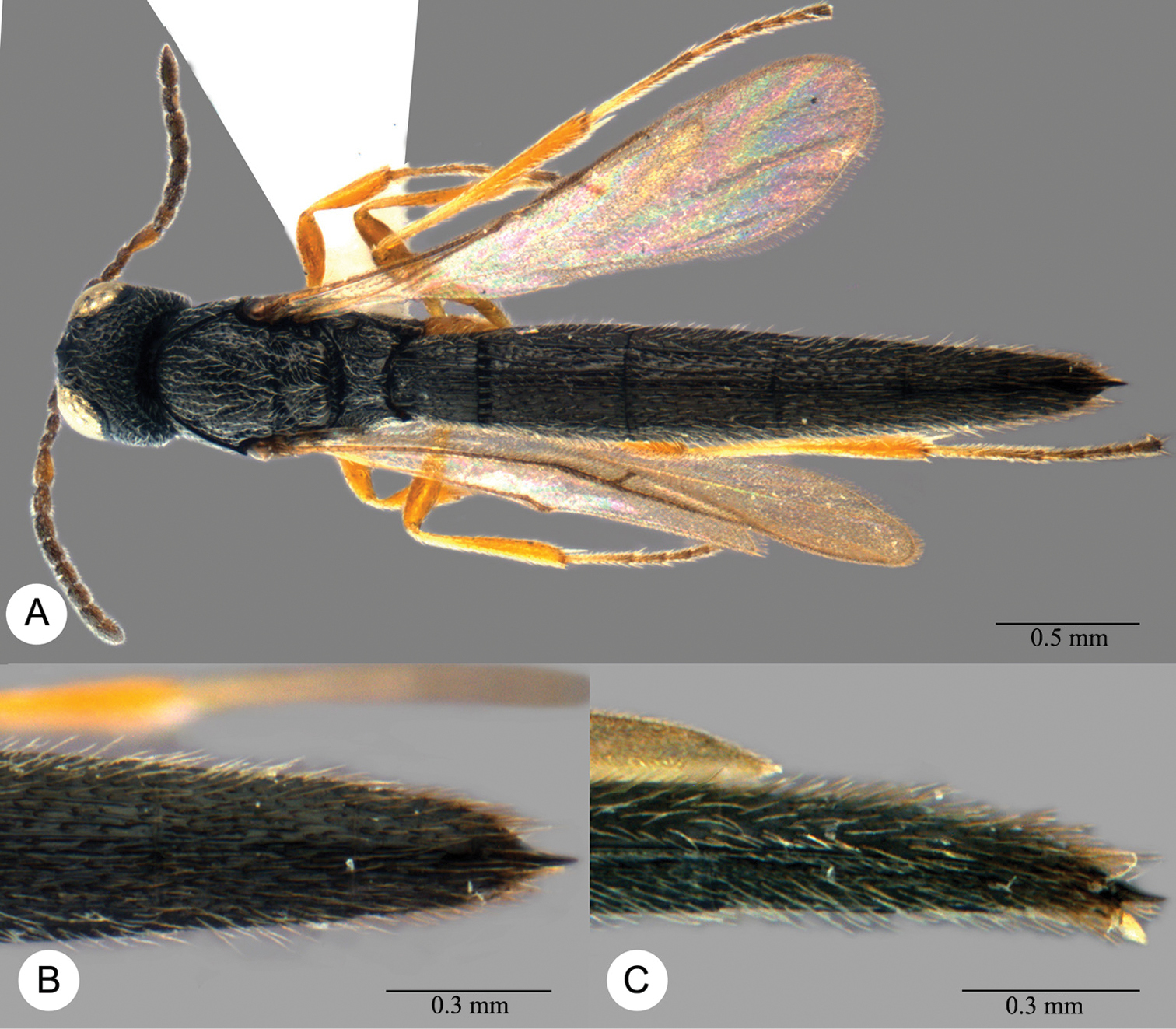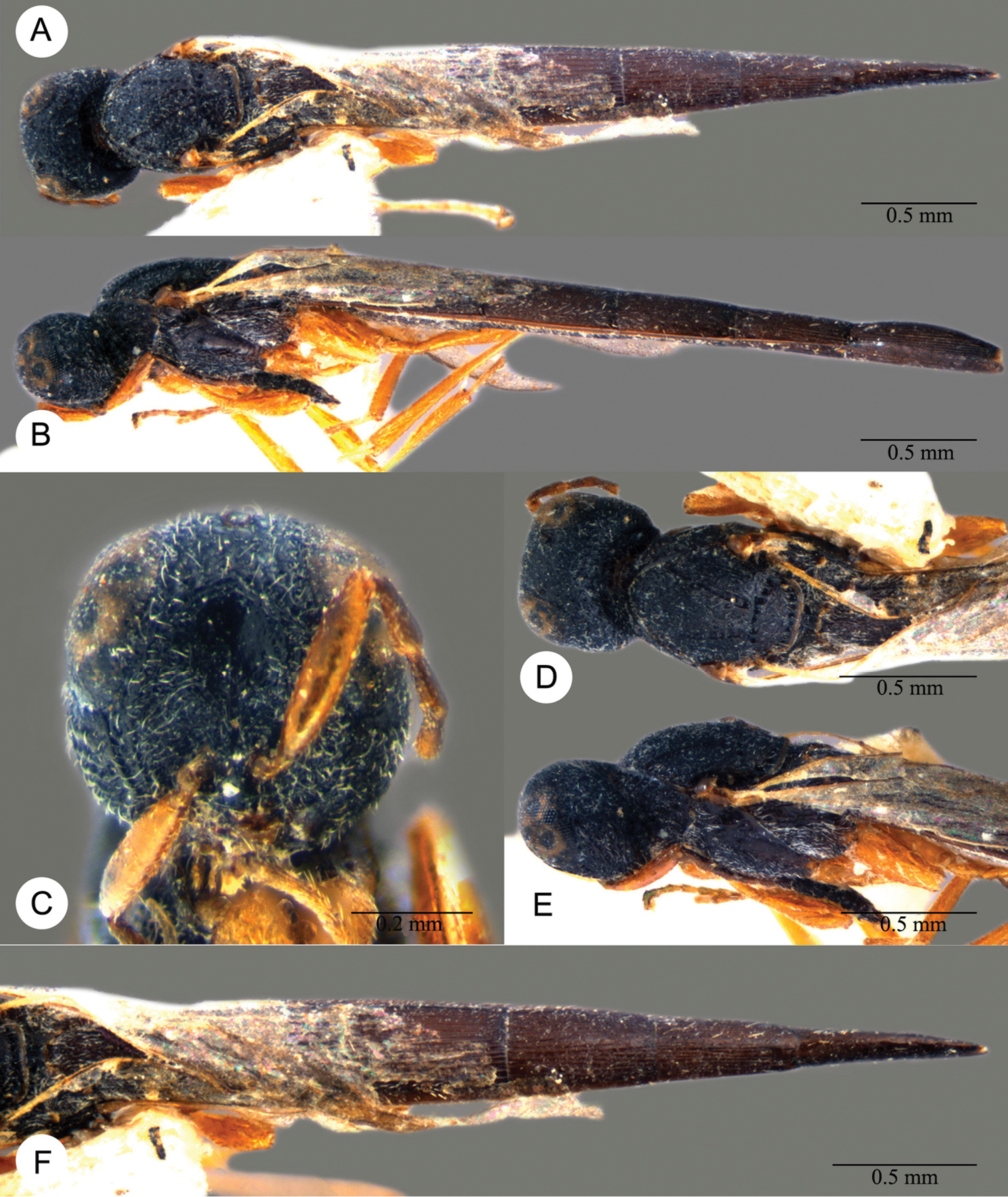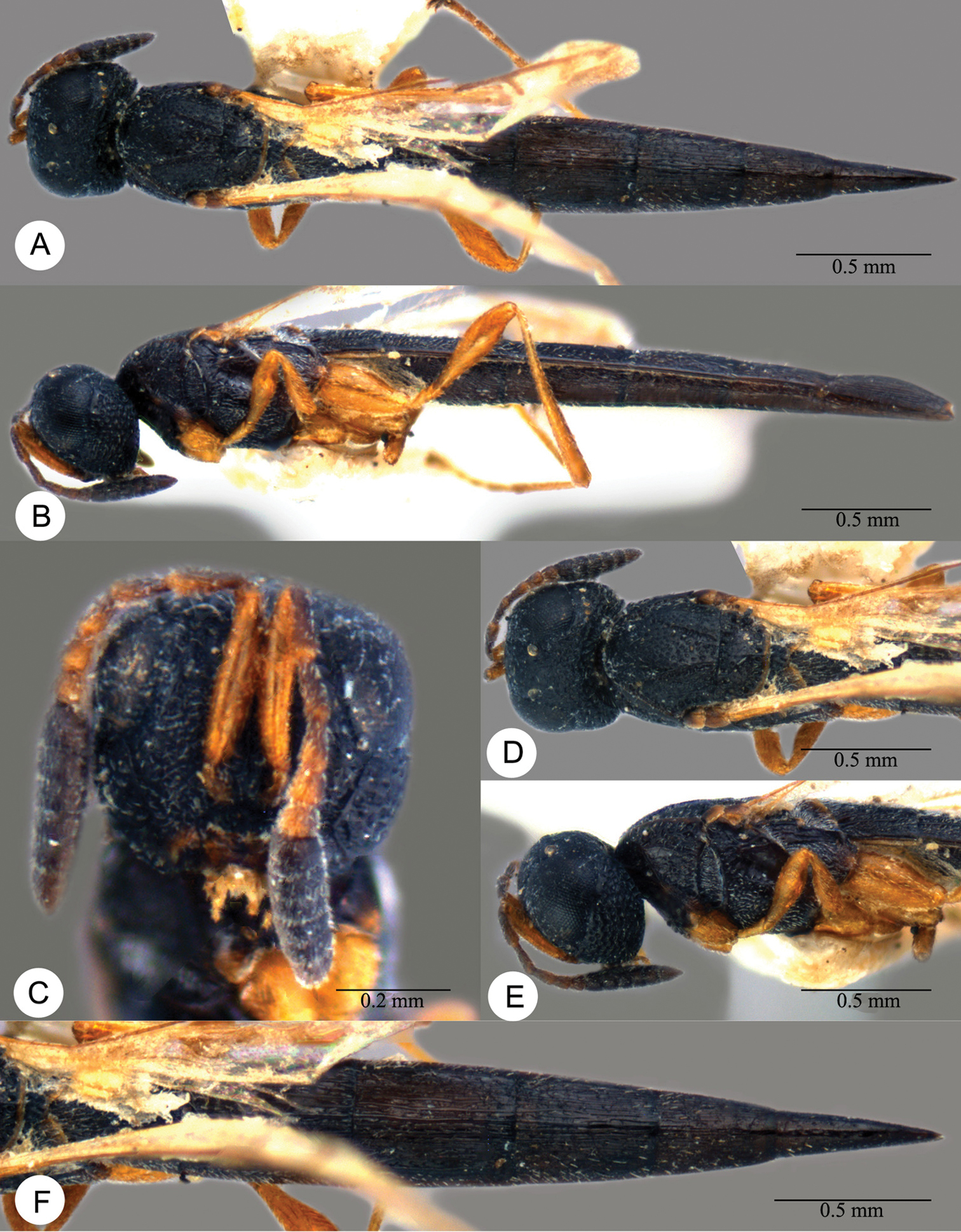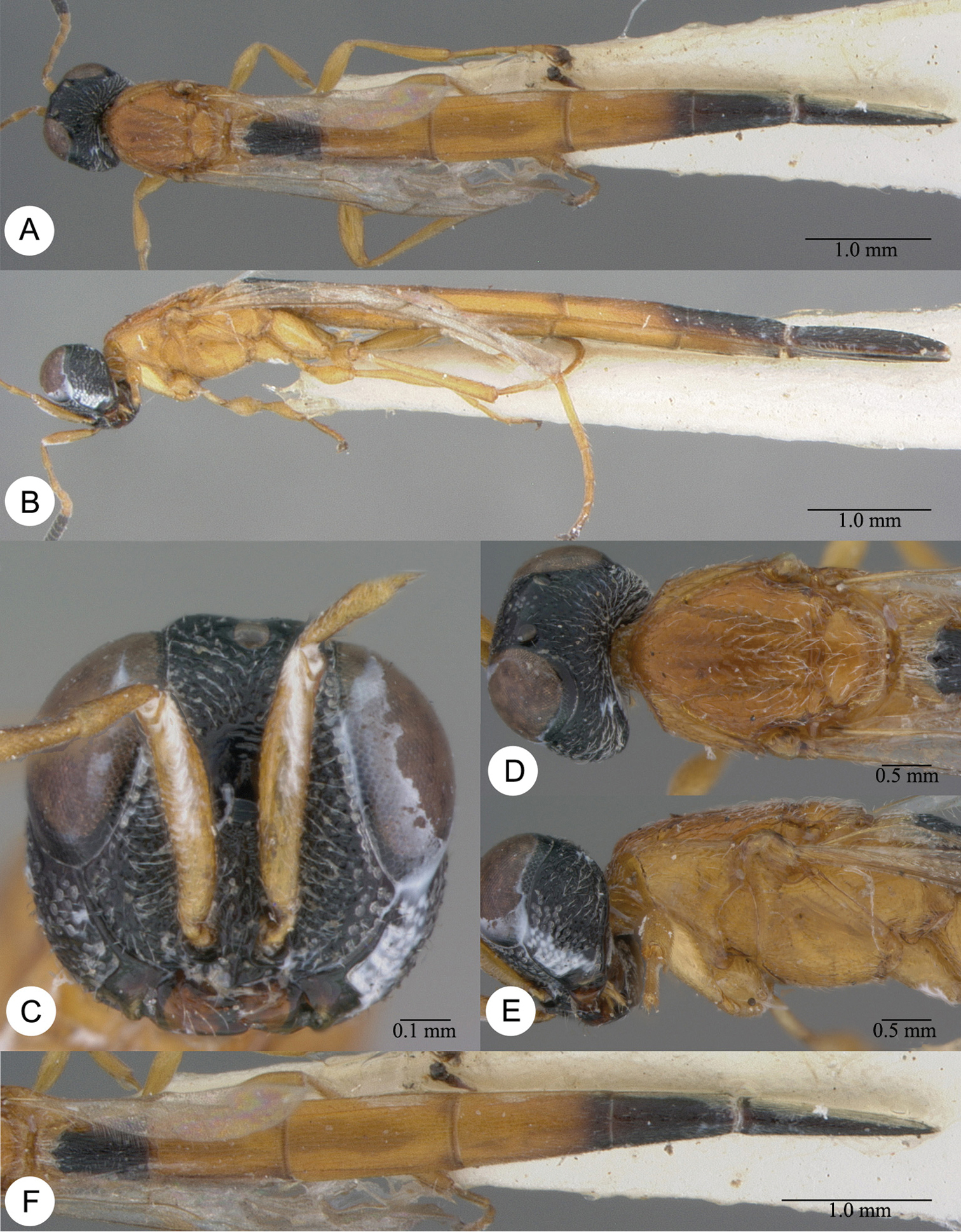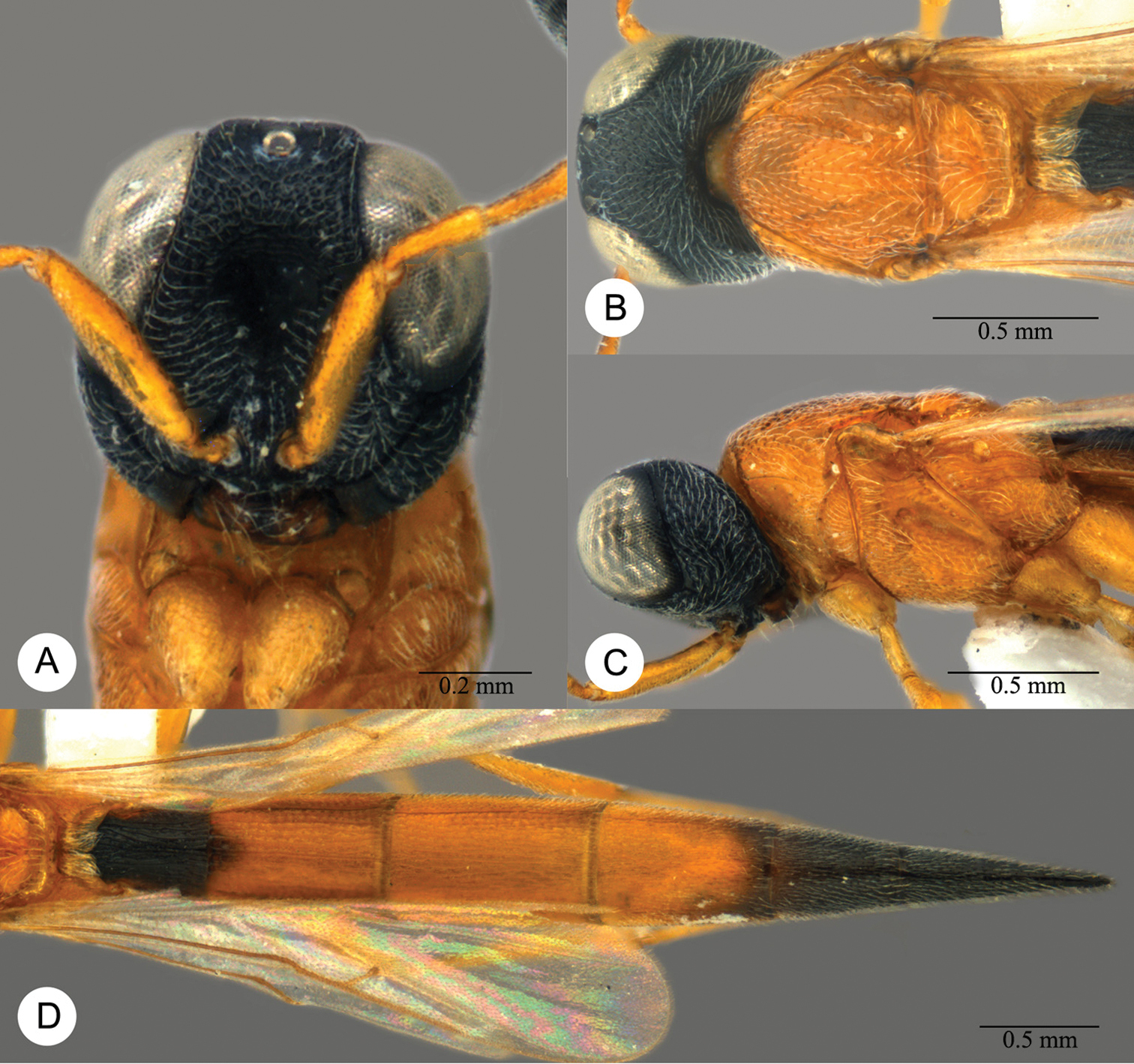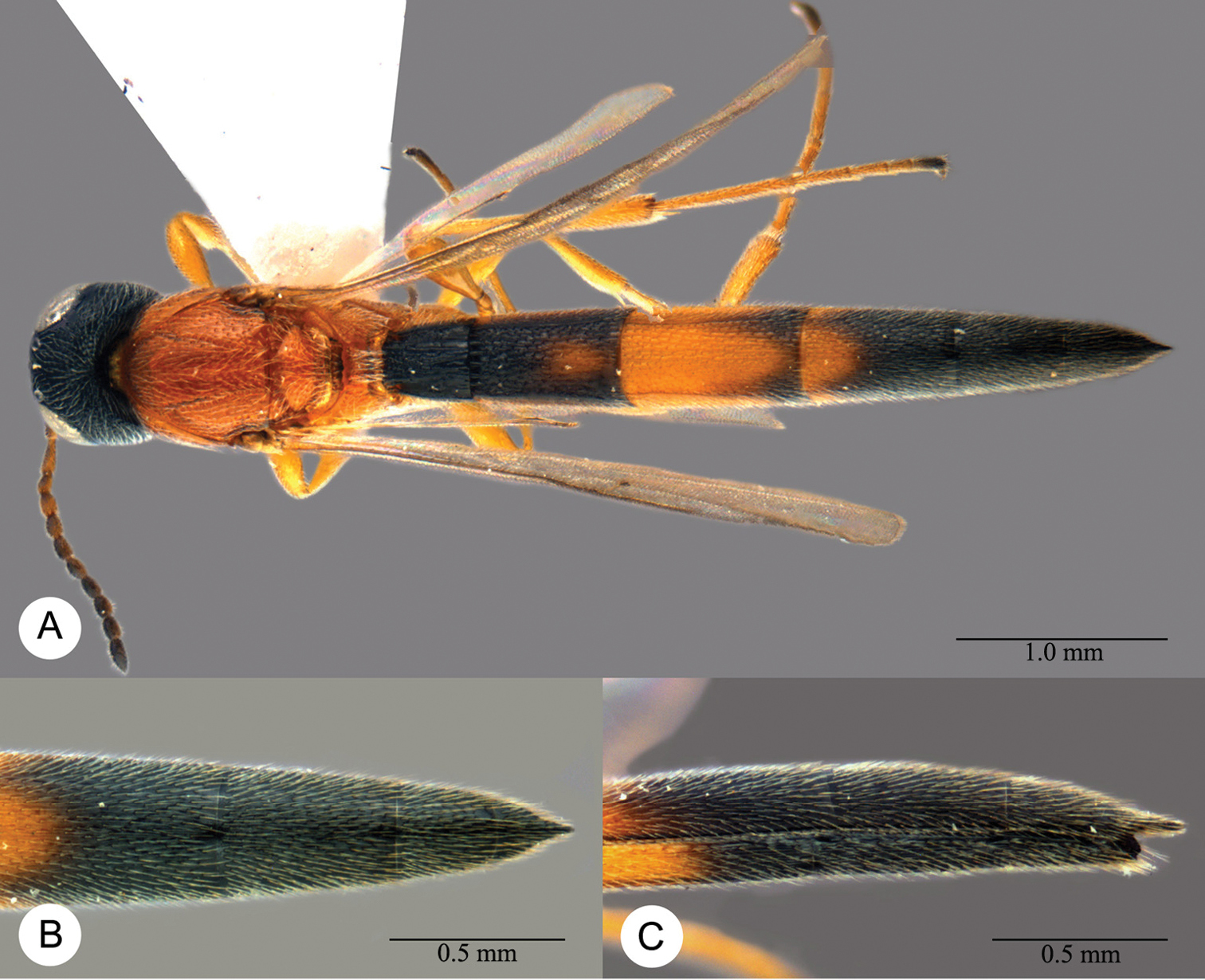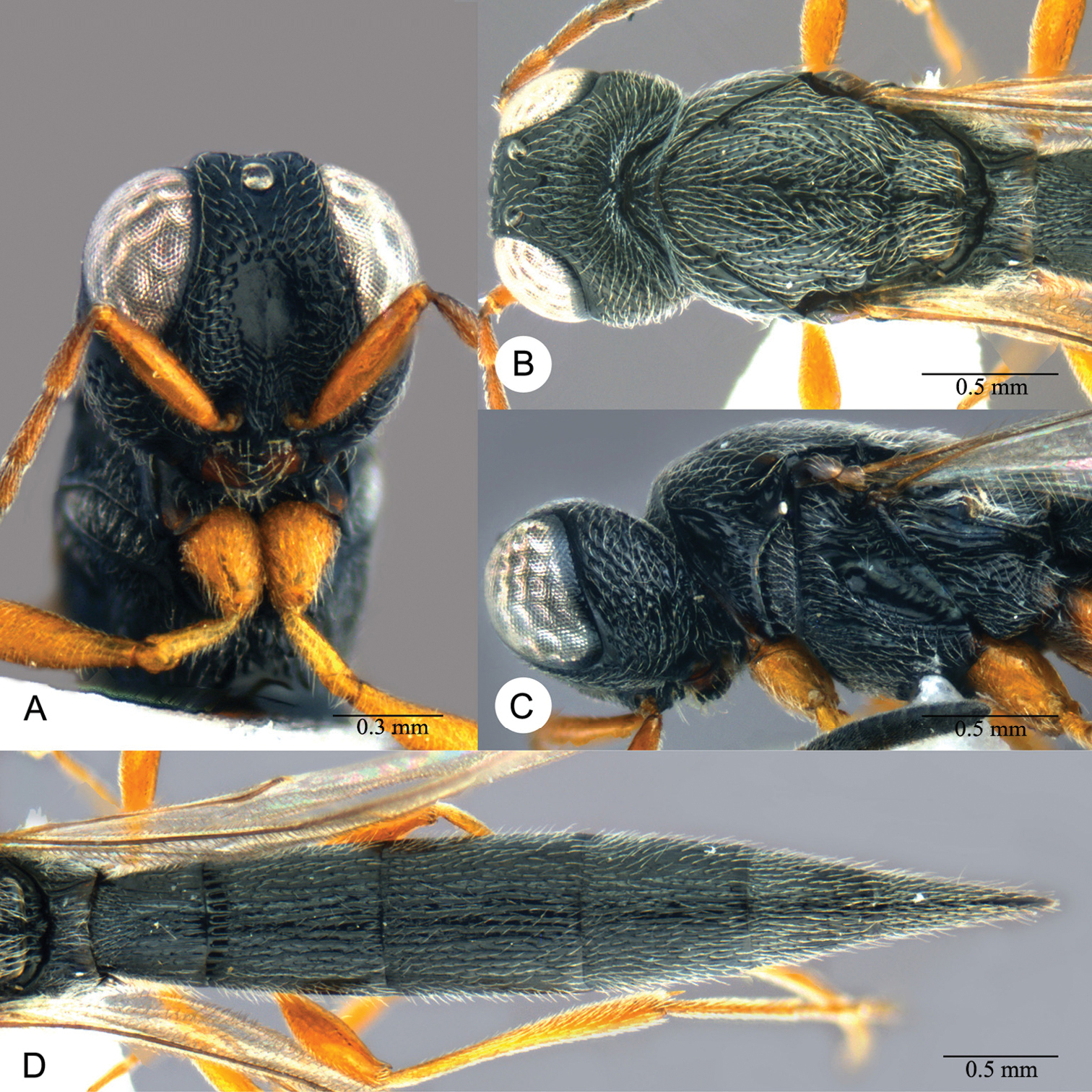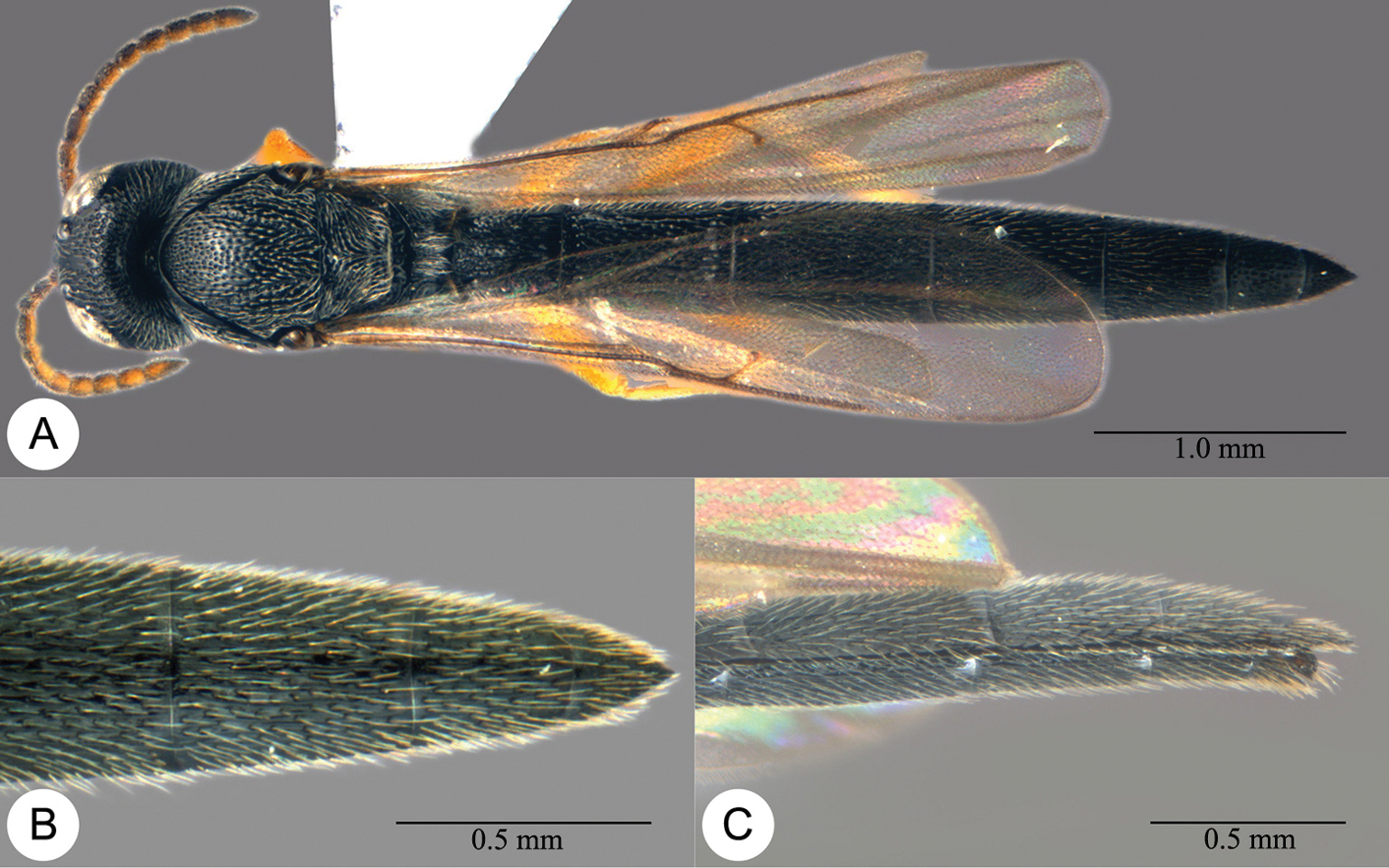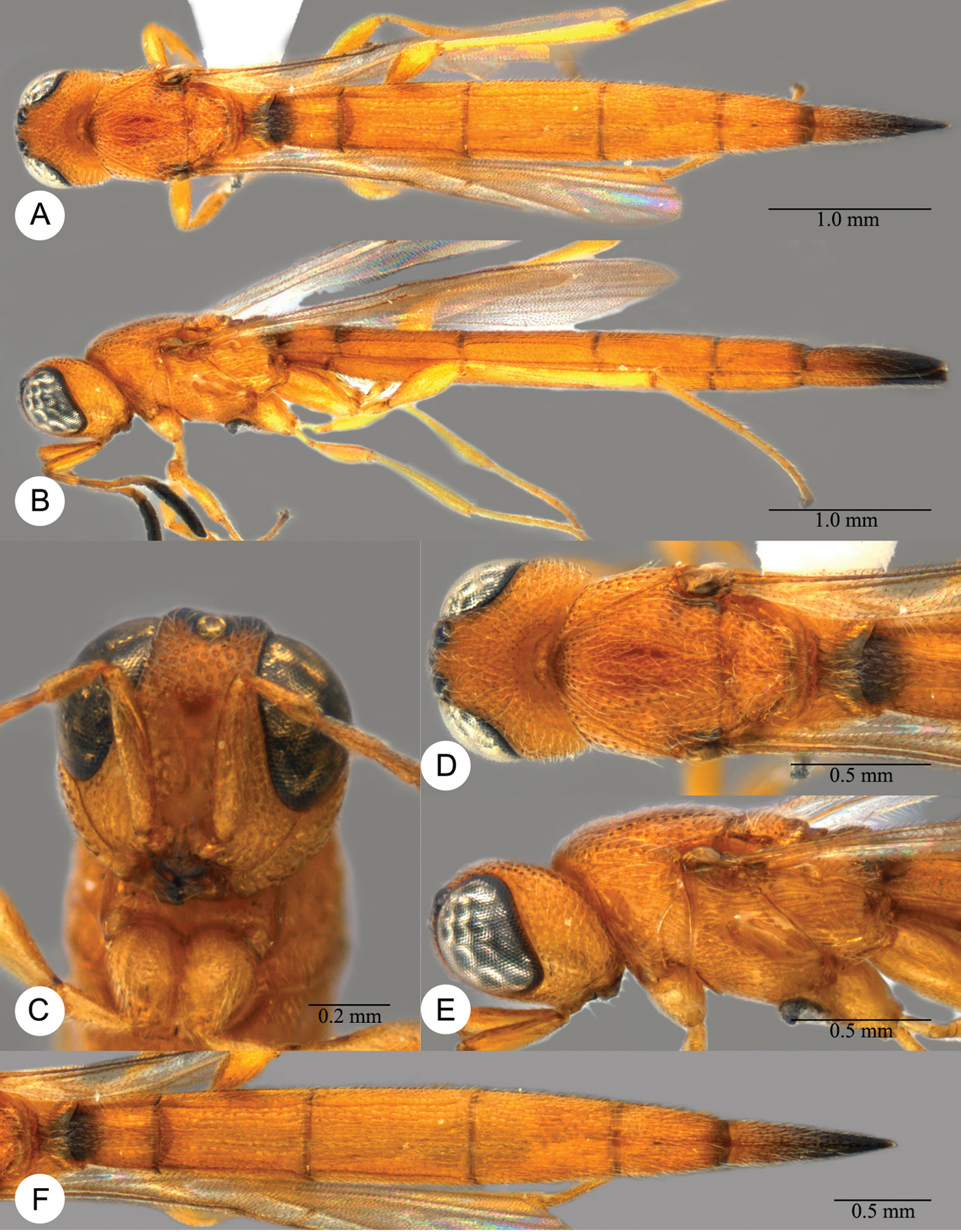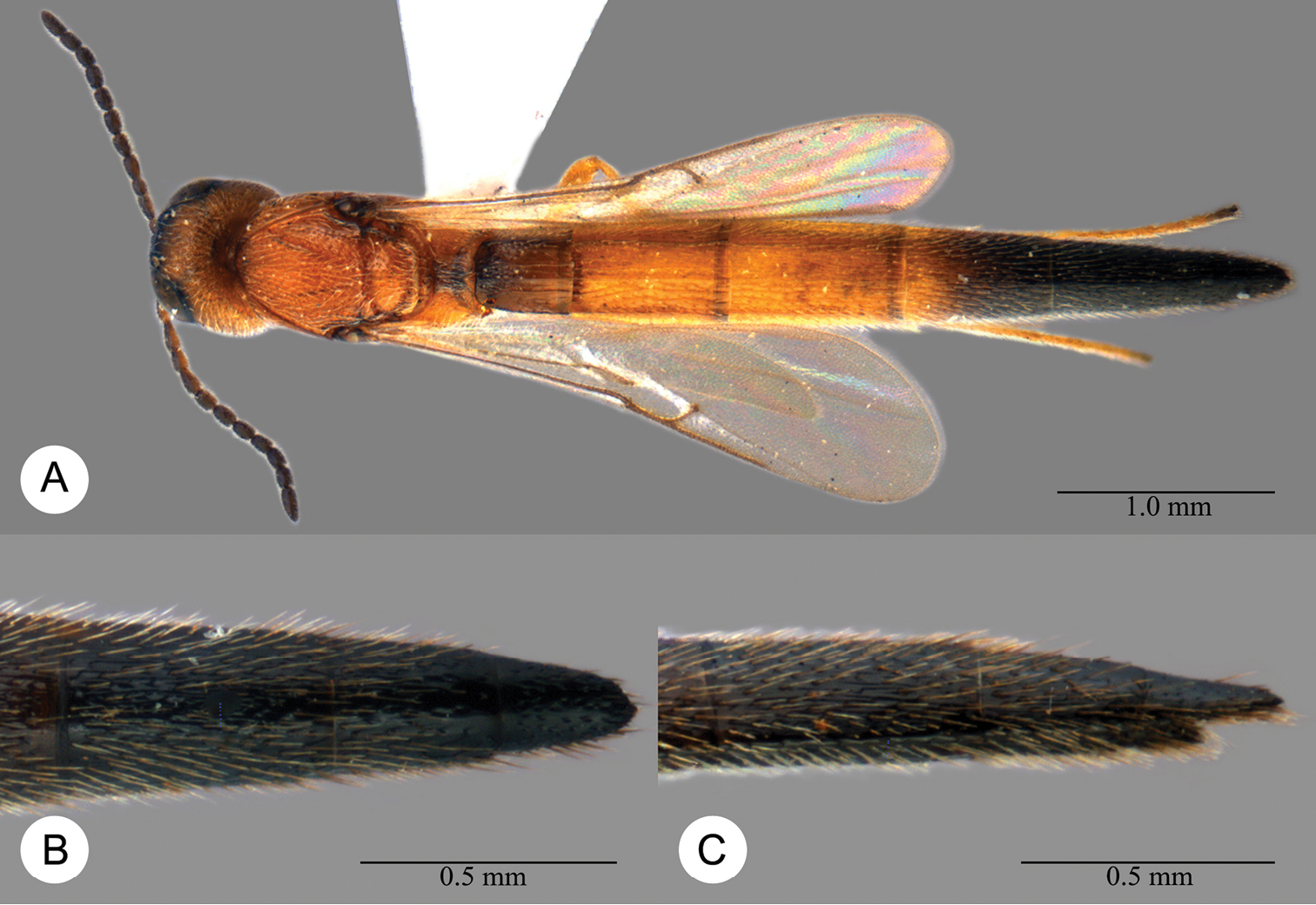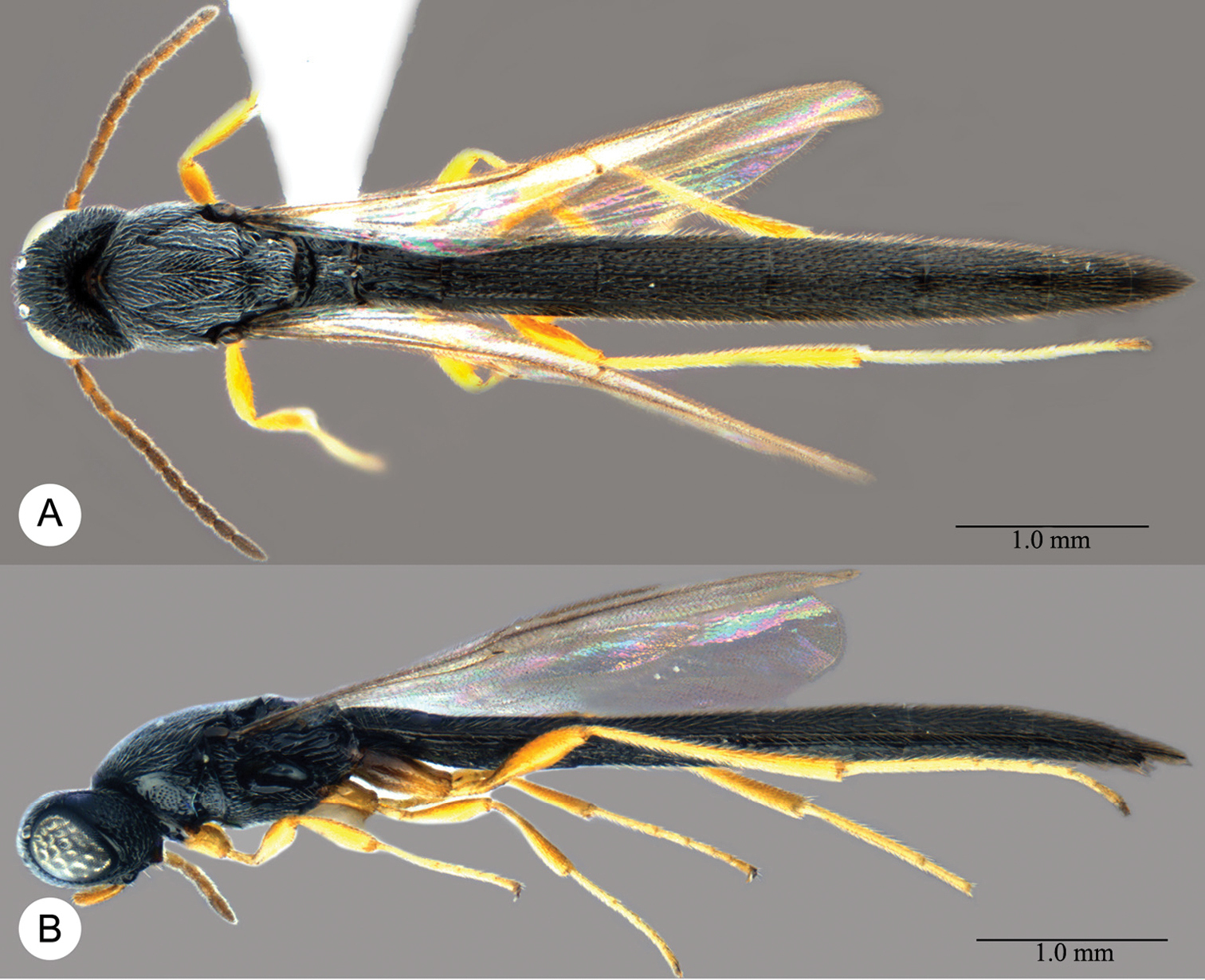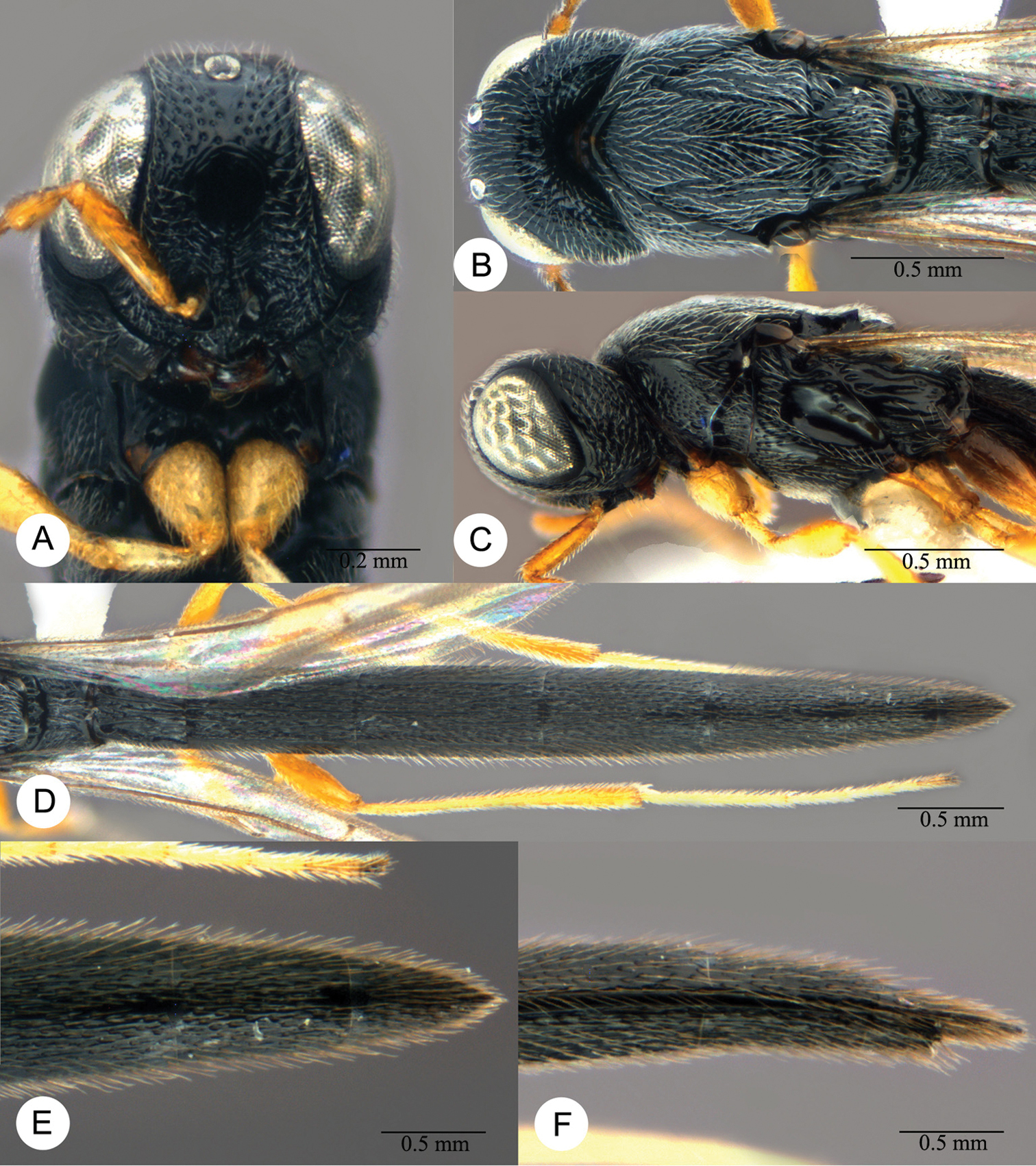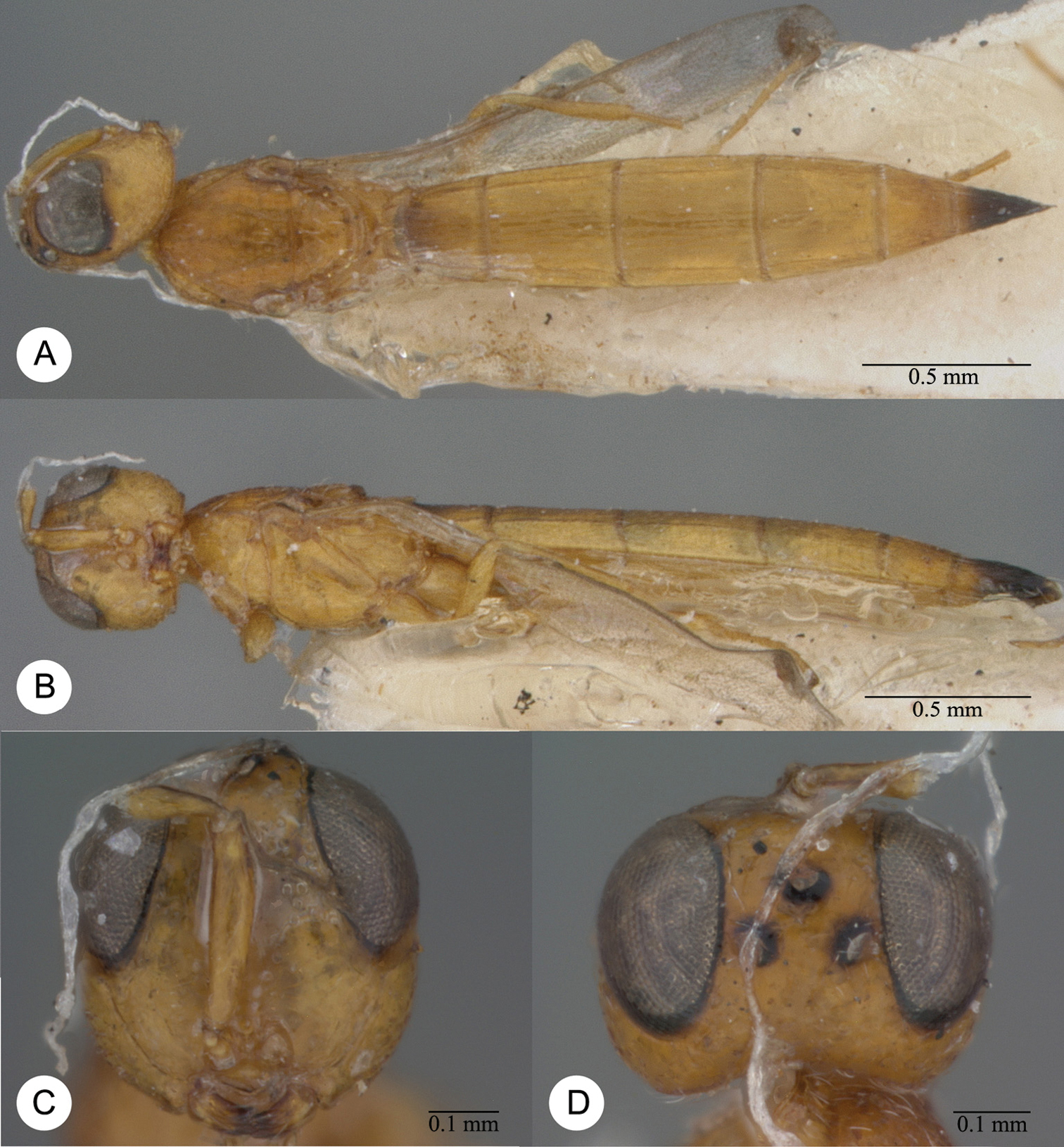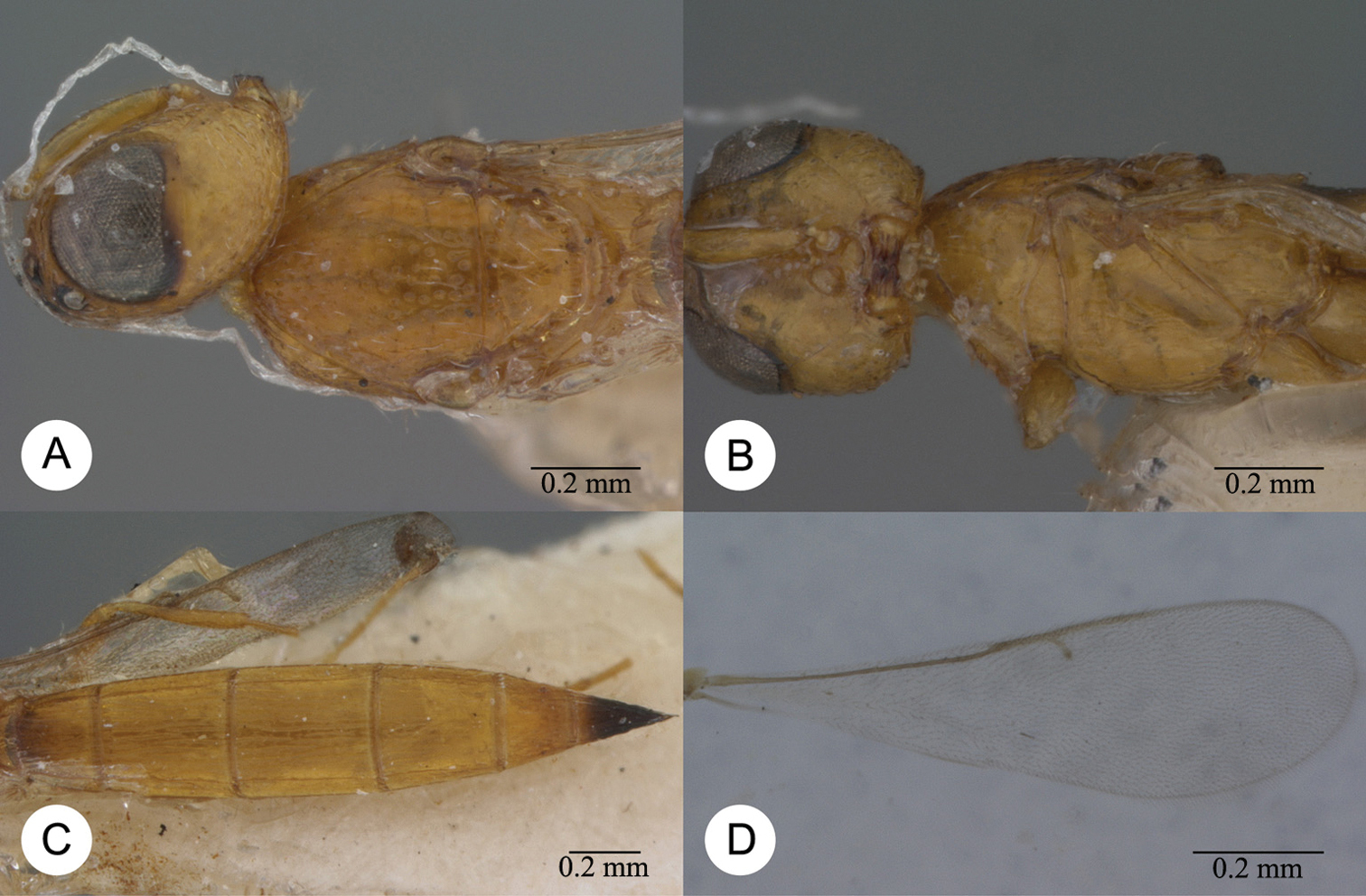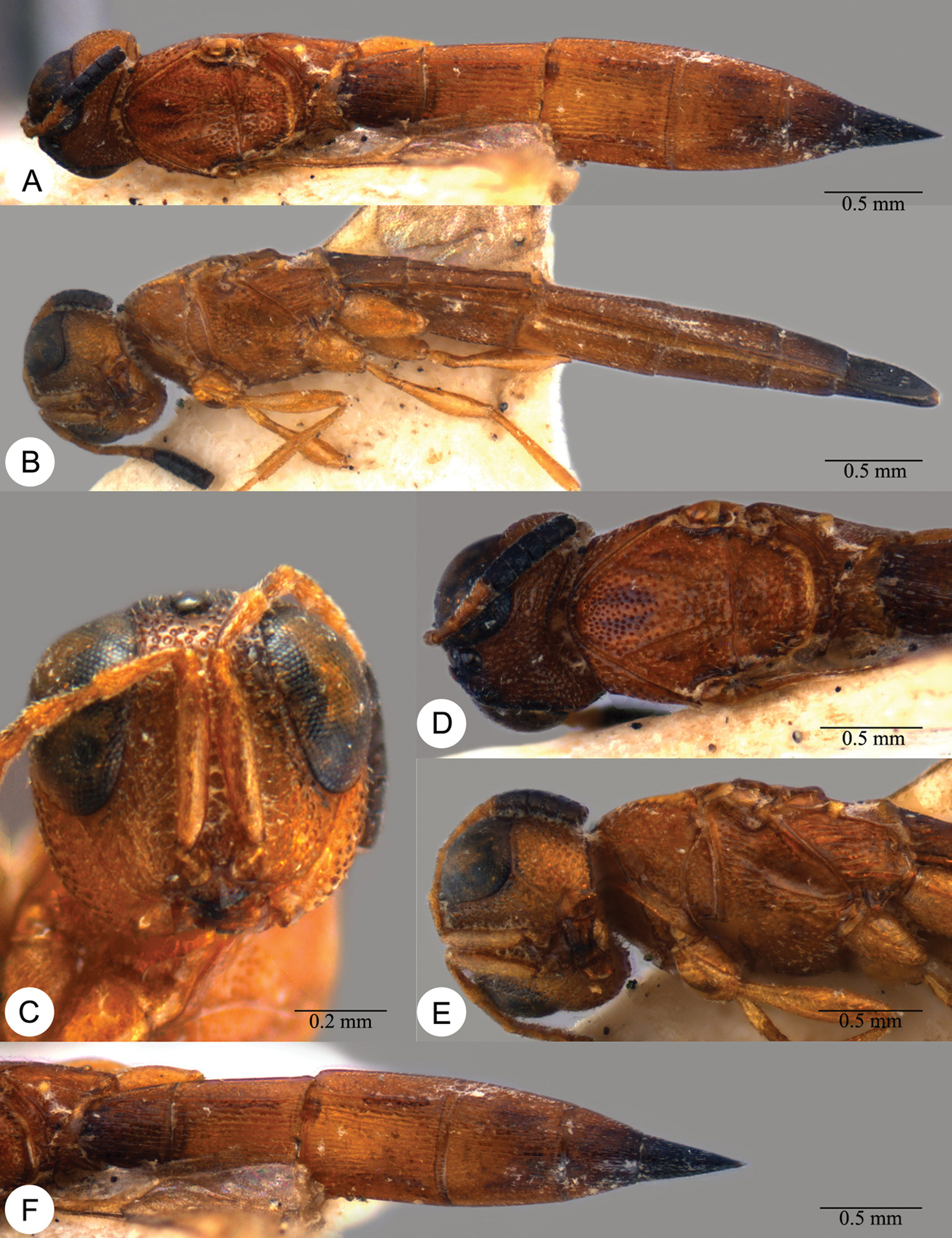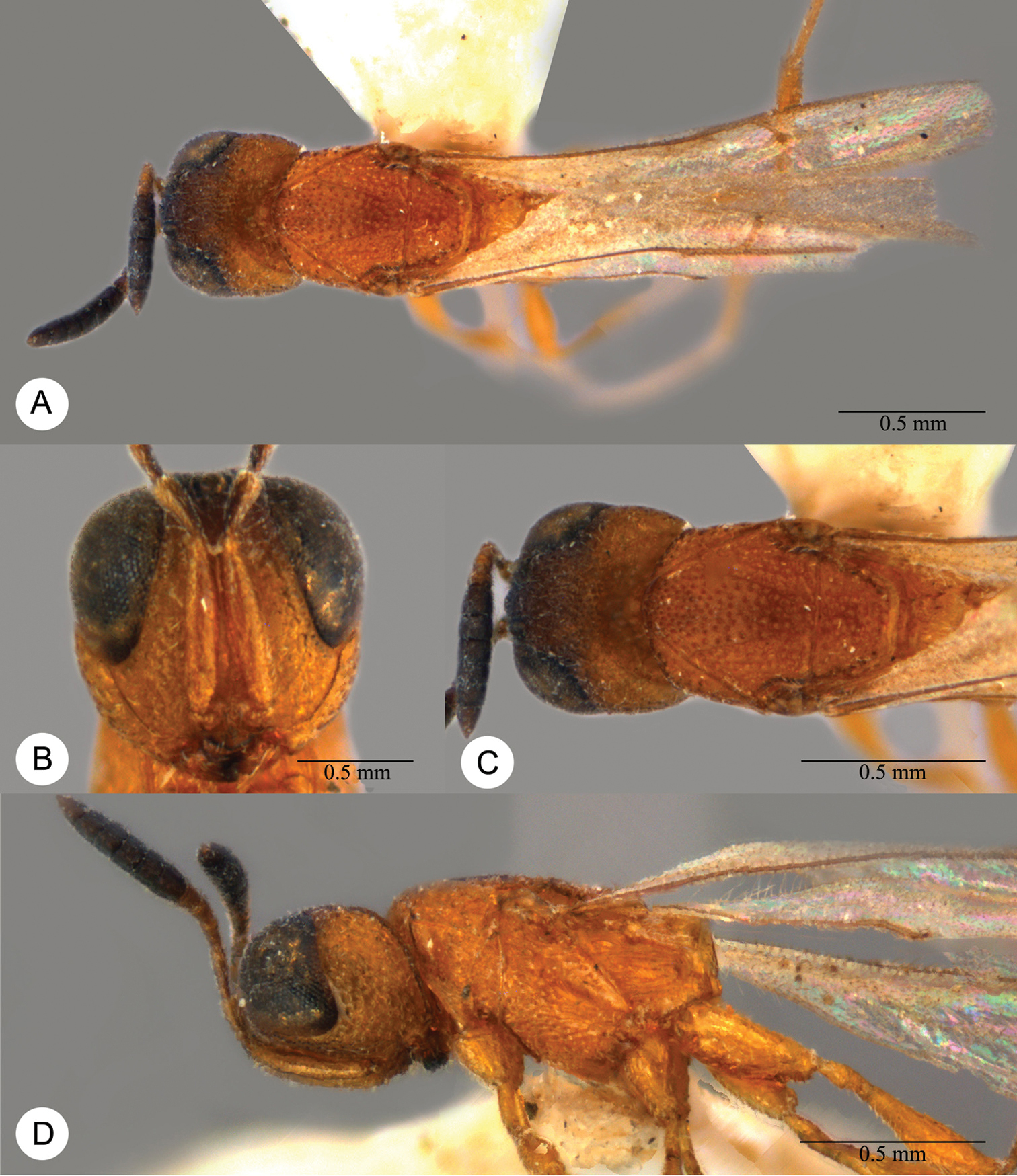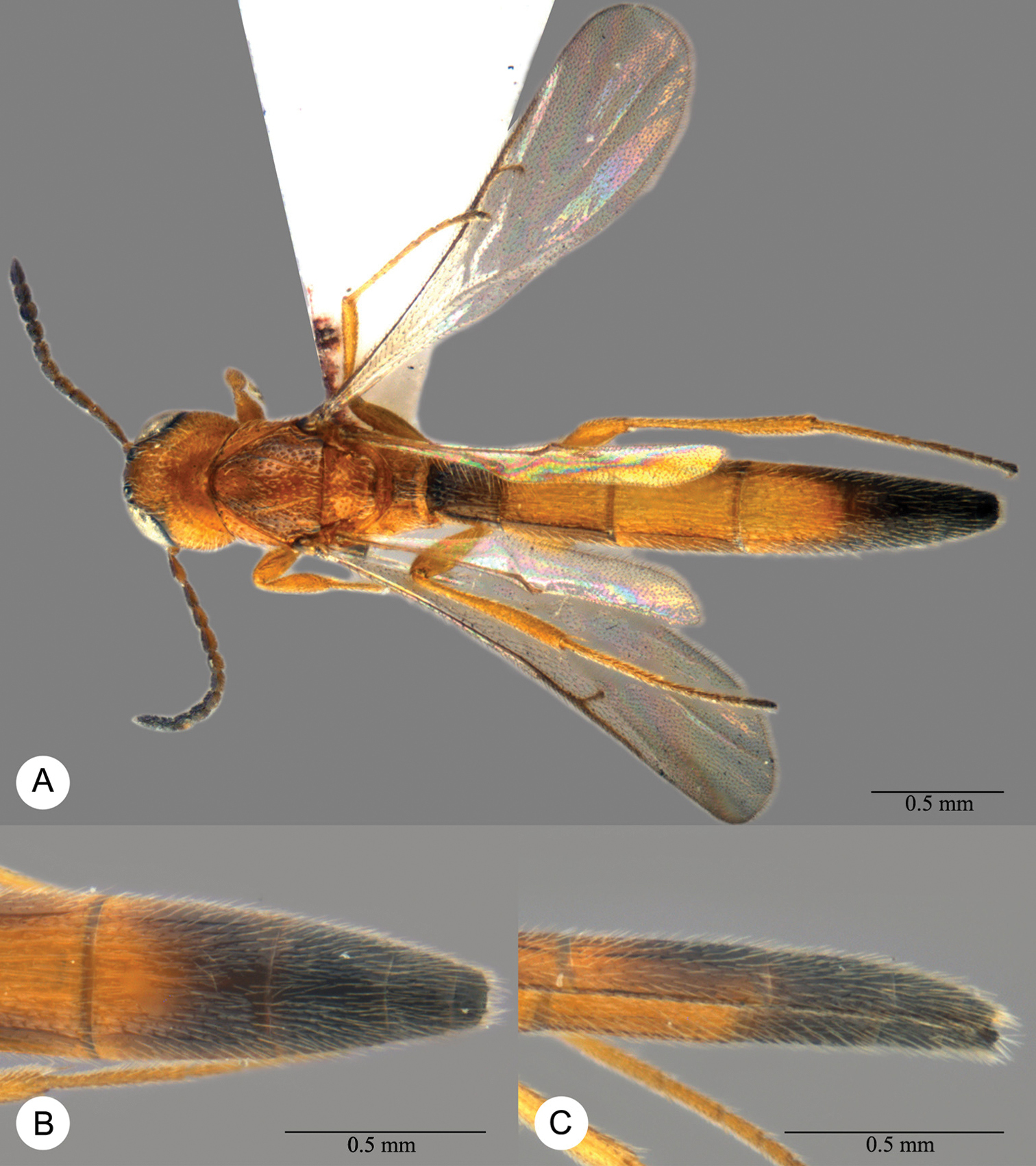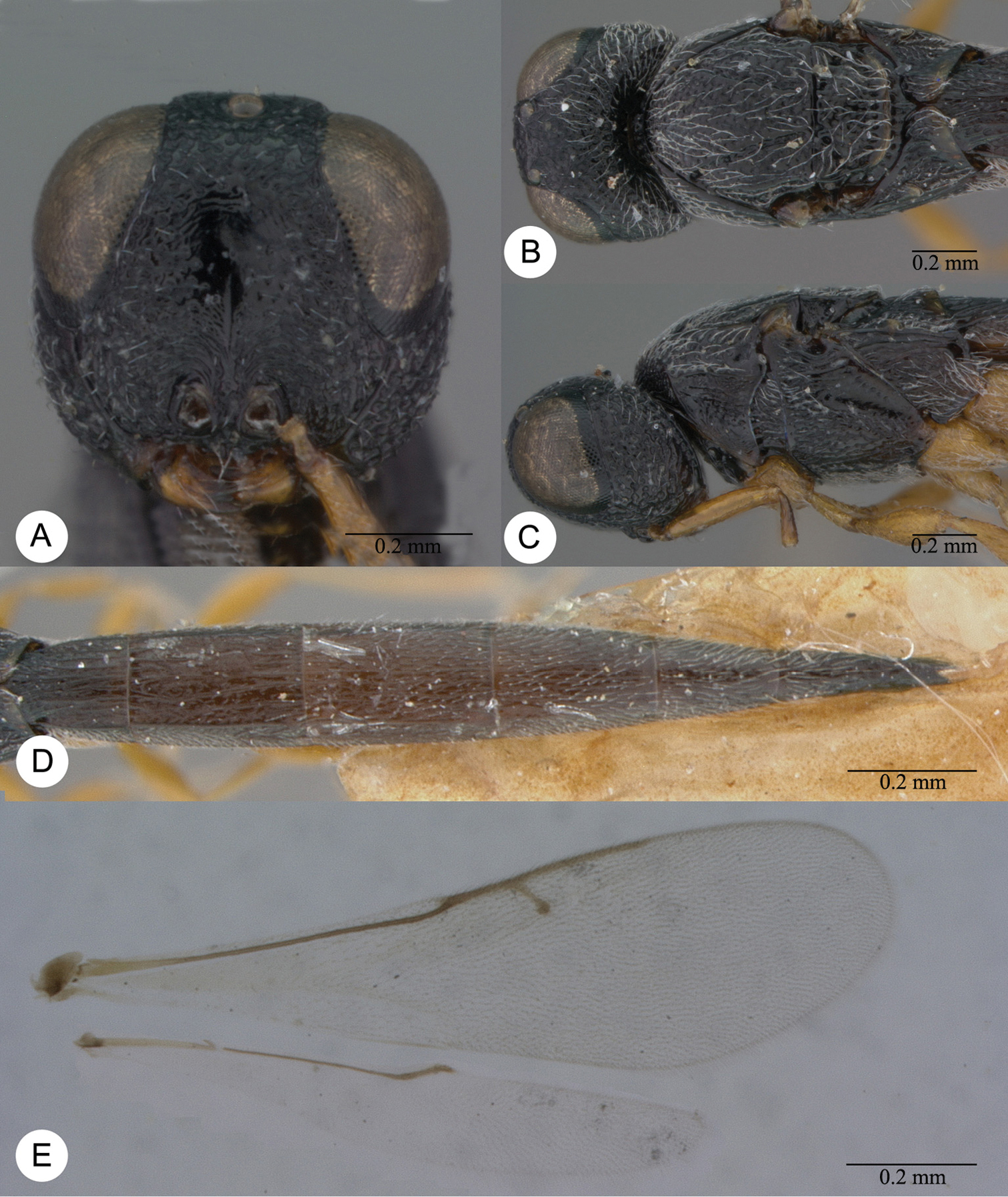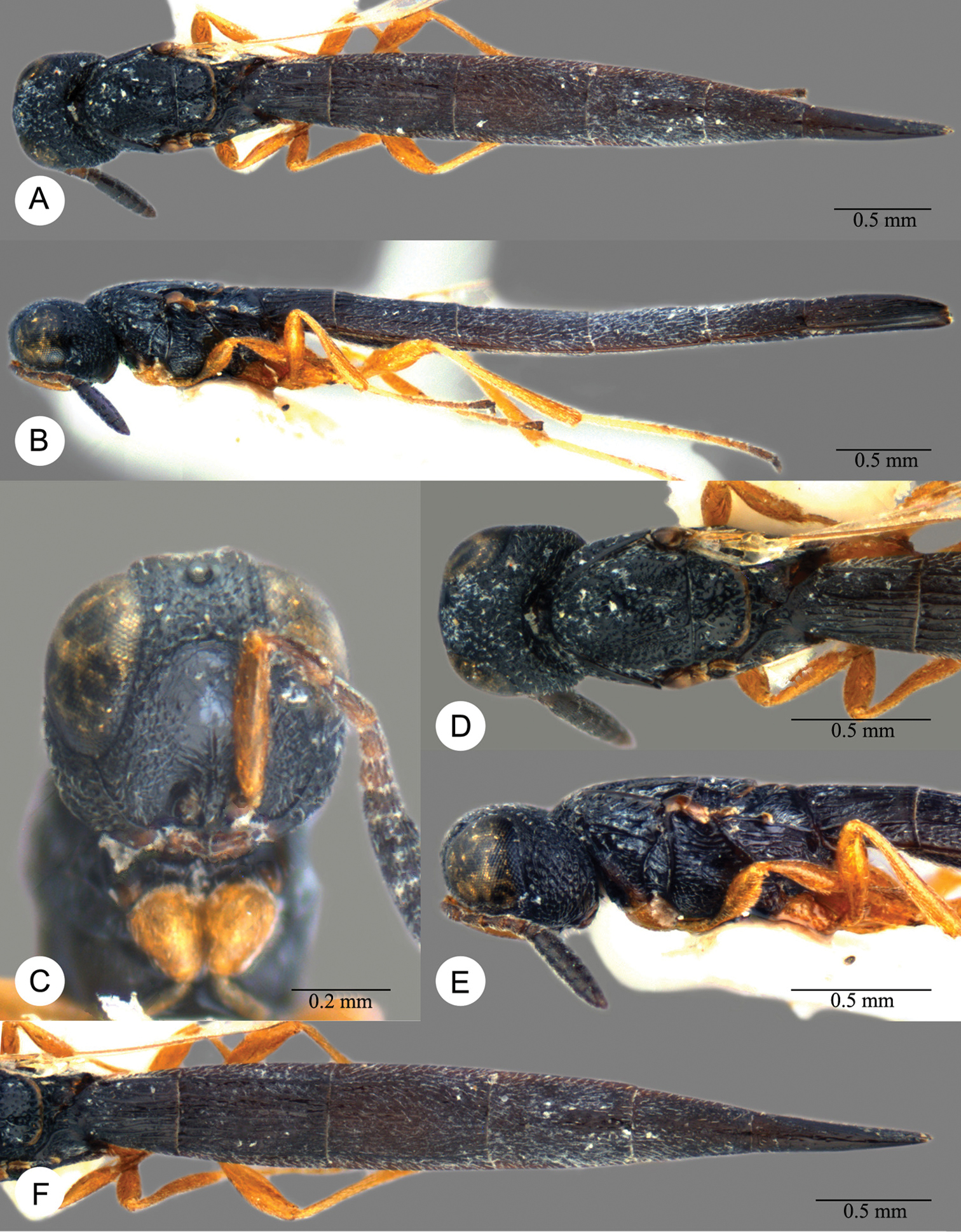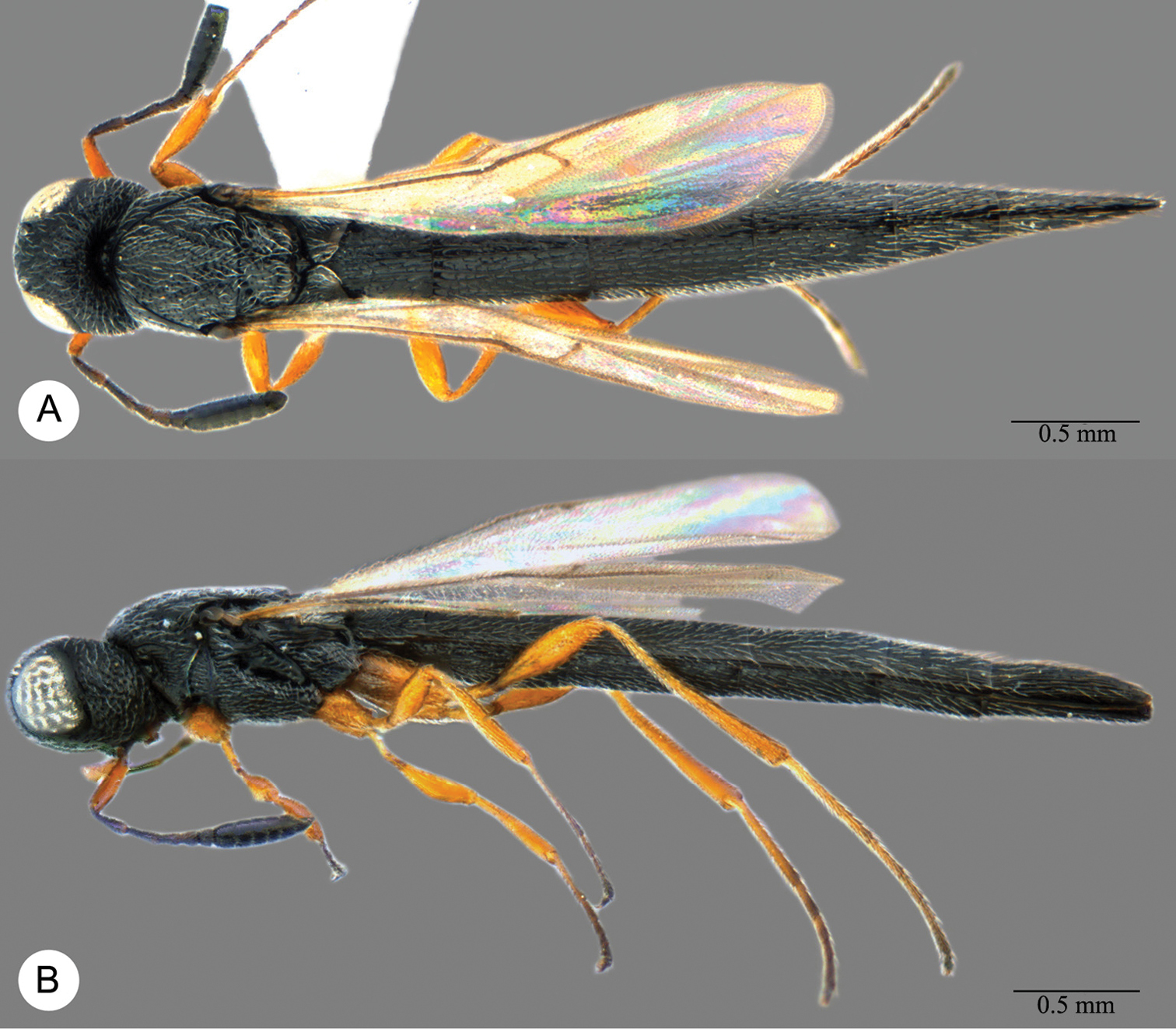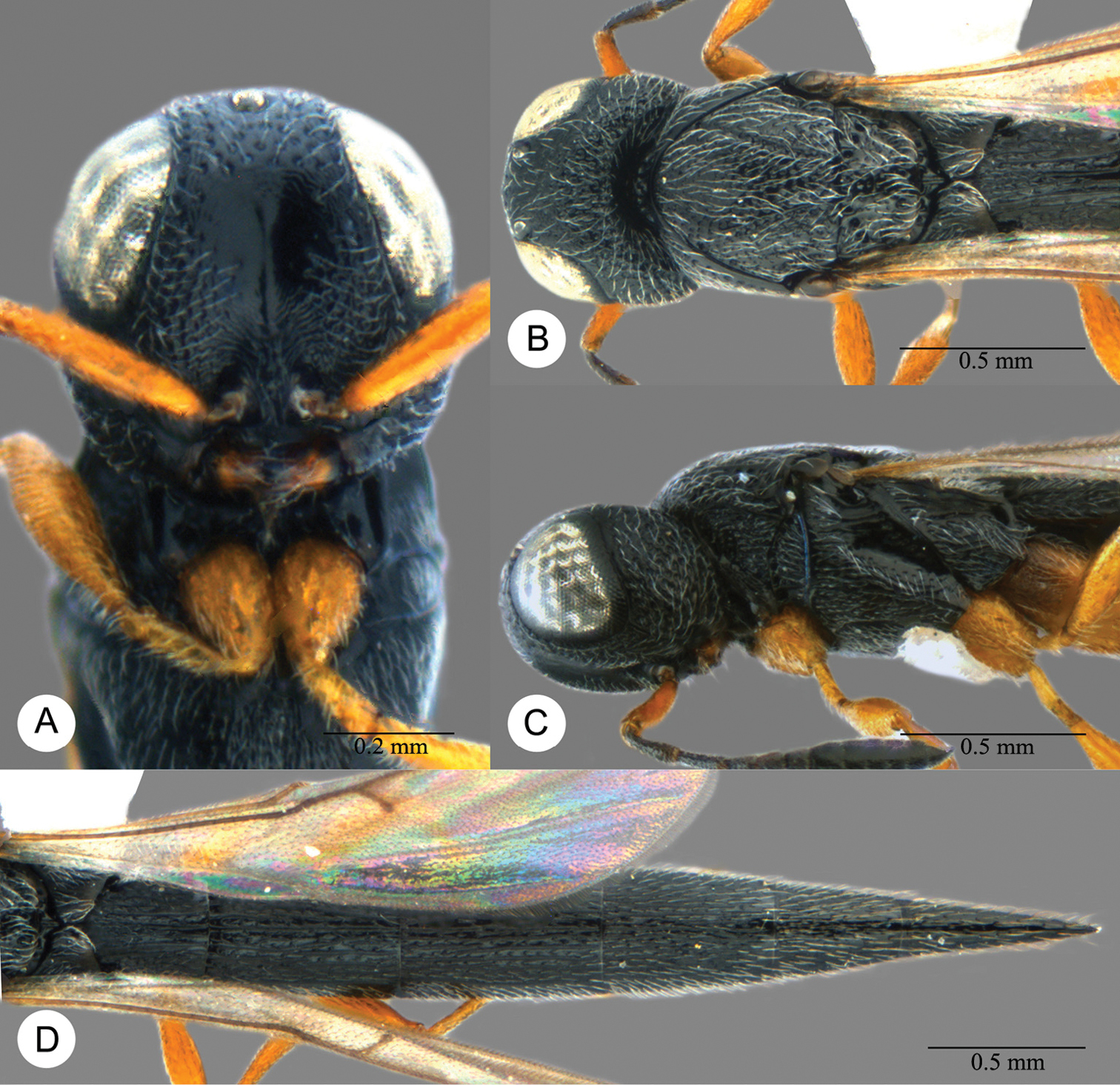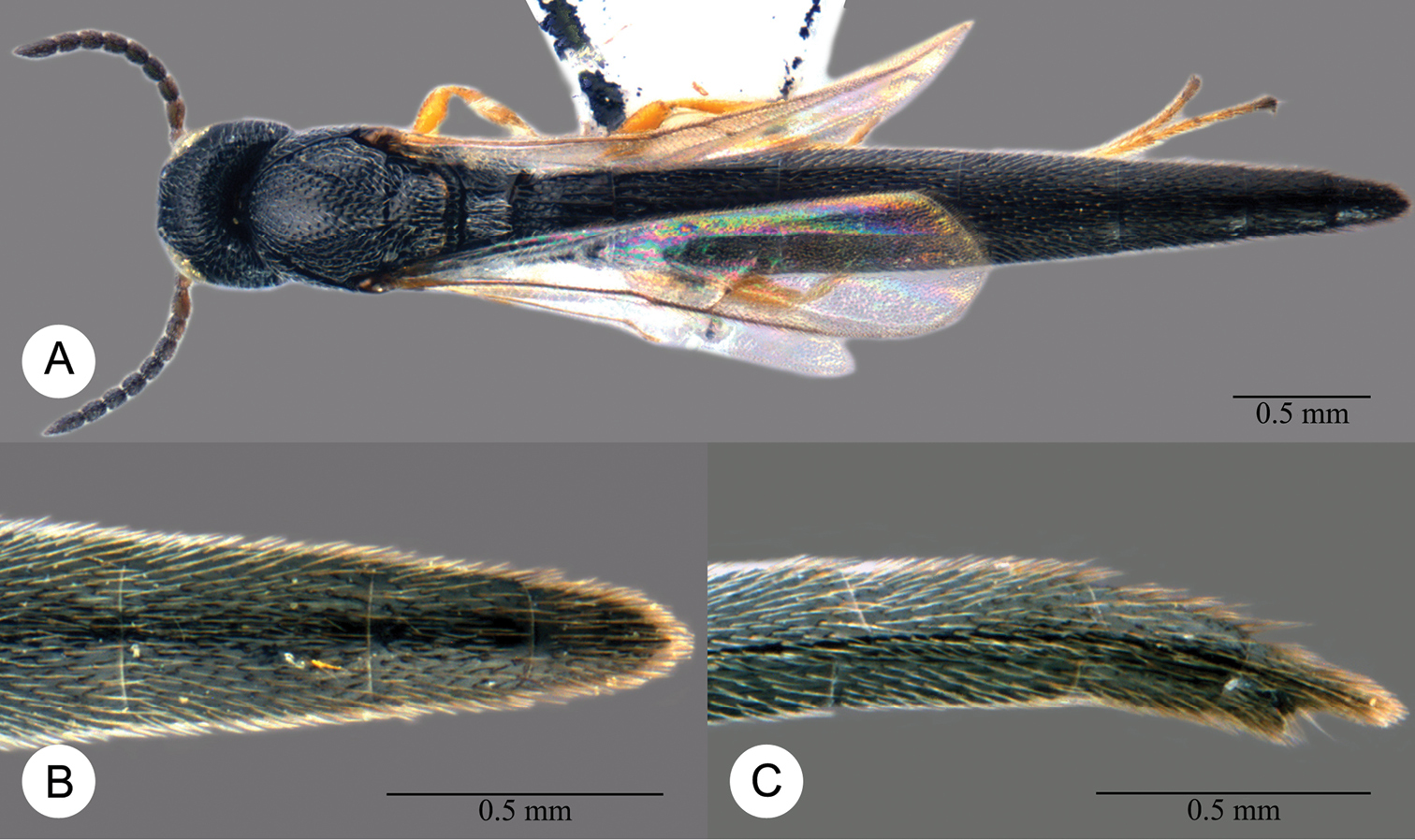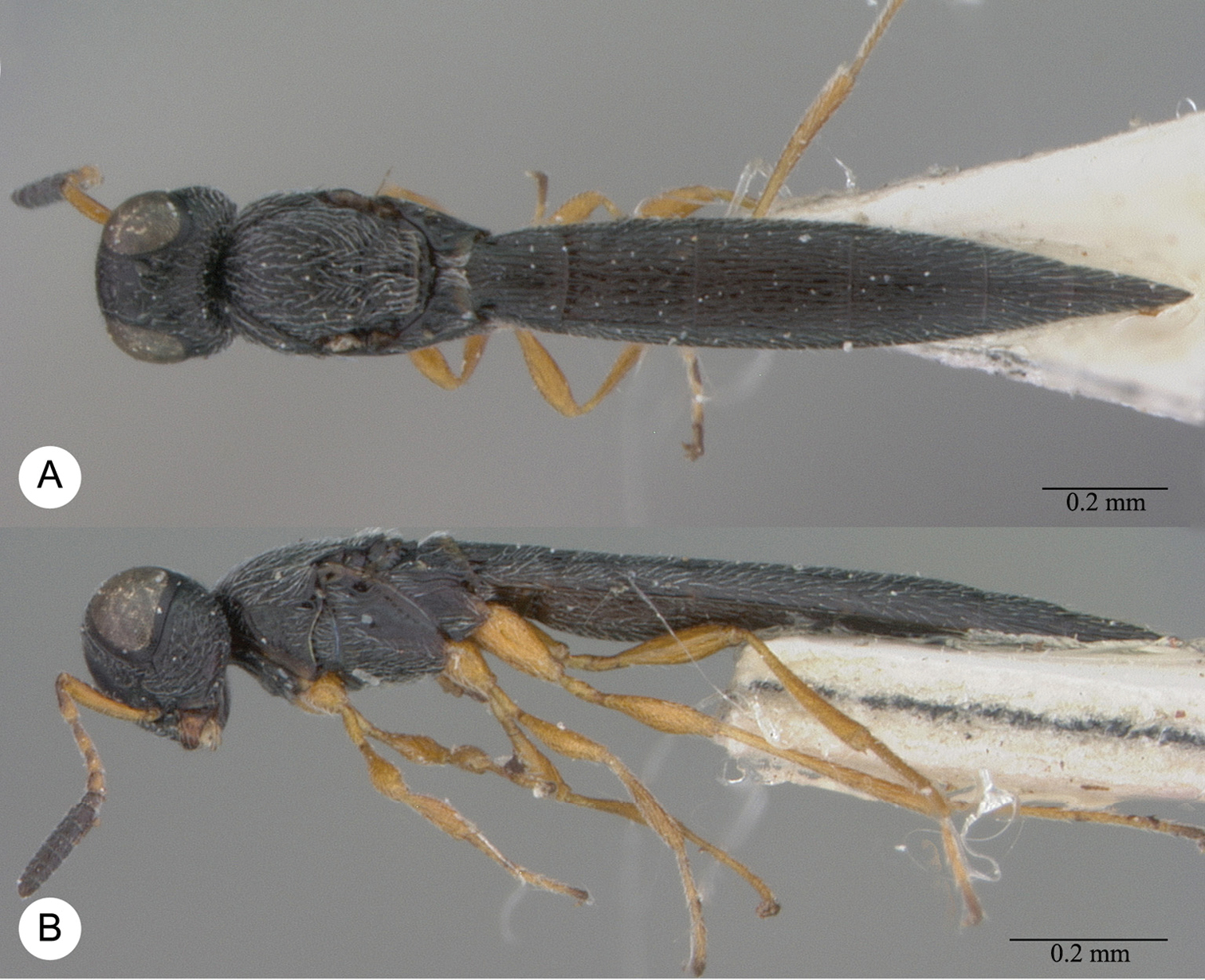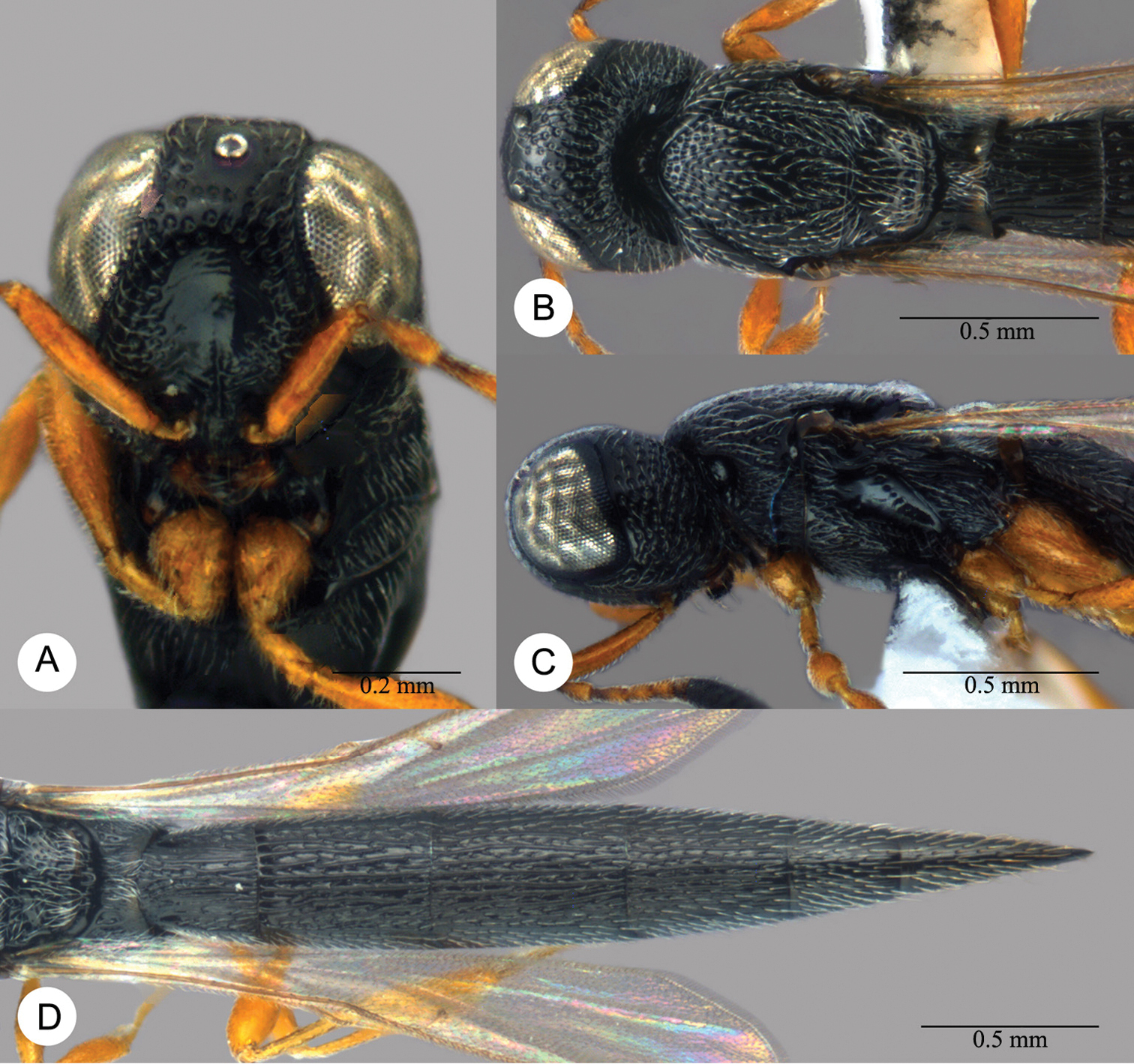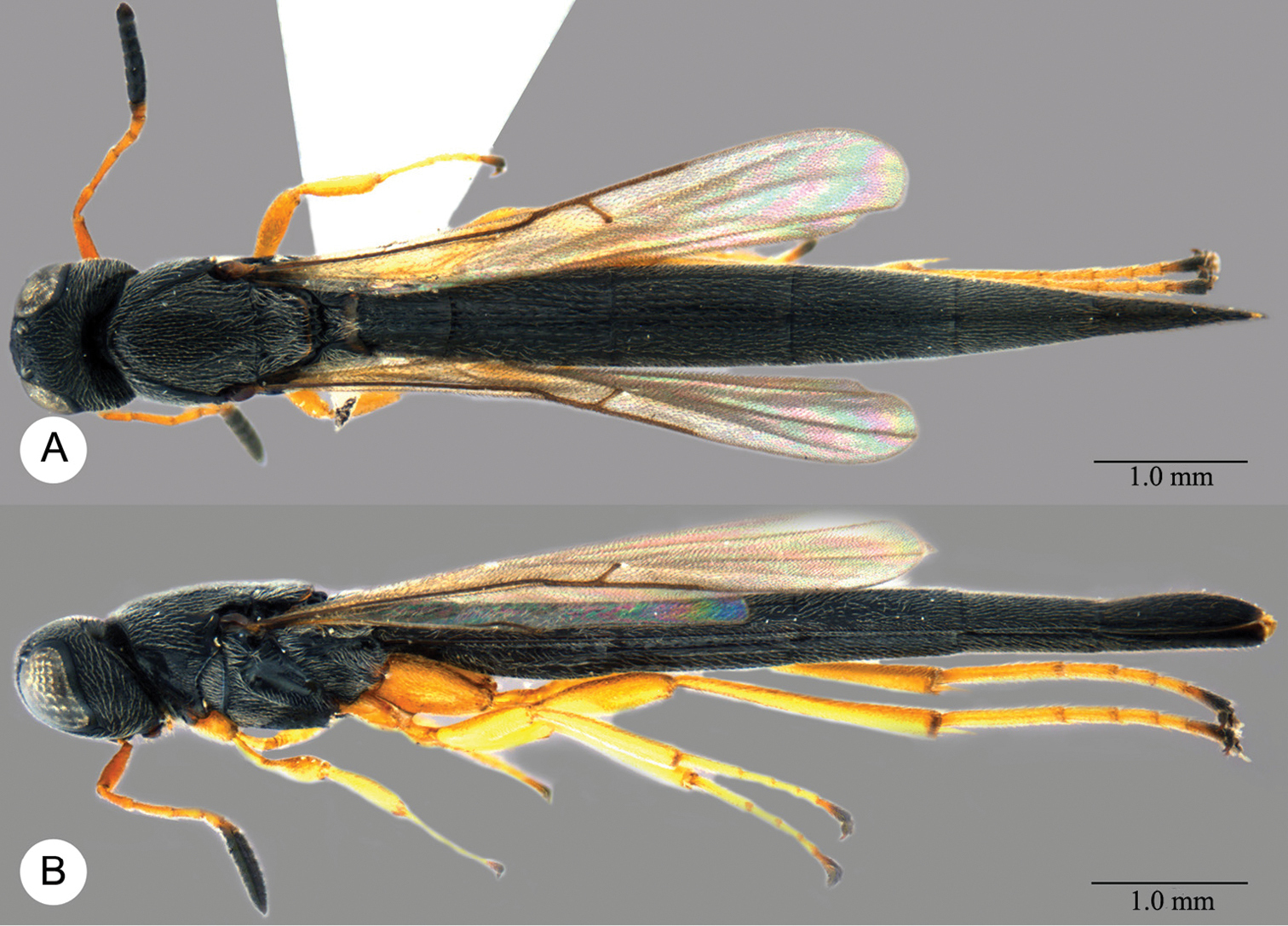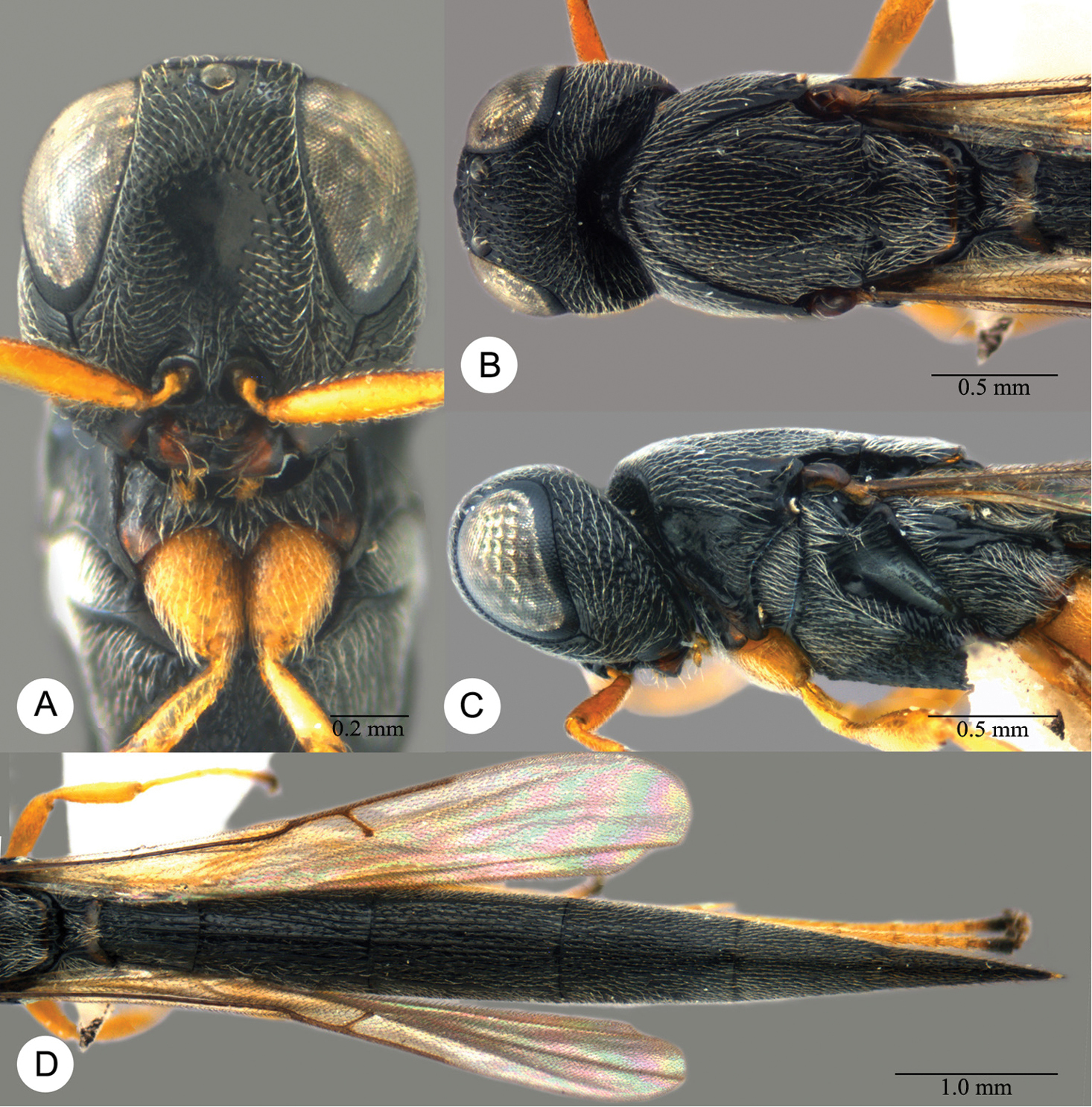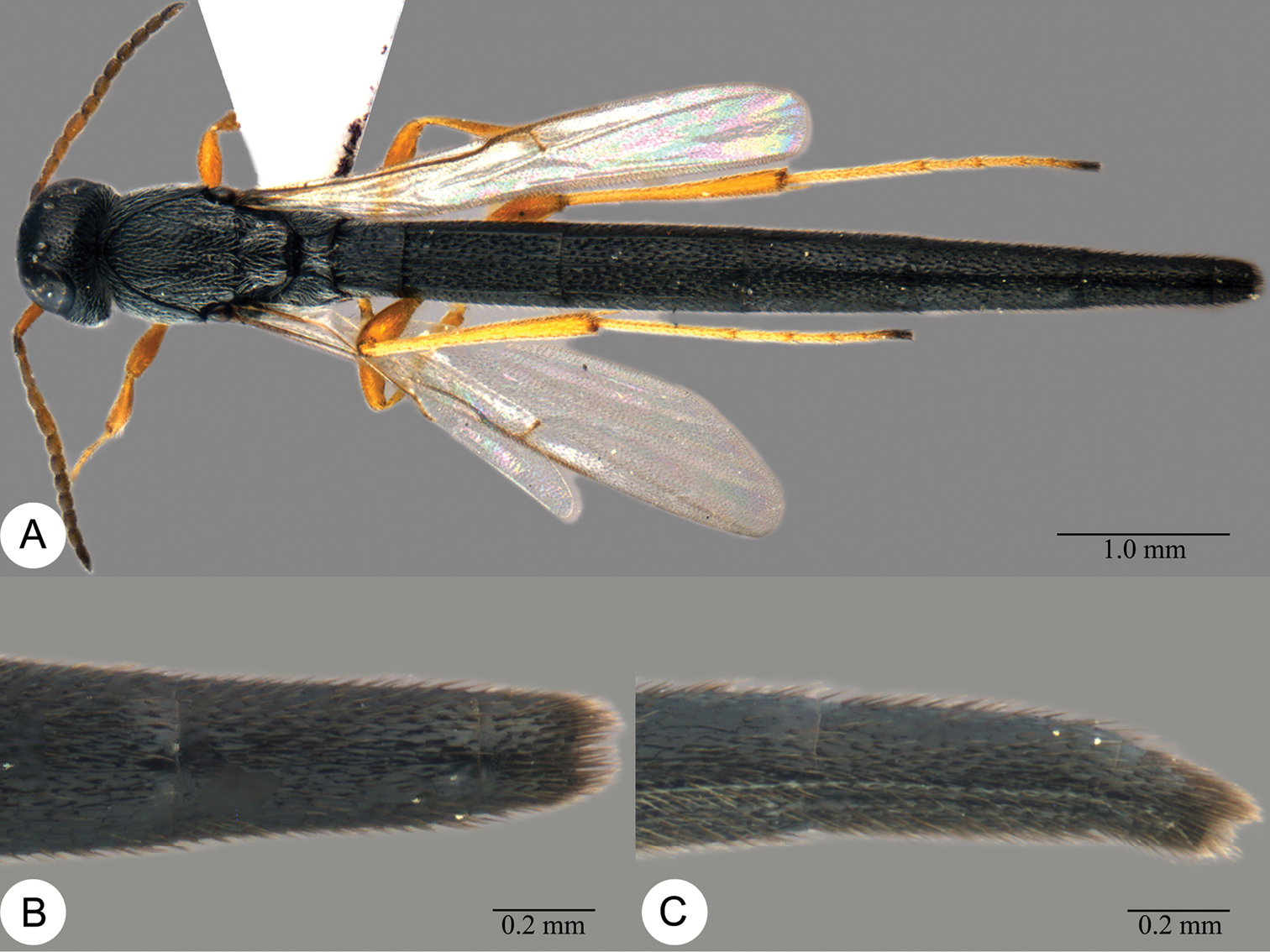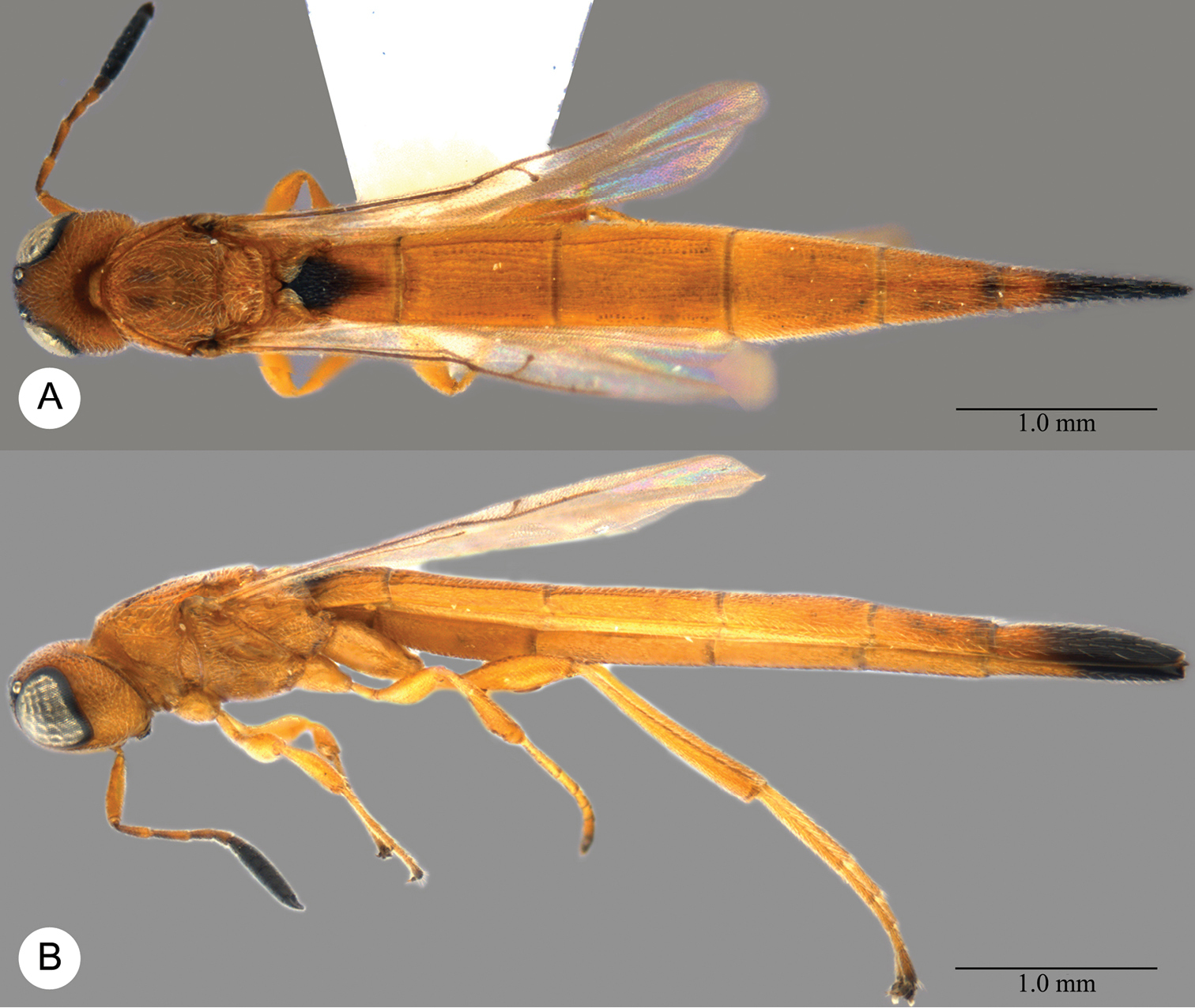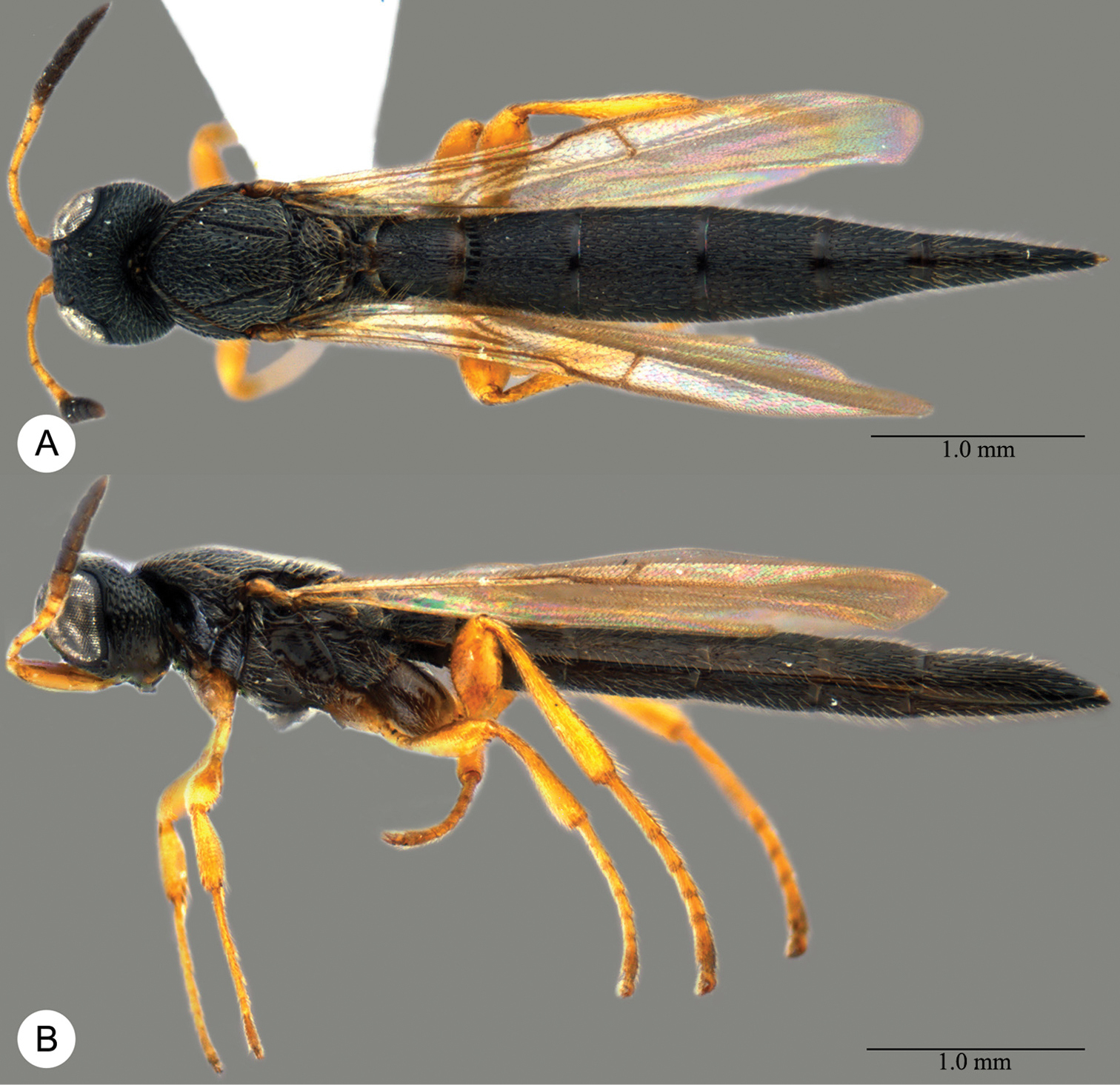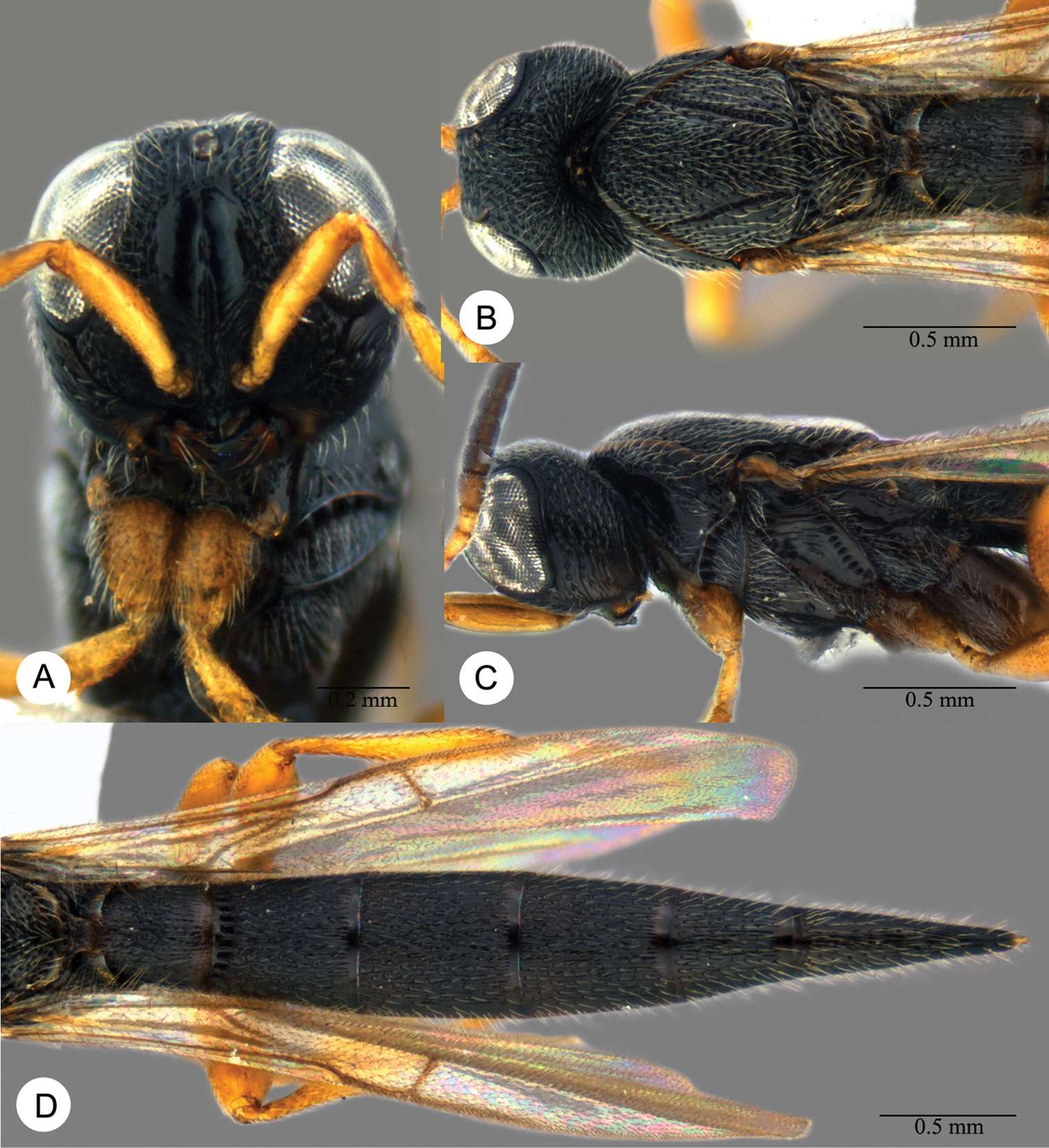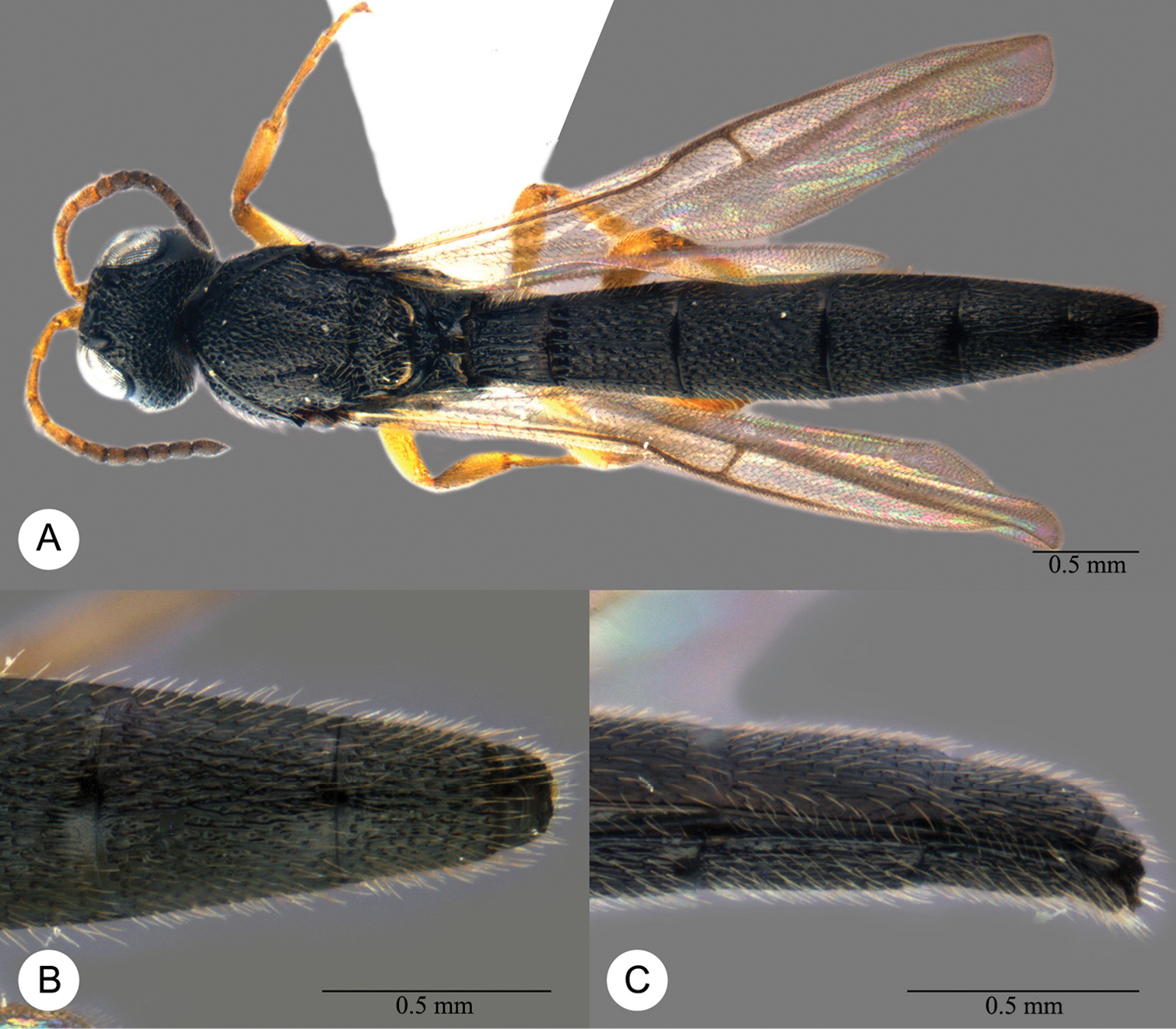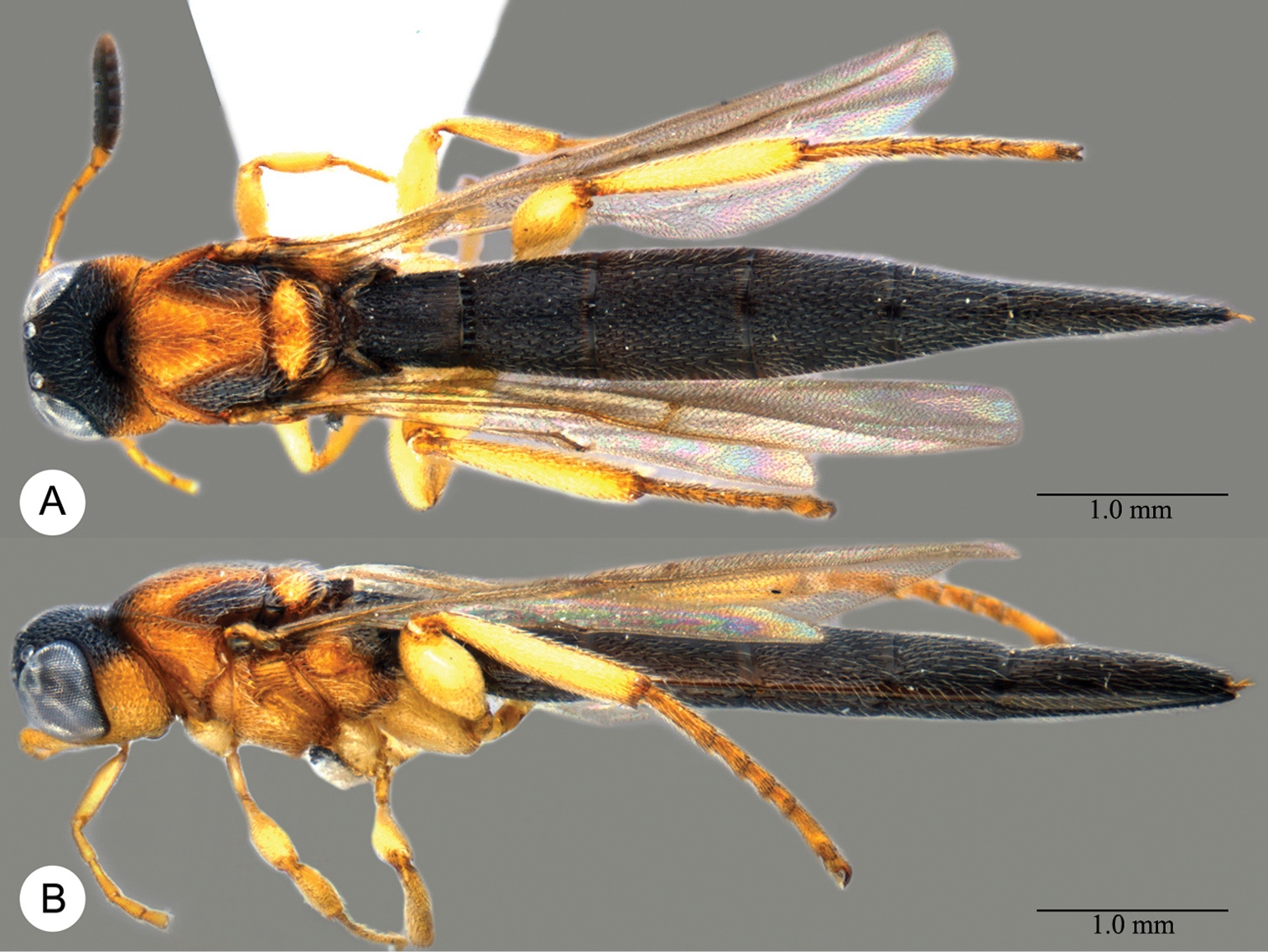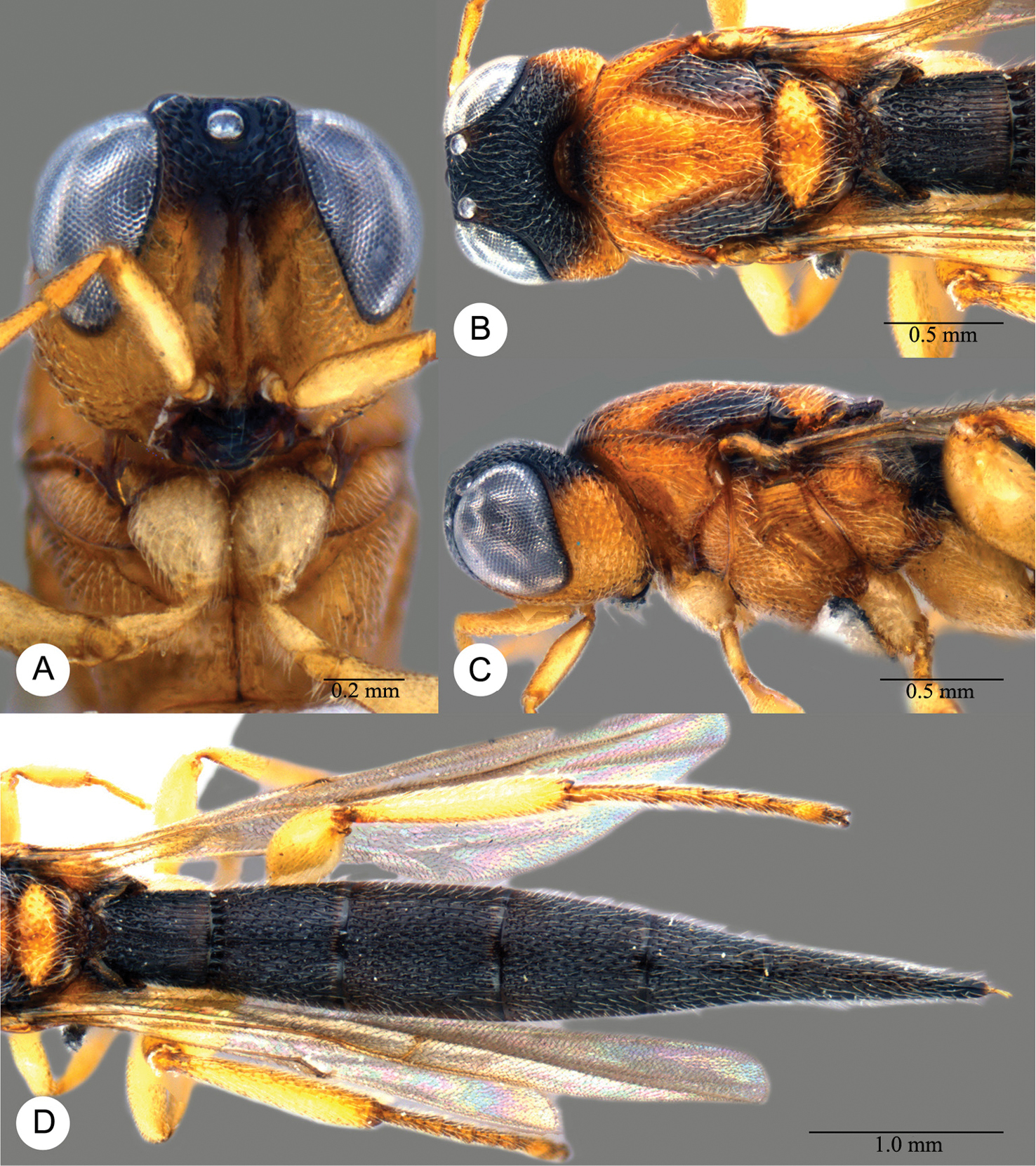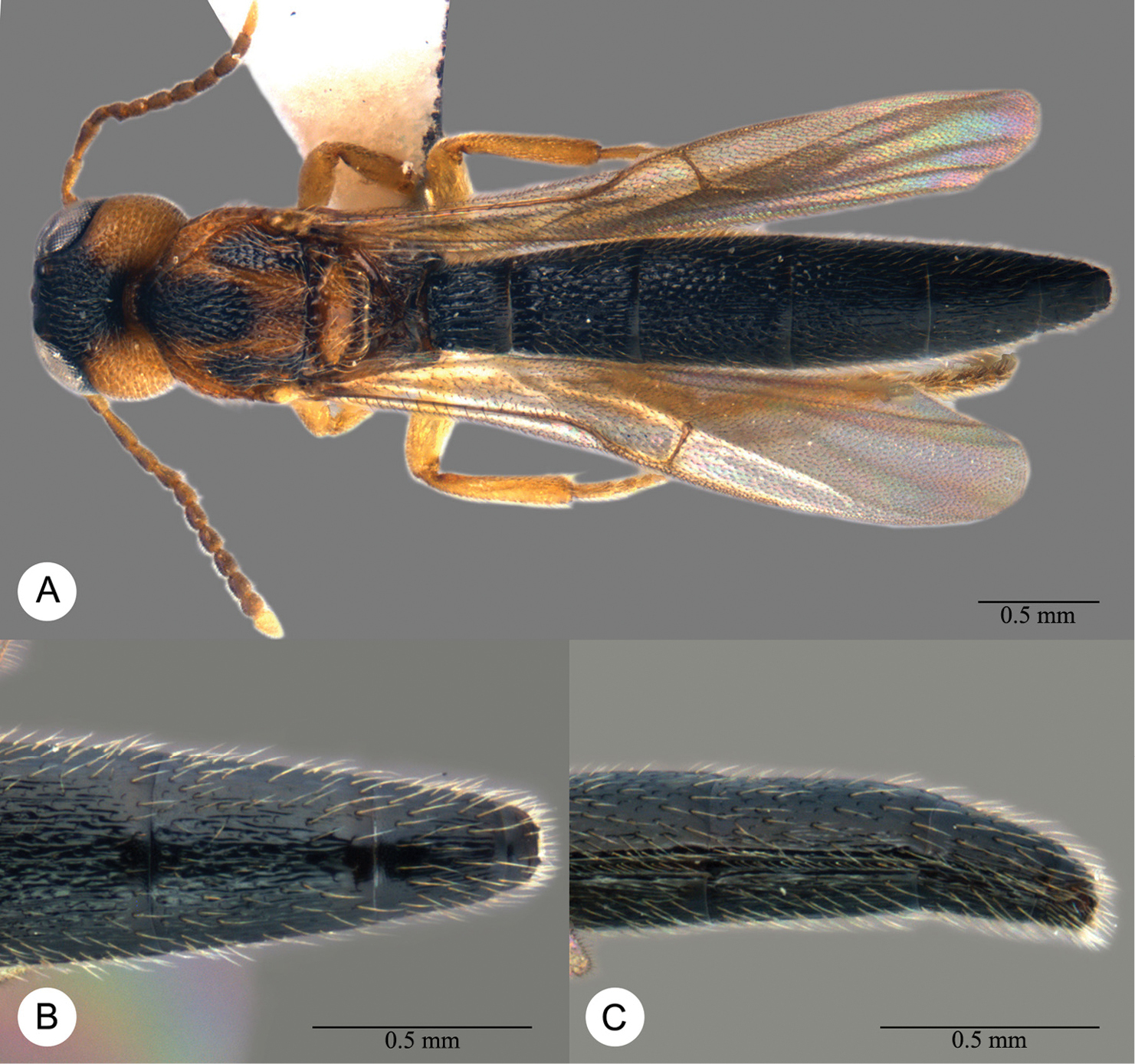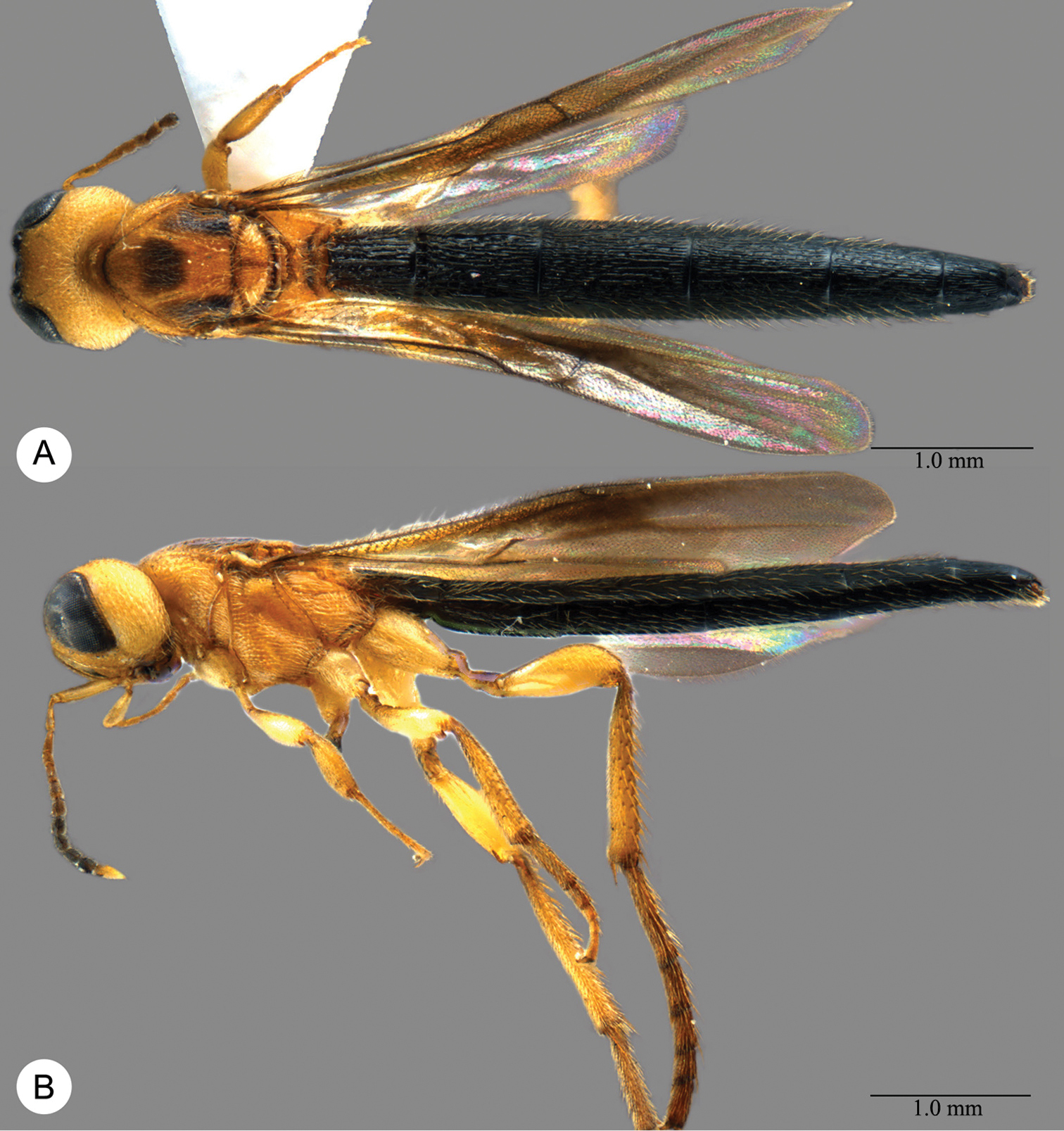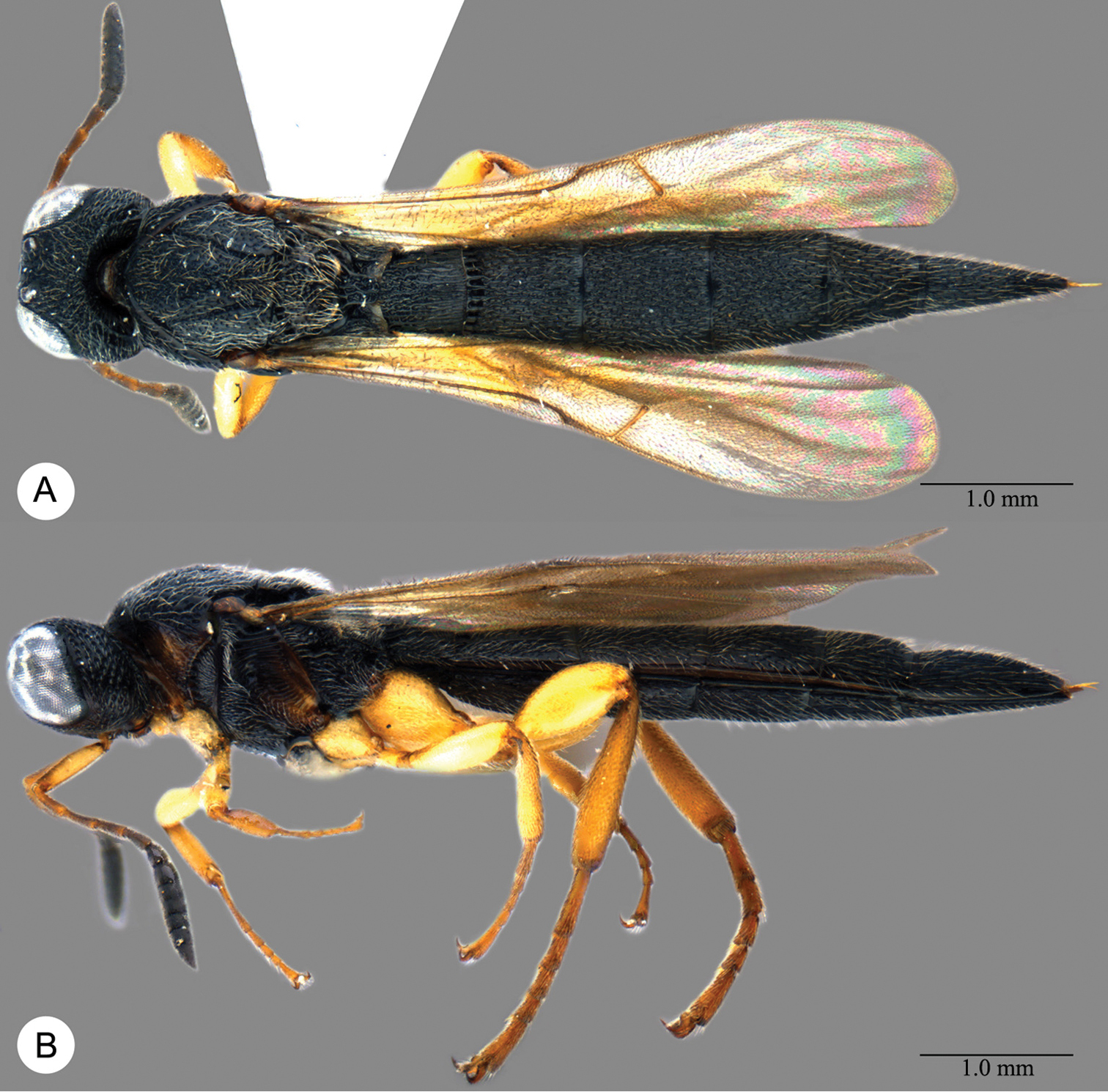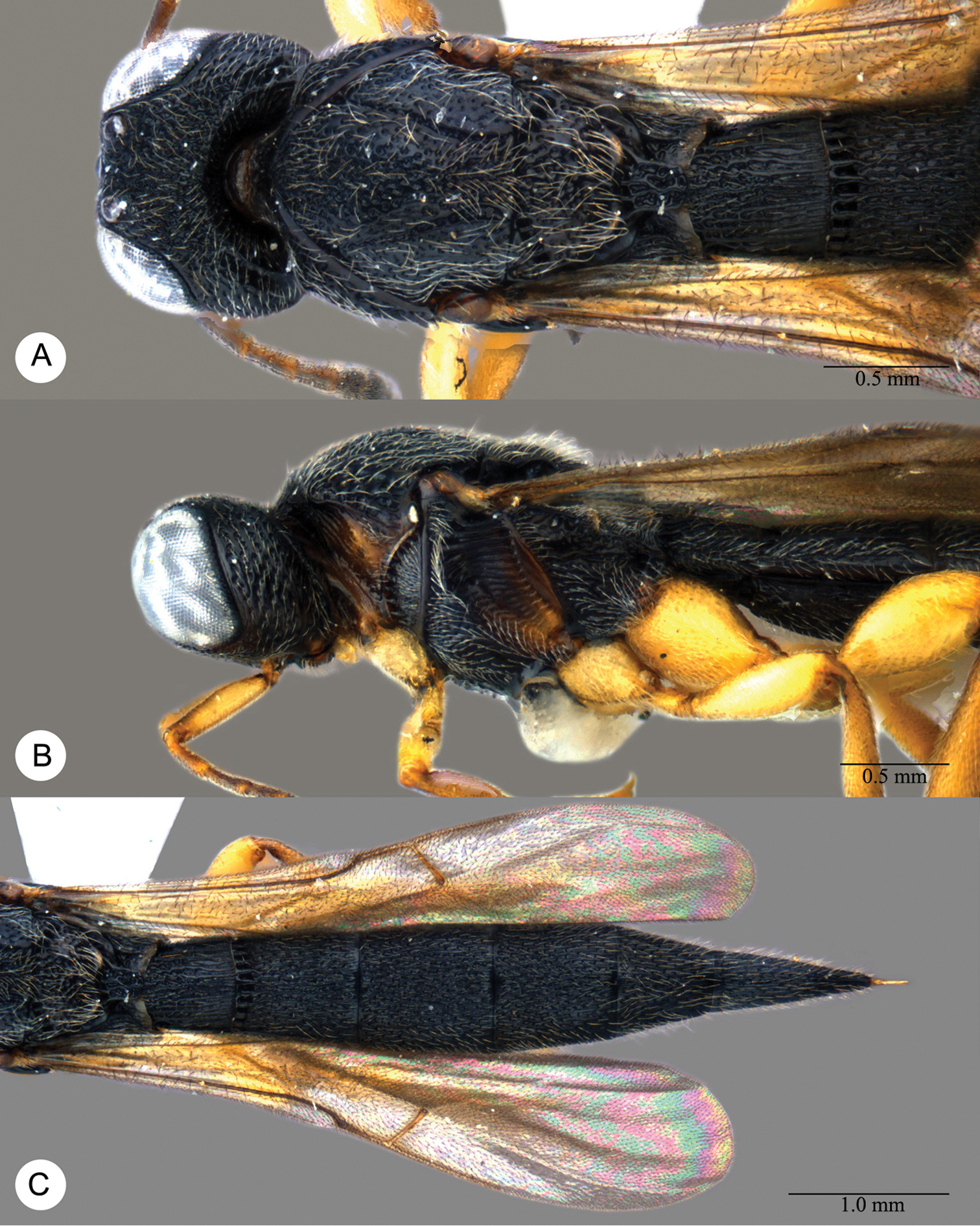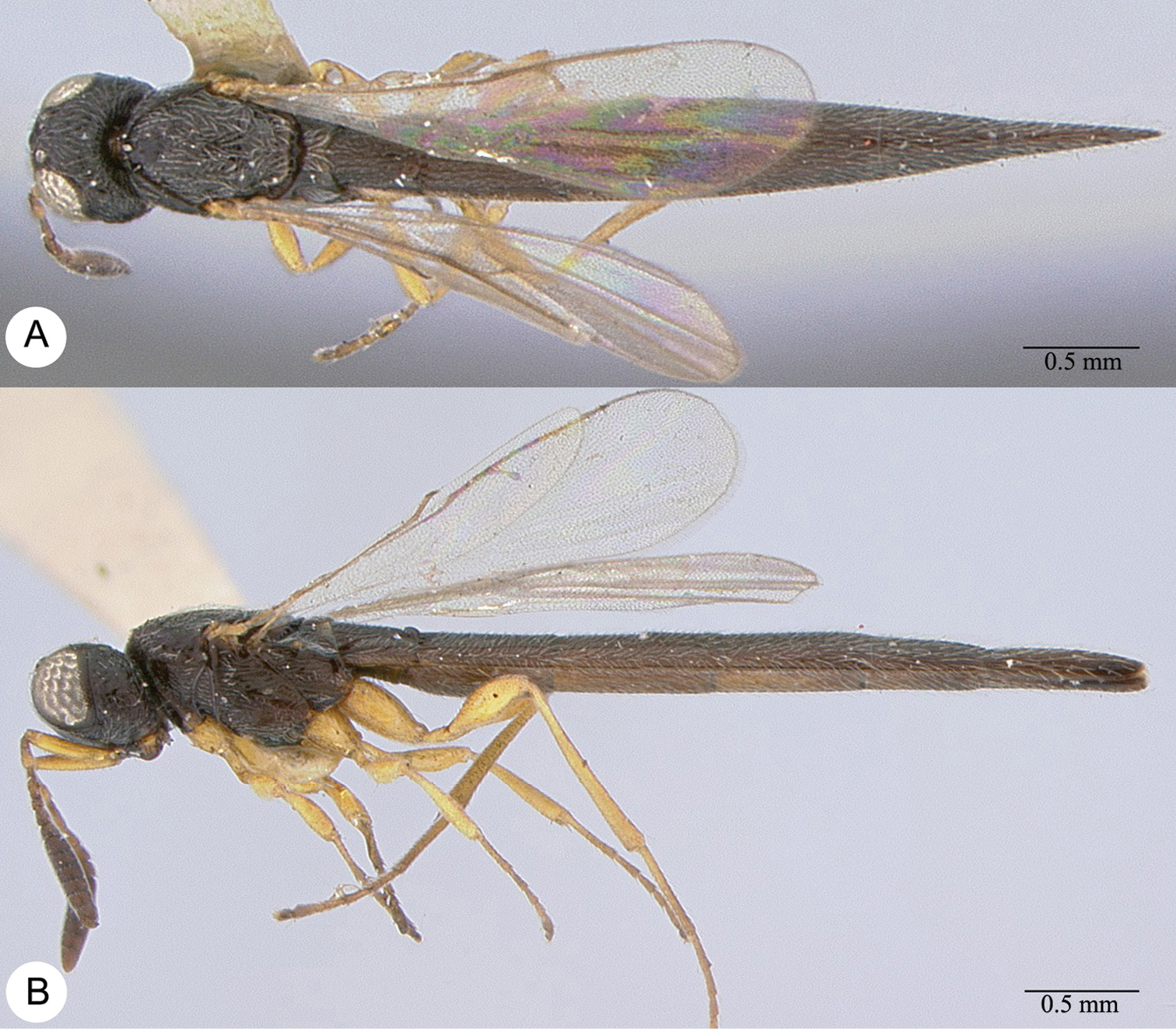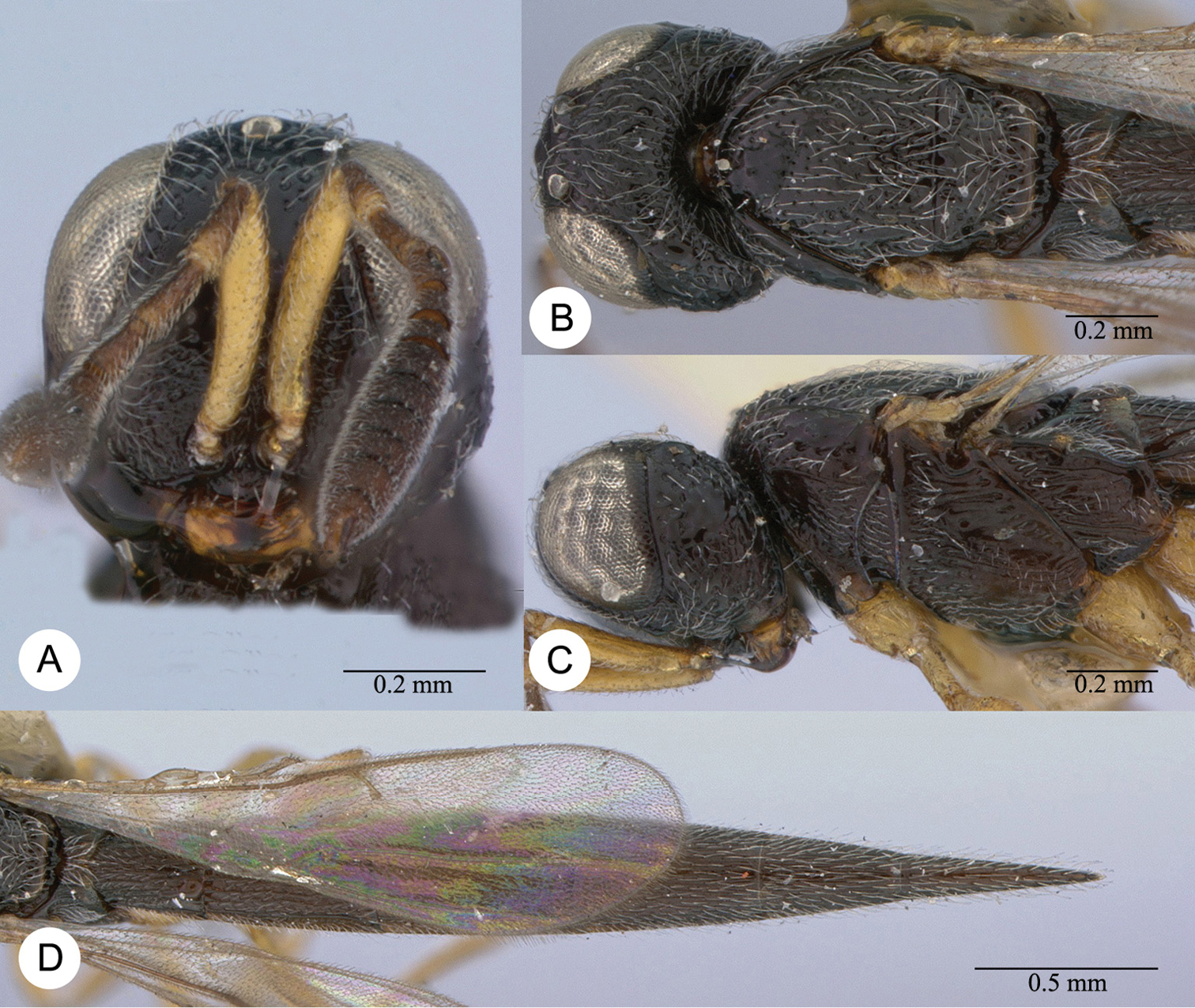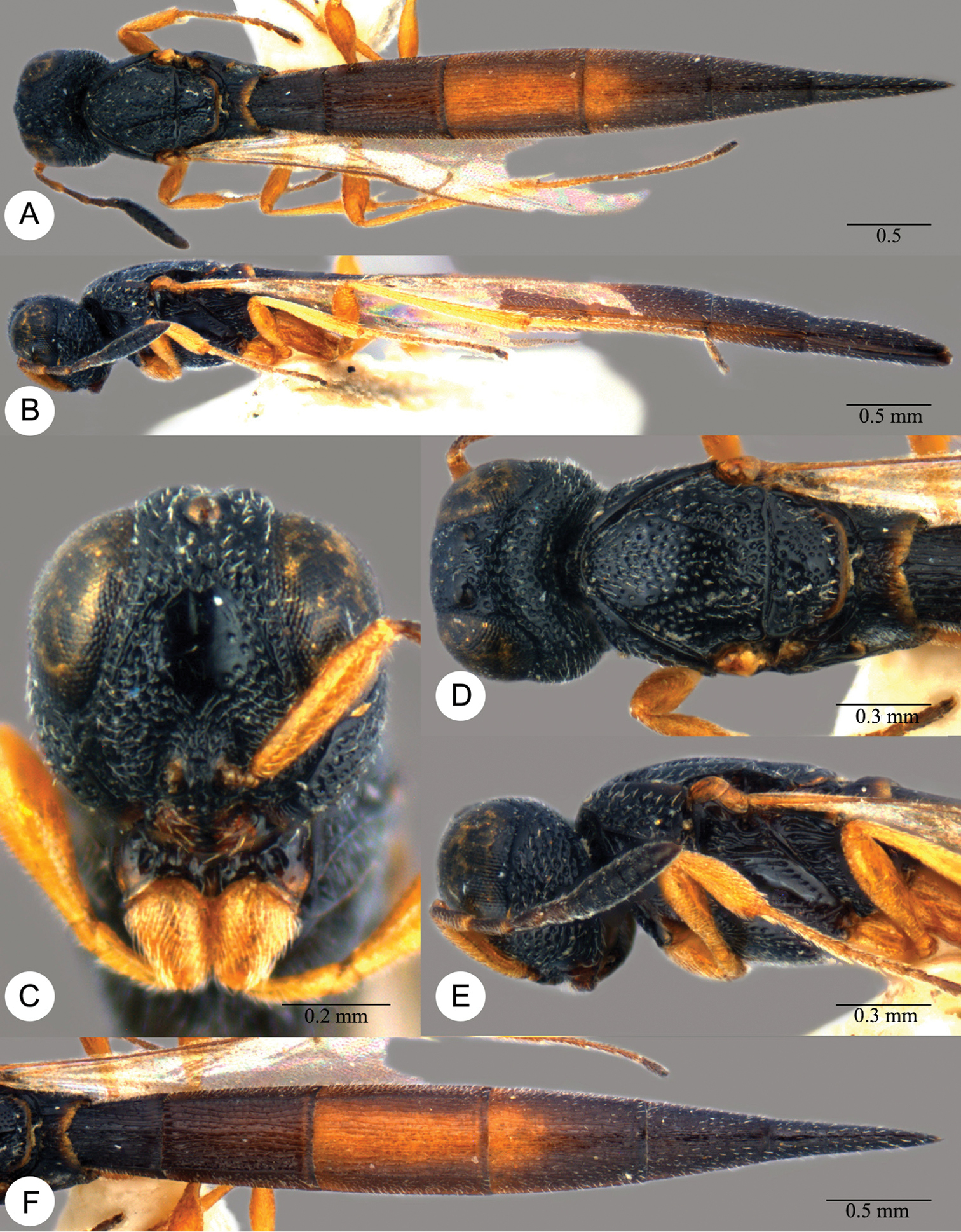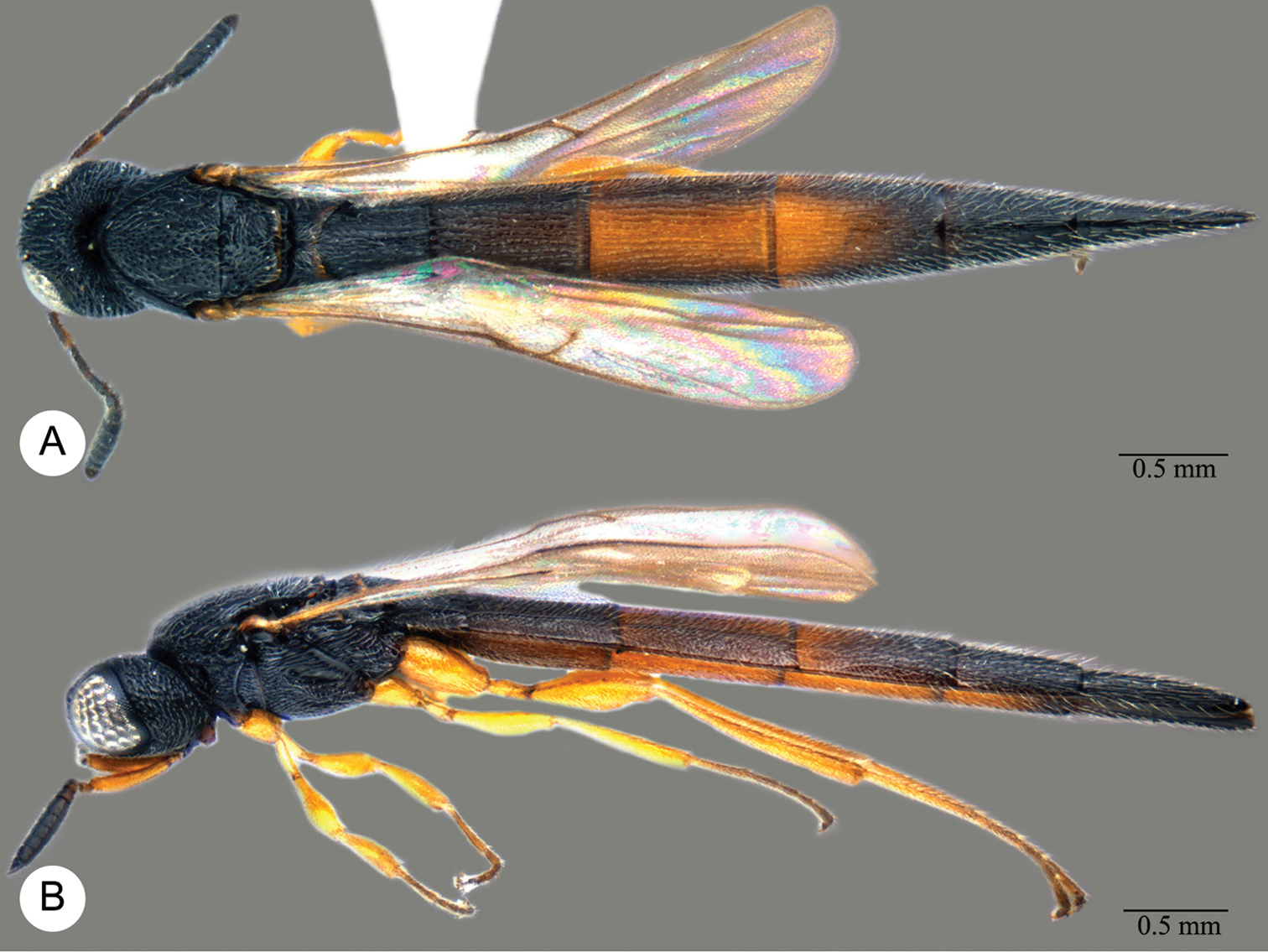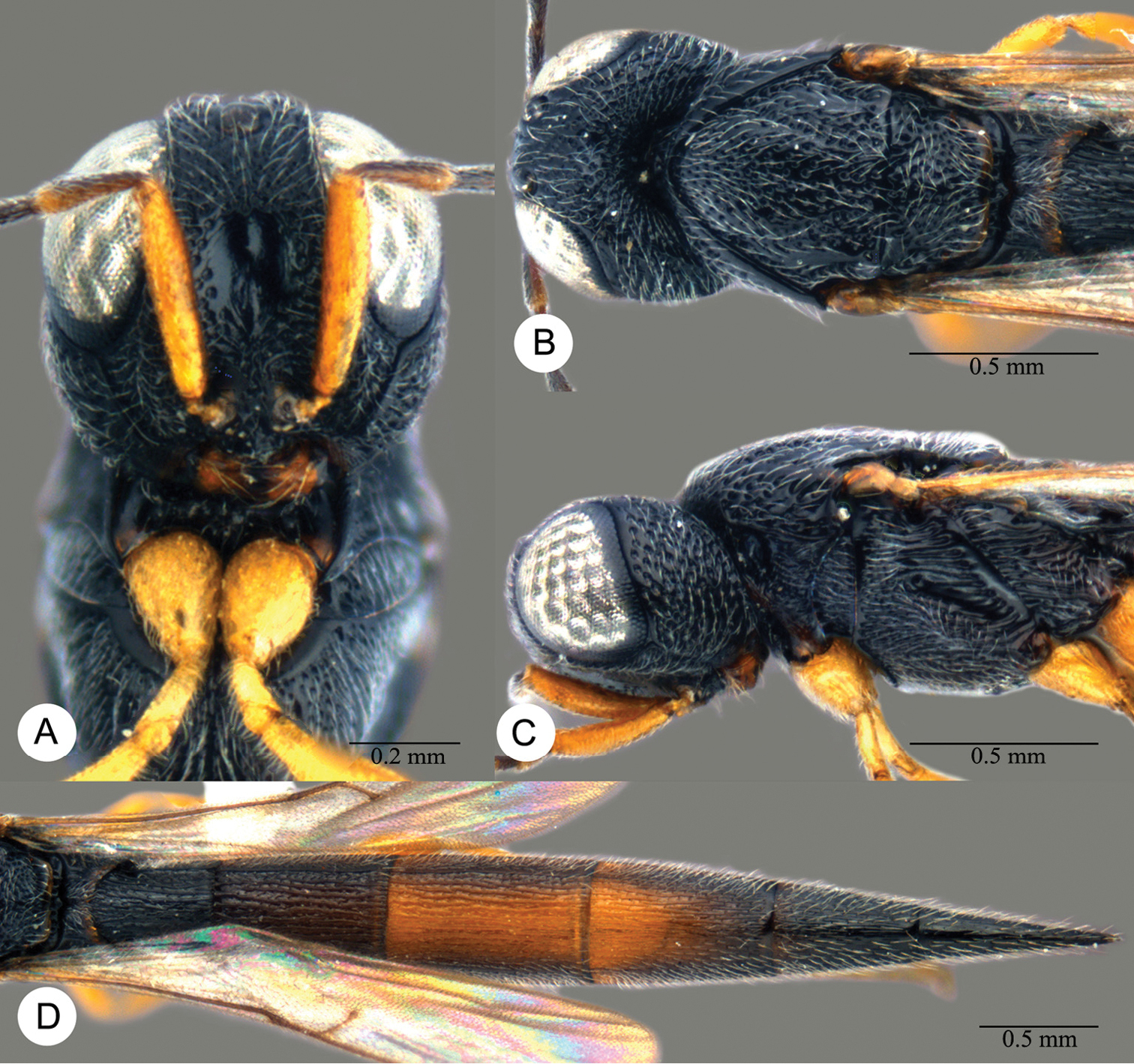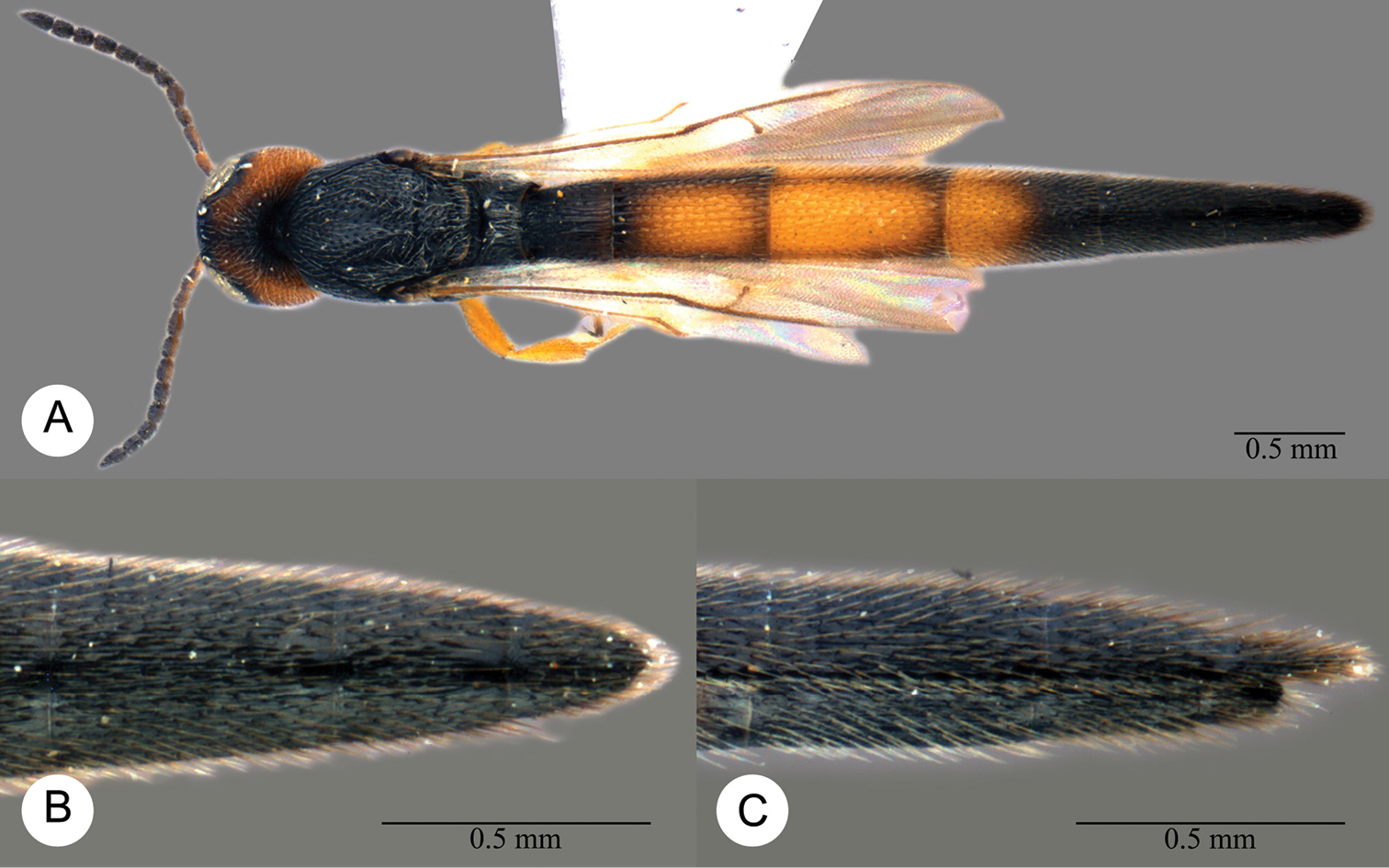






(C) 2013 Hua-yan Chen. This is an open access article distributed under the terms of the Creative Commons Attribution License 3.0 (CC-BY), which permits unrestricted use, distribution, and reproduction in any medium, provided the original author and source are credited.
For reference, use of the paginated PDF or printed version of this article is recommended.
The genus Macroteleia Westwood (Hymenoptera: Platygastridae s. l., Scelioninae) from China is revised. Seventeen species are recognized based on 502 specimens, all of which are new records for China. Seven new species are described: Macroteleia carinigena sp. n. (China), Macroteleia flava sp. n. (China), Macroteleia gracilis sp. n. (China), Macroteleia salebrosa sp. n. (China), Macroteleia semicircula sp. n. (China), Macroteleia spinitibia sp. n. (China) and Macroteleia striatipleuron sp. n. (China). Ten species are redescribed: Macroteleia boriviliensis Saraswat (China, India, Thailand), Macroteleia crawfordi Kiefer, stat. n. (China, Philippines, Thailand, Vietnam), Macroteleia dolichopa Sharma (China, India, Vietnam), Macroteleia emarginata Dodd (China, Malaysia), Macroteleia indica Saraswat & Sharma (China, India, Vietnam), Macroteleia lamba Saraswat & Sharma (China, India, Thailand, Vietnam), Macroteleia livingstoni Saraswat (China, India), Macroteleia peliades Kozlov & Lê (China, Vietnam), Macroteleia rufa Szelényi (China, Egypt, Georgia, Russia, Thailand, Ukraine) and Macroteleia striativentris Crawford (China, Philippines, Thailand, Vietnam). The following five new synonyms are proposed: Macroteleia crates Kozlov & Lê syn. n. and Macroteleia demades Kozlov & Lê syn. n. of Macroteleia crawfordi Kieffer; Macroteleia cebes Kozlov & Lê syn. n. and Macroteleia dones Kozlov & Lê syn. n. of Macroteleia indica Saraswat & Sharma; Macroteleia dores Kozlov & Lê syn. n. of Macroteleia lamba Saraswat & Sharma. A key to the Chinese species of the genus is provided.
Platygastridae s. l., Scelioninae, egg parasitoid, key
Macroteleia Westwood is a cosmopolitan genus in the subfamily Scelioninae, comprising about 131 described species worldwide (including 2 fossil species;
Available host data suggest that species of Macroteleia are parasitoids of eggs of long-horned grasshoppers (Orthoptera: Tettigoniidae). In the original description of Macroteleia virginiensis,
During recent years, we have accumulated many specimens of Platygastridae s. l. during surveys of Chinese Hymenoptera. Among them, seventeen species of Macroteleia are recognized here, of which seven species are considered to be new to science and a total of 17 species are newly recorded from China. All the Chinese Macroteleia species are described and keyed and 6 new synonyms are proposed.
This work is based upon specimens deposited in the following collections, with abbreviations used in the text: IEBR, Institute of Ecology and Biological Resources, Hanoi, Vietnam; RABC, personal collection of R. A. Beaver, Chiang Mai, Thailand; SCAU, South China Agricultural University, Guangzhou, China; USNM, National Museum of Natural History, Washington, DC.
Abbreviations and morphological terms used in text: A1, A2, ... A12 (Plate 1): antennomere 1, 2, … 12; LOL (Plate 2B): lateral ocellar line, shortest distance between inner margins of median and lateral ocelli (
Descriptions and measurements were made under a stereomicroscope (Olympus SZ61). Images were processed with a Photometrics CoolSNAP Camera attached to a stereomicroscope (Zeiss Stemi 2000-CS) and Image Pro Plus version 6.0 software and figures were post-processed with Adobe Photoshop CS3 Extended.
A Macroteleia striatipleuron sp. n., Antenna, female B Macroteleia carinigena sp. n., Antenna, male. A1, A2, ... A12: antennomeres 1–12; bs: basiconic sensillum; cv: clava; ty: tyloid.
Macroteleia striatipleuron sp. n., female. A Head, anterior view B Head, dorsal view. ck: central keel; cl: clypeus; ge: gena; LOL: lateral ocellar line; lp: labial palpus; md: mandible; mp: maxillary palpus; oc: occipital carina; OOL: ocular ocellar line; ot: ocellar triangle; POL: posterior ocellar line; vx: vertex.
Macroteleia striativentris Crawford, female. A Mesosoma, dorsal view B Mesosoma, lateral view. cpa: cervical pronotal area; dpa: dorsal pronotal area; lpa: lateral pronotal area; llm: lateral lobe of mesoscutum; lmes: lower mesepisternum; med: mesopleural depression; mep: metapleuron; mlm: middle lobe of mesoscutum; msct: metascutellum; net: netrion; not: notauli; pl: propodeal lobe; umes: upper mesepisternum.
http://species-id.net/wiki/Macroteleia
Macroteleia is known as one of the longest and often the largest wasps in the subfamily Scelioninae. It may be distinguished from other genera of the subfamily by the combination of the following characters: marginal vein (R) distinctly elongate, as long as or longer than stigmal vein (r-rs) (Plate 4); propodeum without armature, divided into two separated halves (Plates 14B, 16D, 17D, 37B, 38D, 40B, 52B, 54B, 57B, 63B) or continuous medially (Plates 3A, 18D, 20B, 23B, 25D, 31D, 32C, 34B, 43B, 45B, 49B, 65B, 66D, 68B); wings hyaline or subhyaline (Plate 4), rarely with infuscations or darkening (Plate 60D); T6 in females strongly compressed laterally to form a wedge (Plate 5B); apex of T7 in males differentiated, truncate (Plates 6A, 8D, 10D, 12D, 35B, 47F, 50B, 55B, 58B, 61B) or excavate medially in New World species, pointed medially (Plates 6C, 15B, 21B, 24B, 26B, 28E, 41B, 46B, 69B) or cut off in Old World species, but never bidentate or bispinose (
Macroteleia striativentris Crawford, fore and hind wing, female. R: marginal vein; R1: postmarginal vein; r-rs: stigmal vein.
Macroteleia striativentris Crawford, female. A Metasoma, dorsal view B Metasoma, lateral view C Metasoma, ventral view. lmc: longitudinal median sternal carina; S1, S2, … S6: metasomal sternite 1–6; stc, sublateral tergal carina; trs: transverse sulcus of T2; T1, T2, ... T6: metasomal terga 1–6.
A Macroteleia boriviliensis Saraswat, male, metasoma, dorsal view B Macroteleia boriviliensis Saraswat, male, metasoma, lateral view C Macroteleia striativentris Crawford, male, metasoma, dorsal view D Macroteleia striativentris Crawford, male, metasoma, lateral view. S7: metasomal sternite 7; T7: metasomal tergite 7.
Macroteleia is mostly similar to Triteleia that found in China both in size and body shape.
Key to separate Macroteleia, Triteleia and Habroteleia
| 1 | Postmarginal vein in fore wing absent; female ovipositor Ceratobaeus-type | Habroteleia Kieffer |
| – | Postmarginal vein in fore wing well developed, distinctly longer than stigma vein (r-rs); female ovipositor Scelio-type | 2 |
| 2 | Female T6 strongly compressed, wedge like; male apical tergite apically emarginated or with 1 central spine but never bispinose | Macroteleia Westwood |
| – | T6 flatly triangular, not compressed; male apical tergite with postero-lateral corners bispinose or at least pointed | Triteleia Kieffer |
Females
(Unknown for Macroteleia carinigena, Macroteleia gracilis, Macroteleia boriviliensis and Macroteleia spinitibia)
| 1 | Propodeum divided into two separated subtriangular lobes (Plates 14B, 16D, 17D, 37B, 38D, 40B, 52B, 54B, 57B, 63B) | 2 |
| – | Propodeum continuous medially, not divided into two separated lobes (Plates 3A, 18D, 20B, 23B, 25D, 31D, 32C, 34B, 43B, 45B, 49B, 65B, 66D, 68B) | 7 |
| 2 | Head and mesosoma variably yellow to dark brown or orange (Plates 52B, 57B) | 3 |
| – | Head and mesosoma entirely black (Plates 14B, 37B, 38D, 40B, 54B, 65B, 66D, 68B) | 4 |
| 3 | Metascutellum triangular, strongly produced medially (Plate 52B); central keel weakly developed above interantennal process (Plate 52A) | Macroteleia rufa Szelényi |
| – | Metascutellum semicircular (Plate 57B); central keel well developed, extending onto interantennal process, slightly bifurcating dorsally (Plate 57A) | Macroteleia semicircula sp. n. |
| 4 | Central keel well developed, extending onto interantennal process (Plates 2A, 54A); legs robust, hind femur strongly swollen (Plates 53B, 62B) | 5 |
| – | Central keel weakly developed above interantennal process (Plates 14A, 37A, 38C, 40A); legs slender, hind femur weakly swollen (Plates 13B, 17B, 36B, 38B, 39B) | 6 |
| 5 | Mesopleural depression smooth (Plate 54C); occipital carina interrupted medially (Plate 54B); hind coxa dark brown to nearly black (Plate 54C) | Macroteleia salebrosa sp. n. |
| – | Mesopleural depression longitudinally striate (Plate 63B); occipital carina continuous medially (Plate 2B); hind coxa yellow (Plate 63B) | Macroteleia striatipleuron sp. n. |
| 6 | Metascutellum tongue-like (Plates 14B, 16D, 17D); metapleuron longitudinally striate dorsally, densely punctate ventrally (Plates 14C, 16E, 17E) | Macroteleia crawfordi Kieffer |
| – | Metascutellum triangular, strongly produced medially (Plates 37B, 38D, 40B); metapleuron longitudinally striate throughout (Plates 37C, 40C) | Macroteleia lamba Saraswat & Sharma |
| 7 | Head yellow or orange (Plates 25D, 29D, 31D, 32C, 34B) | 8 |
| – | Head entirely black (Plates 18D, 20B, 23B, 43B, 45B, 49B, 65B, 66D, 68B) | 9 |
| 8 | Length of T3 1.11–1.39× length of T6; T5 distinctly wider than long (Plates 30C, 31F, 34D); apex of fore wing extending from as far as mid-length of T5 to base of T6 | Macroteleia indica Saraswat & Sharma |
| – | Length of T3 0.93–0.99× length of T6; T5 distinctly longer than wide (Plate 25F); apex of fore wing extending as far as posterior third of T4 | Macroteleia flava sp. n. |
| 9 | Metasoma mixed brown and black (Plates 18D, 20D, 65D, 66F, 68D) | 10 |
| – | Metasoma entirely black (Plates 23D, 43D, 45D, 49D) | 11 |
| 10 | Frons below median ocellus and vertex densely punctate (Plates 65A, 65B, 66C, 66D, 68A, 68B); metapleuron longitudinally striate (Plates 65C, 66E, 68C); mesosoma black (Plates 65B, 66D, 68B) | Macroteleia striativentris Crawford |
| – | Frons below median ocellus and posterior vertex punctate reticulate (Plates 18C, 18D, 20A, 20B); metapleuron longitudinally striate dorsally, punctate rugulose ventrally (Plate 20C); mesosoma orange (Plates 18D, 20B) | Macroteleia dolichopa Sharma |
| 11 | Ocellar triangle densely punctate; lower mesepisternum densely punctate to punctate rugulose; posterior margin of transverse sulcus on T2 straight (Plate 49D) | Macroteleia peliades Kozlov & Lê |
| – | Ocellar triangle largely smooth, with scattered punctures; lower mesepisternum variably smooth to punctate rugulose; posterior margin of transverse sulcus on T2 convex (Plates 23D, 43D, 45D) | 12 |
| 12 | Gena punctate rugose; body length 5.48–6.14 mm | Macroteleia emarginata Dodd |
| – | Gena punctate reticulate; body length 3.28–4.08 mm | Macroteleia livingstoni Saraswat |
Males
(Unknown for Macroteleia striatipleuron and Macroteleia rufa)
| 1 | T7 transverse, apex truncate (Plates 6A, 8D, 10D, 12D, 35B, 47F, 50B, 55B, 58B, 61B) | 2 |
| – | T7 subtriangular, apex pointed (Plates 6C, 15B, 21B, 24B, 26B, 28E, 41B, 46B, 69B) | 8 |
| 2 | Central keel absent; legs slender, hind femur weakly swollen | 5 |
| – | Central keel well developed, extending onto interantennal process; legs robust, hind femur strongly swollen | 3 |
| 3 | Hind tibia without spines over outer surface (Plates 55A, 58A); mesopleural depression smooth | 4 |
| – | Hind tibia with numerous semi-erect, yellow spines over outer surface (Plate 61D); mesopleural depression longitudinally striate (Plate 60C) | Macroteleia spinitibia sp. n. |
| 4 | Metascutellum rectangular (Plate 55A); fore wing hyaline throughout | Macroteleia salebrosa sp. n. |
| – | Metascutellum semicircular (Plate 58A); fore wing slightly infuscate in basal half | Macroteleia semicircula sp. n. |
| 5 | T6 longer than wide (Plates 47F, 50B, 55B); body length 7.00–8.00 mm | Macroteleia peliades Kozlov & Lê |
| – | T6 wider than long (Plates 8D, 10D, 12D, 35B); body less than 7.00 mm | 6 |
| 6 | Gena with a strong carina parallel to occipital carina, punctate rugose dorsally (Plate 12B); propodeal lobe without longitudinally carinae | Macroteleia carinigena sp. n. |
| – | Gena without strong carina, punctate rugose throughout (Plates 8B, 10B); propodeal lobe with several irregular longitudinal carinae medially | 7 |
| 7 | Head and mesosoma black; metapleuron longitudinally striate dorsoventrally, punctate rugulose medially | Macroteleia boriviliensis Saraswat |
| – | Head and mesosoma yellow or orange; metapleuron longitudinally striate throughout | Macroteleia indica Saraswat & Sharma |
| 8 | Lateral ocellus contiguous with inner orbit of compound eye | 9 |
| – | Lateral ocellus separated from inner orbit of compound eye | 11 |
| 9 | T7 sharply pointed medially (Plate 21B); mesosoma orange yellow or brown (Plate 21A) | Macroteleia dolichopa Sharma |
| – | T7 bluntly pointed medially (Plates 26B, 69B); mesosoma entirely black (Plates 41A, 46A) | 10 |
| 10 | Frons below median ocellus densely punctate, interspaces coriaceous; ocellar triangle coriaceous, with scattered punctures | Macroteleia lamba Saraswat & Sharma |
| – | Frons below median ocellus sparsely punctate, interspaces smooth; ocellar triangle smooth, with scattered punctures | Macroteleia livingstoni Saraswat |
| 11 | T6 wider than long (Plate 15B); apex of T7 sharply pointed to form a spine (Plate 15B) | Macroteleia crawfordi Kieffer |
| – | T6 longer than wide (Plates 24B, 26B, 28E, 69B); apex of T7 pointed, but not forming a spine (Plates 24B, 26B, 28E, 69B) | 12 |
| 12 | Head brown (Plates 26A, 69A) | 13 |
| – | Head entirely black (Plates 24A, 28B) | 14 |
| 13 | Length of A3 0.83–0.90× length of A2; mesosoma black (Plate 69A) | Macroteleia striativentris Crawford |
| – | Length of A3 equal to length of A2; mesosoma orange yellow (Plate 26A) | Macroteleia flava sp. n. |
| 14 | Metapleuron longitudinally striate dorsally, punctate rugulose ventrally; length of T7 1.42–1.87× length of S7 (Plate 24C) | Macroteleia emarginata Dodd |
| – | Metapleuron longitudinally striate throughout; length of T7 2.50–3.22× length of S7 (Plate 28F) | Macroteleia gracilis sp. n. |
http://species-id.net/wiki/Macroteleia_boriviliensis
Plates 7–10Male. Body length 3.77–5.41 mm (n=20).
Color. Body black, metasoma somewhat brownish; mandible dark brown; palpi yellow; legs pale brown, becoming darker distally; A1 brown, A2–A4 dark brown, remainder of antenna black; fore wing subhyaline.
Head. Transverse in dorsal view, 1.30–1.56× as wide as long, slightly wider than mesosoma; OOL short, 0.13–0.29× minimum ocellar width; POL 1.36–1.58× LOL; occipital carina weakly continuous medially, irregularly punctate; central keel absent (Plates 8C, 10C); medial frons contiguously punctate ventrally, with irregularly shaped smooth area dorsally; frons below median ocellus contiguously punctate; vertex densely punctate, interspaces in part with microsculpture; gena punctate rugose; length of A3 1.00–1.12× length of A2.
Mesosoma. Cervical pronotal area densely punctate; dorsal pronotal area areolate; lateral pronotal area smooth dorsally, punctate rugulose ventrally; netrion punctate rugulose; notaulus distinctly foveolate; middle lobe of mesoscutum densely punctate, becoming denser anteriorly and posteriorly; lateral lobes of mesoscutum irregularly punctate; mesoscutellum densely finely punctate throughout; metascutellum transverse, posterior margin straight, longitudinally carinate (Plates 8A, 10A); propodeum continuous medially (Plates 8A, 10A), not divided into two separated lobes, posterior margin narrowly notched medially, each side with several irregular longitudinal carinae medially, otherwise punctate rugulose, covered by dense, recumbent, white setae; upper mesepisternum with a row of somewhat robust longitudinal carinae below subalar pit; lower mesepisternum longitudinally punctate rugulose; mesopleural depression smooth or finely longitudinally striate (Plates 8B, 10B); metapleuron longitudinally striate dorsoventrally, punctate rugulose medially.
Legs. Slender; hind femur weakly swollen, 3.75–3.95× as long as its maximum width; hind tibia without spines over outer surface; hind basitarsus 10.83–11.60× as long as its maximum width.
Wings. Apex of fore wing extending from as far as posterior fifth of T4 to base of T5; R 1.59–1.94× as long as r-rs, R1 1.91–2.2× length of R.
Metasoma. Posterior margin of transverse sulcus on T2 slightly convex (Plates 8F, 10F); sublateral tergal carinae developed on T1–T4; T1–T4 densely longitudinally striate medially, with numerous delicate punctures in interstices, punctate rugulose laterally; T5–T7 longitudinally punctate rugulose throughout; T6 distinctly wider than long; length of T6 2.33–3.00× length of T7; T7 transverse, apex truncate (Plates 8D, 10D); length of T7 0.64–0.88× length of S7; S2–S5 sparsely longitudinally striate, with numerous delicate punctures in interstices; S6–S7 weakly punctate rugulose; prominent longitudinal median carinae present on S2–S5.
Female. Unknown.
Macroteleia boriviliensis Saraswat, holotype, male. A Dorsal habitus B Lateral habitus.
Macroteleia boriviliensis Saraswat, holotype, male. A Head and mesosoma, dorsal view B Head and mesosoma, lateral view C Head, anterior view D Apex of metasoma, dorsal view E Apex of metasoma, lateral view F Metasoma, dorsal view.
Macroteleia boriviliensis Saraswat, male from Guangdong, Fogang, Mt. Guanyin. A Dorsal habitus B Lateral habitus.
Macroteleia boriviliensis Saraswat, male from Guangdong, Fogang, Mt. Guanyin. A Head and mesosoma, dorsal view B Head and mesosoma, lateral view C Head, anterior view D Apex of metasoma, dorsal view E Apex of metasoma, lateral view F Metasoma, dorsal view.
China (Guangdong, Hainan, Guangxi, Yunnan); Thailand; India. Link to distribution map [http://hol.osu.edu/map-large.html?id=4784].
Holotype, ♂: INDIA: “School of Entomology, St. John’s College, Agra-2, India”, “4–13. Borivili: Bombay, Coll. Mani & Party, 25.IX.1971”, “Holotype”, “Macroteleia boriviliensis Saraswat, ♂” (deposited in USNM).
CHINA: 1 ♂, Guangdong, Nanling National Nature Reserve, 24°54'N, 113°00'E, 4.VIII.2004, Jingxian Liu, SCAU 000057 (SCAU); 1 ♂, Guangdong, Zijin County, Linjiang Town, 23°39'N, 114°41'E, 1.VIII.2003, Jingxian Liu, SCAU 000058 (SCAU); 1 ♂, Guangdong, Fogang, Mt. Guanyin, 23°57'N, 113°32'E, 15.V.2004, Zaifu Xu, SCAU 000059 (SCAU); 2 ♂, Guangdong, Zhaoqing, Xiwanggu, 23°13'N, 112°31'E, 2–6.VIII.2010, sweeping, Huayan Chen, SCAU 000060, 000061 (SCAU); 1 ♂, Guangdong, Zhaoqing, Xiwanggu, 23°13'N, 112°31'E, 2–6.VIII.2010, yellow pan trap, Huayan Chen, SCAU 000062 (SCAU); 1 ♂, Guangdong, Guangzhou, Tianlu Lake, 23°13'N, 113°25'E, 6.X.2002, Zaifu Xu, SCAU 000063 (SCAU); 1 ♂, Guangdong, Suixi County, Huanglue Town, 21°20.36'N, 110°18.61'E, 25.IX.2010, yellow pan trap, Huayan Chen, SCAU 000064 (SCAU); 1 ♂, Hainan, Mt. Yinggeling, 18°49'N, 109°11'E, 28.V.2007, Liqiong Weng, SCAU 000065 (SCAU); 1 ♂, Hainan, Mt. Yinggeling, 18°49'N, 109°11'E, 17–20.VII.2010, Huayan Chen, SCAU 000066 (SCAU); 1 ♂, Hainan, Jianfengling National Nature Reserve, 18°41'N, 108°49'E, 4.V.2008, Huayan Chen, SCAU 000067 (SCAU); 1 ♂, Hainan, Mt. Diaoluo, 18°39'N, 109°53'E, 28.V–1.VI.2007, Jie Zeng, SCAU 000068 (SCAU); 1 ♂, Hainan, Mt. Diaoluo, 18°39'N, 109°53'E, 29.V.2007, Bin Xiao, SCAU 000069 (SCAU); 1 ♂, Guangxi, Guilin, Maoershan National Nature Reserve, 25°53'N, 110°25'E, 2–10.VIII.2005, Bin Xiao, SCAU 000070 (SCAU); 4 ♂, Yunnan, Gaoligongshan National Nature Reserve, 24°49'N, 98°46'E, 1.VIII.2005, Yali Cai, SCAU 000071–000074 (SCAU); 1 ♂, Yunnan, Jinggu County, Weiyuan Town, 23°29'N, 100°42'E, 4.X.2004, Jingxian Liu, SCAU 000075 (SCAU); 2 ♂, Yunnan, Nabanhe Basin National Nature Reserve, 22°15.47'N, 100°36.32'E, 892M, 19–23.VII.2011, yellow pan trap, Zaifu Xu, SCAU000076, 000077 (SCAU). THAILAND: 1 ♂, Chiang Mai, Maerim, 20.XII.2002, flight intercept trap, R. A. Beaver, No. 25926 (RABC).
urn:lsid:zoobank.org:act:42427976-EE7B-4B81-8910-EF308AE8716E
http://species-id.net/wiki/Macroteleia_carinigena
Plates 11–12Male. Body length 6.41–6.62 mm (n=3).
Color. Body black; mandible reddish brown; palpi yellow; legs yellow throughout; A1–A2 yellow, remainder of antenna brown to dark brown; fore wing hyaline.
Head. Transverse in dorsal view, 1.56–1.70× as wide as long, slightly wider than mesosoma; lateral ocellus contiguous with inner orbit of compound eye; POL 1.58–1.67× LOL; occipital carina continuous medially, irregularly crenulate throughout; central keel absent (Plate 12C); medial frons punctate with irregularly shaped smooth area; ventrolateral frons punctate rugulose to densely punctate; frons below median ocellus punctate reticulate; vertex densely punctate with punctures in part contiguous; gena with a strong carina parallel to occipital carina (Plate 12B), punctate rugose dorsally; length of A3 1.30–1.33× length of A2.
Mesosoma. Cervical pronotal area densely punctate; dorsal pronotal area areolate; lateral pronotal area smooth dorsally, irregularly depressed ventrally; netrion densely finely punctate; notaulus shallow, irregularly foveolate; middle lobe of mesoscutum densely punctate, becoming denser anteriorly; lateral lobes of mesoscutum densely punctate throughout; mesoscutellum densely punctate, becoming denser laterally; metascutellum transverse, posterior margin slightly pointed medially, longitudinally carinate (Plate 12A); propodeum continuous medially (Plate 12A), not divided into two separated lobes, posterior margin narrowly notched medially, each side with rugose sculpture covered by dense, recumbent, white setae; upper mesepisternum with a row of robust longitudinal carinae below subalar pit; lower mesepisternum densely punctate rugulose; mesopleural depression smooth (Plate 12B); metapleuron longitudinally striate with coarse punctures in interstices, or longitudinally punctate rugose.
Legs. Slender; hind femur weakly swollen, 4.00–4.55× as long as its maximum width; hind tibia without spines over outer surface; hind basitarsus 7.67–9.00× as long as its maximum width.
Wings. Apex of fore wing extending from as far as basal fifth to mid-length of T5; R 1.46–1.60× as long as r-rs, R1 1.95–2.43× length of R.
Metasoma. Posterior margin of transverse sulcus on T2 strongly convex (Plate 12A); sublateral tergal carinae well developed on T1–T3, weakly developed on anterior half of T4; T1–T3 sparsely longitudinally striate medially, with delicate punctures in interstices, punctate rugulose laterally; T4–T6 densely longitudinally striate, with numerous delicate punctures in interstices; T7 finely punctate rugulose posteriorly; T6 slightly wider than long; length of T6 2.35–2.63× length of T7; T7 transverse, apex truncate (Plate 12D); length of T7 equal to length of S7; S2–S3 sparsely longitudinally striate, with scattered delicate punctures and irregular microsculpture in interstices; S4–S6 densely longitudinally striate, with numerous delicate punctures in interstices; S7 densely punctate rugulose throughout; prominent longitudinal median carinae present on S2–S5.
Female. Unknown.
Macroteleia carinigena sp. n., holotype, male. A Dorsal habitus B Lateral habitus.
Macroteleia carinigena sp. n., holotype, male. A Head and mesosoma, dorsal view B Head and mesosoma, lateral view C Head, anterior view D Apex of metasoma, dorsal view E Apex of metasoma, lateral view F Metasoma, dorsal view.
This species is similar to Macroteleia boriviliensis, but can be distinguished by the presence of a strong carina on the gena (no carina in Macroteleia boriviliensis) and the propodeal lobe without longitudinal carinae (with several irregular longitudinal carinae medially in Macroteleia boriviliensis).
The name carinigena refers to the strong carina present on gena of this species. The epithet is used as a noun in apposition.
China (Hainan). Link to distribution map [http://hol.osu.edu/map-large.html?id=320503].
Holotype, ♂: CHINA: Hainan, Mt. Yinggeling, 18°49'N, 109°11'E, 28.V.2007, Liqiong Weng, SCAU 000032 (deposited in SCAU). Paratypes: 1 ♂, Hainan, Mt. Diaoluo, 18°39'N, 109°53'E, 29.V.2007, Bin Xiao, SCAU 000033 (SCAU); 1 ♂, Hainan, Mt. Diaoluo, 18°39'N, 109°53'E, 29.V.2007, Jingxian Liu, SCAU 000034 (SCAU).
Plates 13–17
Female. Body length 3.35–4.76 mm (n=20).
Color. Body black; mandible brown; palpi yellow; legs pale brown throughout; A1 brown, A2–A5 dark brown, remainder of antenna black; fore wing hyaline.
Head. Transverse in dorsal view, 1.30–1.40× as wide as long, slightly wider than mesosoma; OOL short, 0.20–0.40× times minimum diameter of lateral ocellus; POL 1.27–1.58× LOL; occipital carina continuous medially, irregularly crenulate; central keel weakly developed above interantennal process (Plates 14A, 16C); medial frons obliquely strigose ventrally, variably smooth to coriaceous dorsally; ventrolateral frons punctate rugose; frons below median ocellus densely punctate, interspaces coriaceous; ocellar triangle smooth or coriaceous, with scattered punctures; posterior vertex densely punctate, interspaces coriaceous; gena coarsely punctate rugose; length of A3 0.71–0.86× length of A2.
Mesosoma. Cervical pronotal area densely punctate; dorsal pronotal area areolate; lateral pronotal area punctate rugulose; netrion densely punctate or punctate rugulose; notaulus deep, distinctly foveolate; middle lobe of mesoscutum densely punctate, becoming denser anteriorly; lateral lobes of mesoscutum densely punctate throughout; mesoscutellum densely punctate throughout; metascutellum tongue-like (Plates 14B, 16D, 17D), extending into space between propodeal lobes; propodeum narrowly divided into two widely separated subtriangular lobes (Plates 14B, 16D, 17D), each side with punctate rugulose sculpture covered by dense, recumbent, white setae; upper mesepisternum with a row of robust longitudinal carinae below subalar pit; lower mesepisternum densely punctate; mesopleural depression smooth (Plates 14C, 16E, 17E); metapleuron longitudinally striate dorsally, densely punctate ventrally.
Legs. Slender; hind femur weakly swollen, 4.06–4.71× as long as its maximum width; hind tibia without spines over outer surface; hind basitarsus 11.00–11.75× as long as its maximum width.
Wings. Apex of fore wing extending from as far as posterior margin of T4 to base of T5; R 1.79–2.55× as long as r-rs, R1 1.18–1.77× length of R.
Metasoma. Posterior margin of transverse sulcus on T2 straight or slightly convex (Plate 14D); sublateral tergal carinae developed on T1–T4; T1 densely longitudinally striate medially, with numerous punctures in interstices anteriorly, punctate rugulose laterally; T2–T4 densely longitudinally striate medially, with scattered delicate punctures in interstices, punctate rugulose laterally; T5 densely longitudinally striate throughout, with delicate punctures in interstices; T6 finely punctate dorsally, densely longitudinally striate laterally, with scattered delicate punctures in interstices; length of T3 0.82–0.99× length of T6; T5 distinctly longer than wide; S2–S4 densely longitudinally striate, with delicate punctures in interstices; S5–S6 largely smooth, with scattered punctures; prominent longitudinal median carina present on S2–S5.
Male. Differing from female as follows: body length 3.57–3.85 mm (n=6); A1 brown, remainder of antenna dark brown to black; metascutellum distinctly transverse (Plate 15A), posterior margin straight, longitudinally carinate; propodeum continuous medially (Plate 15A), not divided into two separated lobes, posterior margin narrowly notched medially, each side with several irregular longitudinal carinae medially, otherwise punctate rugulose, covered by dense, recumbent, white setae; T1–T4 denselylongitudinally striate medially, with delicate punctures in interstices, punctate rugulose laterally; T5–T7 densely longitudinally striate throughout, with delicate punctures in interstices; T6 slightly wider than long; length of T6 1.00–1.13× length of T7; T7 subtriangular, apex sharply pointed to form a spine (Plate 15B, C); length of T7 1.13–1.77× length of S7; S2–S3 densely longitudinally striate, with punctate rugulose sculpture in interstices; S4–S6 densely longitudinally striate, with delicate punctures in interstices; S7 longitudinally punctate rugulose; prominent longitudinal median carina present on S2–S6.
Macroteleia crawfordi Kieffer, female from Guangdong, Chebaling National Nature Reserve. A Dorsal habitus B Lateral habitus.
Macroteleia crawfordi Kieffer, female from Guangdong, Chebaling National Nature Reserve. A Head, anterior view B Head and mesosoma, dorsal view C Head and mesosoma, lateral view D Metasoma, dorsal view.
Macroteleia crawfordi Kieffer, male from Guangdong, Chebaling National Nature Reserve. A Dorsal habitus B Apex of metasoma, dorsal view C Apex of metasoma, lateral view.
Macroteleia crates Kozlov & Lê, holotype, female. A Dorsal habitus B Lateral habitus C Head, anterior view D Head and mesosoma, dorsal view E Head and mesosoma, lateral view F Metasoma, dorsal view.
Macroteleia demades Kozlov & Lê, holotype, female. A Dorsal habitus B Lateral habitus C Head, anterior view D Head and mesosoma, dorsal view E Head and mesosoma, lateral view F Metasoma, dorsal view.
The body shape, color and size of Macroteleia crawfordi is similar to Macroteleia lamba and Macroteleia livingstoni. It differs from them by tongue-like metascutellum in female (triangular in Macroteleia lamba, and transverse in Macroteleia linvingstoni), and apex of T7 sharply pointed to form a spine in male (apex not pointed to form a spine in the latter two speices).
China (Guangdong, Hainan); Vietnam; Thailand; Philippines. Link to distribution map [http://hol.osu.edu/map-large.html?id=9295].
Holotype of Macroteleia crawfordi, ♀: PHILIPPINES: “Philippines, Manila, R. Brown, USNM No.12897” (deposited in USNM). Holotype of Macroteleia crates, ♀, VIETNAM: “8/4 construction site (Dak Lak Prov.), rice field, 15.V.1979”, “Holotypus ♀ Macroteleia crates Kozlov et Lê 84”. Holotype of Macroteleia demades, ♀ (deposited in IEBR): VIETNAM: “Nghia Do, Hanoi, on rice seedling, 24.VII.1978”, “Holotypus ♀ Macroteleia demades Kozlov et Lê 84” (deposited in IEBR). Paratypes of Macroteleia demades, 3 ♀ (IEBR): 2 ♀, VIETNAM: “Nghia Do, Hanoi, on rice seedling, 24.VII.1978, Lê Xuan Hue”, “Paratypus Macroteleia demades sp. n.”; 1 ♀, VIETNAM: “Ha Noi, rice field, 15.VII.1978”, “Paratypus Macroteleia demades sp. n.”.
Other material. CHINA: 1 ♀, Guangdong, Chebaling National Nature Reserve, 24°43'N, 114°14'E, 25.V.2002, Jingxian Liu, SCAU 000139 (SCAU); 10 ♀ + 1 ♂, Guangdong, Chebaling National Nature Reserve, 24°43'N, 114°14'E, 21–23.VIII.2003, Jingxian Liu, SCAU 000140–000150 (SCAU); 1 ♀ + 1 ♂, Guangdong, Zijin County, Linjiang Town, 23°39'N, 114°41'E, 1.VIII.2003, Jingxian Liu, SCAU 000151, 000152 (SCAU); 1 ♀, Guangdong, Mt. Tongleda, 23°10'N, 111°25'E, 12.VIII.2003, Jujian Chen, SCAU 000153 (SCAU); 1 ♀, Guangdong, Zhuhai, Doumen, paddy field, 22°33.366'N, 113°13.297'E, 11.IX.2010, Xin Yuan, SCAU 000154 (SCAU); 1 ♀, Guangdong, Zhaoqing, Xiwanggu, 23°13'N, 112°31'E, 2–6.VIII.2010, yellow pan trap, Huayan Chen, SCAU 000155 (SCAU); 2 ♀, Hainan, Wuzhishan National Nature Reserve, 18°51'N, 109°39'E, 16–18.V.2007, Jie Zeng, SCAU 000156, 000157 (SCAU); 1 ♀, Hainan, Wuzhishan National Nature Reserve, 18°51'N, 109°39'E, 17–20.V.2007, Bin Xiao, SCAU 000158 (SCAU); 1 ♀, Hainan, Wuzhishan National Nature Reserve, 18°51'N, 109°39'E, 20.V.2007, Jingxian Liu, SCAU 000159 (SCAU); 14 ♀ + 2 ♂, Hainan, Wuzhishan National Nature Reserve, 18°51'N, 109°39'E, 28.X–30.X.2007, Jiemin Yao, SCAU 000160–000175 (SCAU); 7 ♀, Hainan, Wuzhishan National Nature Reserve, 18°51'N, 109°39'E, 29.X.2007, Jingxian Liu, SCAU 000176–000182 (SCAU); 2 ♀, Hainan, Jianfengling National Nature Reserve, 18°41'N, 108°49'E, 23–25.X.2007, Jiemin Yao, SCAU 000183, 000184 (SCAU); 1 ♀, Hainan, Mt. Yinggeling, 18°49'N, 109°11'E, 16–20.XI.2008, Huayan Chen, SCAU 000185 (SCAU); 2 ♀ + 1 ♂, Hainan, Mt. Yinggeling, 18°49'N, 109°11'E, 17–20.VII.2010, Huayan Chen, SCAU 000186–000188 (SCAU). THAILAND: 1 ♀, Chiang Mai: Maerim, 29–30.XII.2000, MT, R. A. Beaver, No. 24139 (RABC); 1 ♀, Chiang Mai: Maerim, 24–25.I.2001, MT, R. A. Beaver, No. 24671 (RABC).
urn:lsid:zoobank.org:act:BF0454A0-EF33-4A82-BC87-33ACDF973231
http://species-id.net/wiki/Macroteleia_dolichopa
Plates 18–21Female. Body length 5.13–7.50 mm (n=8).
Color. Head black; mesosoma orange yellow; metasoma with T1, T5 and T6 variably dark brown to black, otherwise orange yellow; mandible dark brown; palpi yellow; legs yellow throughout; A1–A6 yellowish brown, A7–A12 dark brown to black; fore wing hyaline.
Head. Transverse in dorsal view, 1.42–1.44× as wide as long, slightly wider than mesosoma; lateral ocellus contiguous with inner orbit of compound eye; POL 1.36–1.67× LOL; occipital carina continuous medially, irregularly punctate; central keel absent (Plates 18C, 20C); medial frons punctate rugulose ventrally, irregularly smooth dorsally; ventrolateral frons punctate rugose; frons below median ocellus punctate reticulate; ocellar triangle largely smooth, with scattered punctures; posterior vertex punctate reticulate; gena punctate rugose; length of A3 equal to length of A2.
Mesosoma. Cervical pronotal area densely punctate; dorsal pronotal area punctate rugose; lateral pronotal area smooth anteriorly, punctate rugulose posteriorly; netrion punctate rugulose; notaulus contiguously foveolate; middle lobe of mesoscutum densely punctate, becoming denser anteriorly and at posterior end; lateral lobes of mesoscutum densely punctate throughout; mesoscutellum finely punctate throughout; metascutellum transverse (Plates 18D, 20B), posterior margin slightly pointed medially, longitudinally carinate; propodeum continuous medially (Plates 18D, 20B), not divided into two separated lobes, posterior margin narrowly notched medially, each side with several irregular longitudinal carinae medially, otherwise punctate rugulose, covered by dense, recumbent, white setae; upper mesepisternum with a row of fine longitudinal carinae below subalar pit; lower mesepisternum punctate rugulose; mesopleural depression smooth (Plates 18E, 20C); metapleuron longitudinally striate dorsally, punctate rugulose ventrally.
Legs. Slender; hind femur weakly swollen, 3.85–4.38× as long as its maximum width; hind tibia without spines over outer surface; hind basitarsus 9.50–12.33× as long as its maximum width.
Wings. Apex of fore wing extending as far as mid-length of T4 to mid-length of T5; R 1.47–2.41× as long as r-rs, R1 1.57–2.40× length of R.
Metasoma. Posterior margin of transverse sulcus on T2 slightly convex (Plate 20D); sublateral tergal carinae developed on T1–T3; T1 densely longitudinally striate medially, with scattered punctures in interstices anteriorly, rugulose laterally; T2–T3 densely longitudinally striate medially, with delicate punctures in interstices, punctate rugulose laterally; T4–T5 densely finely longitudinally striate throughout, with delicate punctures in interstices; T6 finely punctate dorsally, densely longitudinally striate laterally, with scattered small punctures in interstices; length of T3 0.95–1.15× length of T6; T5 slightly longer than wide; S2–S4 longitudinally striate, with finely punctate rugulose interstices; S5–S6 longitudinally striate, with finely punctate interstices; prominent longitudinal median carina present on S2–S5.
Male. Differing from female as follows: body length 5.21–5.41 mm (n=5); mesosoma orange yellow or brown; metasoma variably brown to black; A1 yellow, remainder of antenna brown to dark brown; T1 sparsely longitudinally striate medially, with punctate rugulose interstices anteriorly, punctate rugulose laterally; T6–T7 longitudinally punctate rugulose; T6 slightly longer than wide; length of T6 1.10–1.33× length of T7; T7 subtriangular, apex sharply pointed (Plate 21B, C); length of T7 1.55–1.80× length of S7; S6–S7 longitudinally punctate rugulose.
Macroteleia dolichopa Sharma, holotype, female. A Dorsal habitus B Lateral habitus C Head, anterior view D Head and mesosoma, dorsal view E Head and mesosoma, lateral view F Metasoma, dorsal view.
Macroteleia dolichopa Sharma, female from Guangdong, Xinfeng, Mt. Yunji. A Dorsal habitus B Lateral habitus.
Macroteleia dolichopa Sharma, female from Guangdong, Xinfeng, Mt. Yunji. A Head, anterior view B Head and mesosoma, dorsal view C Head and mesosoma, lateral view D Metasoma, dorsal view.
Macroteleia dolichopa Sharma, male from Guangdong, Mt. Nankun. A Dorsal habitus B Apex of metasoma, dorsal view C Apex of metasoma, lateral view.
Themale of this species is similar to that of Macroteleia striativentris in body size, but can be separated by the combination of the black head; T7 sharply pointed medially; metapleuron longitudinally striate dorsally, punctate rugulose ventrally.
China (Hubei, Guangdong); Vietnam; India. Link to distribution map [http://hol.osu.edu/map-large.html?id=4798].
Holotype, ♂: INDIA: “Vindhya Survey, School of Entomology, St. John’s College, Agra-282002, India, 21.5. Harsa, M.S. Mani & Party, 9–10.IX.1979”, “Holotype”, “Macroteleia dolichopa Sharma, S.K., ♀” (deposited in USNM).
Other material. CHINA: 1 ♀, Guangdong, Nanling National Nature Reserve, 24°54'N, 113°00'E, 9–18.VII.2004, Juanjuan Ma, SCAU 000035 (SCAU); 1 ♀, Hubei, Huanggang, Mt. Dahu, 31°27'N, 114°32'E, VIII.2009, Chunhong Zheng, SCAU 0000502 (SCAU); 1$, Guangdong, Chebaling National Nature Reserve, 24°43'N, 114°14'E, 23–28.VII.2008, Zaifu Xu, SCAU 000038 (SCAU); 1 ♀, Guangdong, Nanling National Nature Reserve, 24°54'N, 113°00'E, 8–17.VIII.2010, sweeping, Huayan Chen, SCAU 000037 (SCAU); 1 ♀, Guangdong, Nanling National Nature Reserve, 24°54'N, 113°00'E, 16–21.VII.2008, Zaifu Xu, SCAU 000036 (SCAU); 1 ♀ + 1 ♂, Guangdong, Xinfeng, Mt. Yunji, 24°04'N, 114°10'E, 19.VII.2003, Yanxia Song, SCAU 000039, 000040 (SCAU); 3 ♂, Guangdong, Mt. Nankun, 23°37.287'N, 113°51.267'E, 2.VII.2005, Zaifu Xu, SCAU 000041–000043 (SCAU). VIETNAM: 1 ♂, “Bac Thai, Phu Luong, Quan Chu, 21.IV.1986, A. Sarkov”, “Paratypus, Macroteleia fugacious sp. n.” (IEBR).
urn:lsid:zoobank.org:act:76F8C774-CBF3-49EA-BEB5-63E02F148EFF
http://species-id.net/wiki/Macroteleia_emarginata
Plates 22–24Female. Body length 5.48–6.14 mm (n=18).
Color. Body black; mandible reddish brown; palpi brown; base of hind coxa blackish, remainder of legs pale brown, becoming darker distally; A1 brown, A2–A5 dark brown, remainder of antenna black; fore wing hyaline.
Head. Transverse in dorsal view, 1.30–1.50× as wide as long, slightly wider than mesosoma; OOL short, 0.10–0.31× times minimum diameter of lateral ocellus; POL 1.29–1.64× LOL; occipital carina continuous medially, irregularly punctate; central keel absent (Plate 23A); medial frons obliquely strigose ventrally, irregularly smooth dorsally; ventrolateral frons punctate rugose; frons below median ocellus densely punctate, with punctures in part contiguous; ocellar triangle largely smooth, with scattered punctures; posterior vertex densely punctate, with punctures in part contiguous; gena coarsely punctate rugose; length of A3 equal to length of A2.
Mesosoma. Cervical pronotal area densely punctate; dorsal pronotal area densely coarsely punctate; lateral pronotal area smooth anteriorly, punctate rugulose ventrally; netrion densely finely punctate; notaulus deep, distinctly foveolate; middle lobe of mesoscutum densely punctate anteriorly and at posterior end, usually sparsely punctate on a small area across middle; lateral lobe of mesoscutum densely punctate throughout; mesoscutellum densely punctate throughout; metascutellum transverse (Plate 23B), posterior margin slightly pointed medially, longitudinally carinate; propodeum continuous medially (Plate 23B), not divided into two separated lobes, posterior margin narrowly notched medially, each side with several irregular longitudinal carinae medially, otherwise punctate rugulose, covered by dense, recumbent, white setae; upper mesepisternum with a row of robust longitudinal carinae below subalar pit; lower mesepisternum variably smooth to punctate rugulose; mesopleural depression smooth (Plate 23C); metapleuron longitudinally striate dorsally, punctate rugulose ventrally.
Legs. Slender; hind femur weakly swollen, 3.68–4.76× as long as its maximum width; hind tibia without spines over outer surface; hind basitarsus 9.44–12.33× as long as its maximum width.
Wings. Apex of fore wing extending from as far as posterior fourth of T4 to anterior third of T5; R 1.41–1.94× as long as r-rs, R1 1.73–2.26× length of R.
Metasoma. Posterior margin of transverse sulcus on T2 slightly to strongly convex (Plate 23D); sublateral tergal carinae developed on T1–T3; T1 densely longitudinally striate, with punctate rugulose sculpture in interstices anteriorly, punctate rugulose laterally; T2–T3 densely longitudinally striate medially, with delicate punctures in interstices, punctate rugulose laterally; T4–T5 densely longitudinally striate throughout, with delicate punctures in interstices; T6 punctate rugulose dorsally, densely longitudinally striate laterodorsally, with scattered small punctures in interstices; length of T3 0.93–1.03× length of T6; T5 longer than wide or slightly wider than long; S2–S4 sparsely and longitudinally striate, with delicate punctures in interstices; S5–S6 densely longitudinally striate, with delicate punctures in interstices; prominent longitudinal median carina present on S2–S5.
Male. Differing from female as follows: body length 4.08–6.26 mm (n=20); A1 brown, remainder of antenna dark brown; T4–T6 densely longitudinally striate throughout, with numerous delicate punctures in interstices; T7 punctate rugulose throughout; T6 slightly longer than wide; length of T6 1.42–1.84× length of T7; T7 subtriangular, apex pointed (Plate 24B, C); length of T7 1.43–1.87× length of S7; S7 longitudinally punctate rugulose; prominent longitudinal median carina present on S2–S6.
Macroteleia emarginata Dodd, female from Guangdong, Mt. Nankun. A Dorsal habitus B Lateral habitus.
Macroteleia emarginata Dodd, female from Guangdong, Mt. Nankun. A Head, anterior view B Head and mesosoma, dorsal view C Head and mesosoma, lateral view D Head, anterior view E Metasoma, dorsal view.
Macroteleia emarginata Dodd, male from Hunan, Mangshan Nature Reserve. A Dorsal habitus B Apex of metasoma, dorsal view C Apex of metasoma, lateral view.
China (Fujian, Hunan, Guangdong, Hainan, Guizhou, Yunnan); Malaysia. Link to distribution map [http://hol.osu.edu/map-large.html?id=4802].
Other material. CHINA: 1 ♀, Zhejiang, Mt. Fengyang, 27°56'N, 119°12'E, 18.VIII.2003, Wuqing Fang, SCAU 000324 (SCAU); 1 ♂, Fujian, Huangzhulin Nature Reserve, 26°12'N, 118°51'E, 5.VII.2005, Jingxian Liu, SCAU 000325 (SCAU); 1 ♂, Hunan, Nanyue, Mt. Heng, 27°15'N, 112°43'E, 4.IX.1980, Xinwang Tong, SCAU 000326 (SCAU); 1 ♀, Hunan, Nanyue, Mt. Heng, 27°15'N, 112°43'E, 5.IX.1980, Xinwang Tong, SCAU 000327 (SCAU); 2 ♀ + 14 ♂, Hunan, Mangshan Nature Reserve 24°56'N, 112°69'E, 13.VIII.2010, sweeping, Huayan Chen, SCAU 000328–000343 (SCAU); 1 ♀ + 1 ♂, Guangdong, Chebaling National Nature Reserve, 24°43'N, 114°14'E, 23–28.VII.2008, Zaifu Xu, SCAU 000344, 000345 (SCAU); 1 ♀, Guangdong, Nanling National Nature Reserve, 24°54'N, 113°00'E, 5.VI.2010, Huayan Chen, SCAU 000346 (SCAU); 1 ♂, Guangdong, Nanling National Nature Reserve, 24°54'N, 113°00'E, 9–18.VII.2004, Juanjuan Ma, SCAU 000347 (SCAU); 1 ♀, Guangdong, Mt. Nankun, 23°37.941'N, 113°50.182'E, 12.V.2004, Zaifu Xu, SCAU 000348 (SCAU); 1 ♀, Guangdong, Mt. Nankun, 23°37.941'N, 113°50.182'E, 2–3.VII.2005, Zaifu Xu, SCAU 000349 (SCAU); 3 ♀, Guangdong, Mt. Nankun, 23°37.941'N, 113°50.182'E, 15.VI.2007, Zaifu Xu, SCAU 000350–000352 (SCAU); 1 ♀, Guangdong, Mt. Nankun, 23°37.941'N, 113°50.182'E, 6.V.2010, Jingxian Liu, SCAU 000353 (SCAU); 1 ♀, Guangdong, Mt. Nankun, 23°37.941'N, 113°50.182'E, 23.V.2010, Zaifu Xu, SCAU 000354 (SCAU); 2 ♀, Guangdong, Mt. Nankun, 23°37.941'N, 113°50.182'E, 540m, 4.VI.2011, yellow pan trap, Huayan Chen, SCAU 000355, 000356 (SCAU); 1 ♀, Guangdong, Guangzhou, Liuxihe, 23°44'N, 113°47'E, 29.VIII.2004, Zaifu Xu, SCAU 000357 (SCAU); 1 ♂, Hainan, Mt. Diaoluo, 18°39'N, 109°53'E, 1–2.VI.2007, Jingxian Liu, SCAU 000358 (SCAU); 2 ♀, Guizhou, Guiyang Forest Park, 26°33'N, 106°44'E, 23.IX.2007, Cuihong Xie, SCAU 000359, 000360 (SCAU); 1 ♂, Guizhou, Leishan County, Fangxiang Town, 26°25'N, 108°16'E, 2.VI.2005, Jingxian Liu, SCAU 000361 (SCAU); 1 ♀, Guizhou, Leigongshan National Nature Reserve, Xiaodanjiang, 25°53'N, 108°24'E, 150 m, 4.VI.2005, Jingxian Liu, SCAU 000362 (SCAU); 1 ♂, Guizhou, Leigongshan National Nature Reserve, Xiaodanjiang, 25°53'N, 108°24'E, 150M, 4.VI.2005, Hongying Zhang, SCAU 000363 (SCAU); 2 ♂, Guizhou, Dashahe Nature Reserve, 29°00'N, 107°36'E, 18.VIII.2004, Qiong Wu, SCAU 000364, 000365 (SCAU); 1 ♂, Yunnan, Nabanhe Basin National Nature Reserve, 22°15.474'N, 100°36.322'E, 892M, 19–23.VII.2011, yellow pan trap, Zaifu Xu, SCAU 000366 (SCAU).
We did not examine the holotype of this species. The identification is based upon the careful description provided by Alan Dodd in the original publication.
urn:lsid:zoobank.org:act:8594A627-E6B3-4740-908D-676EFF342C08
http://species-id.net/wiki/Macroteleia_flava
Plates 25–26Female. Body length 4.35–5.76 mm (n=5).
Color. Head and mesosoma orange yellow; base of T1 and T6 variably dark brown to black, otherwise orange yellow; mandible dark brown; palpi yellow; legs yellow throughout; A1–A6 brown, A7–A12 black; fore wing hyaline.
Head. Transverse in dorsal view, 1.40–1.44× as wide as long, slightly wider than mesosoma; OOL short, 0.14–0.31× minimum ocellar width; POL 1.20–1.31× LOL; occipital carina weakly continuous or interrupted medially; central keel absent (Plate 25C); medial frons punctate rugulose ventrally, irregularly smooth dorsally; ventrolateral frons punctate rugose; frons below median ocellus densely punctate; vertex densely punctate, with punctures in part contiguous; gena punctate rugose; length of A3 equal to length of A2.
Mesosoma. Cervical pronotal area densely punctate; dorsal pronotal area punctate rugose; lateral pronotal area smooth anteriorly, punctate rugulose posteriorly; netrion punctate rugulose; notaulus narrow, but distinctly foveolate; middle lobe of mesoscutum densely punctate, becoming denser anteriorly and at posterior end; lateral lobes of mesoscutum densely punctate throughout; mesoscutellum densely punctate throughout; metascutellum distinctly transverse (Plate 25D), posterior margin slightly pointed medially, longitudinally carinate; propodeum continuous medially (Plate 25D), not divided into two separated lobes, posterior margin narrowly notched medially, each side with several irregular longitudinal carinae medially, otherwise punctate rugulose, covered by dense, recumbent, white setae; upper mesepisternum with a row of fine longitudinal carinae below subalar pit; lower mesepisternum punctate rugulose; mesopleural depression smooth (Plate 25E); metapleuron longitudinally striate throughout.
Legs. Slender; hind femur weakly swollen, 3.60–4.39× as long as its maximum width; hind tibia without spines over outer surface; hind basitarsus 11.66–12.83× as long as its maximum width.
Wings. Apex of fore wing extending from as far as posterior third to posterior margin of T4; R 1.76–2.25× as long as r-rs, R1 1.39–2.00× length of R.
Metasoma. Posterior margin of transverse sulcus on T2 strongly convex (Plate 25F); sublateral tergal carinae developed on T1–T3; T1 densely longitudinally striate medially, with scattered punctures in interstices anteriorly, rugulose laterally; T2–T3 densely longitudinally striate medially, with delicate punctures in interstices, punctate rugulose laterally; T4–T5 densely finely longitudinally striate throughout, with delicate punctures in interstices; T6 finely punctate dorsally, densely longitudinally striate laterally, with scattered small punctures in interstices; length of T3 0.83–0.99× length of T6; T5 distinctly longer than wide; S2–S4 longitudinally striate, with finely punctate rugulose interstices; S5–S6 longitudinally striate, with finely punctate interstices; prominent longitudinal median carinae present on S2–S5.
Male. Differing from female as follows: body length 4.55–5.26 mm (n=6); head brown; mesosoma darker than female; metasoma variably brown to black; A1 yellow, remainder of antenna brown to dark brown; T1–T3 densely longitudinally striate medially, with delicate punctures in interstices, rugulose laterally; T4–T7 longitudinally punctate rugulose; T6 slightly longer than wide; length of T6 1.09–1.27× length of T7; T7 subtriangular, apex pointed (Plate 26B, 26C); length of T7 1.75–2.29× length of S7; S2–S5 longitudinally striate, with delicate punctures in interstices; S6–S7 longitudinally punctate rugulose.
Macroteleia flava sp. n., holotype, female. A Dorsal habitus B Lateral habitus. C Head, anterior view D Head and mesosoma, dorsal view E Head and mesosoma, lateral view F Metasoma, dorsal view.
Macroteleia flava sp. n., paratype, male. A Dorsal habitus B Apex of metasoma, dorsal view C Apex of metasoma, lateral view.
The body shape, color and size of Macroteleia flava is similar to Macroteleia rufa and Macroteleia chandelii. It differs from them in that metascutellum is distinctly transverse (triangular in Macroteleia rufa, tongue-like in Macroteleia chandelii), and the propodeum is continuous medially, not divided into two separated lobes (divided into two subtriangular lobes in the latter two species).
The name flava refers to orange yellow body color of this species and is used as an adjective.
China (Hebei, Hunan, Guangdong); Thailand. Link to distribution map [http://hol.osu.edu/map-large.html?id=320504].
Holotype, ♀: CHINA: Hebei, Mt. Dongling, 40°02'N, 115°27'E, 11.VIII.2005, Ming Shi, SCAU 000078 (deposited in SCAU). Paratypes: 1 ♂, Hunan, Nanyue, Mt. Heng, 27°15'N, 112°43'E, 20.VI.1980, Xinwang Tong, SCAU 000079 (SCAU);1 ♂, Hunan, Nanyue, Mt. Heng, 27°15'N, 112°43'E, 17.VIII.1980, Xinwang Tong, SCAU 000080 (SCAU); 1 ♀, Hunan, Nanyue, Mt. Heng, 27°15'N, 112°43'E, 4.IX.1980, Xinwang Tong, SCAU 000081 (SCAU); 1 ♂, Hunan, Nanyue Town, 27°14'N, 112°44'E, 8.IX.1980, Xinwang Tong, SCAU 000082 (SCAU); 1 ♂, Hunan, Liuyang City, 28°09'N, 113°38'E, 17.VIII.1985, Xinwang Tong, SCAU 000083 (SCAU); 1 ♀, Guangdong, Meizhou, Fenxi Forestry Farm, 24°38'N, 116°47'E, 28.VII.2003, Jianuan Zhou, SCAU 000084 (SCAU); 1 ♂, Guangdong, Xinfeng, Mt. Yunji, 24°04'N, 114°10'E, 19.VII.2003, Yanxia Song, SCAU 000496 (SCAU); 1 ♂, Guangdong, Mt. Nankun, 23°37.941'N, 113°50.182'E, 2.VII.2005, Zaifu Xu, SCAU 000085 (SCAU). THAILAND: 1 ♀, Chiang Mai: Maerim, 11.XI.2002, MT, R. A. Beaver, No. 25682 (RABC); 1 ♀, Chiang Mai: Maerim, 5–8.IV.2003, MT, R. A. Beaver, No. 27038 (RABC).
urn:lsid:zoobank.org:act:FC1AC5B9-9F13-4AC7-9057-7DD106F227AB
http://species-id.net/wiki/Macroteleia_gracilis
Plates 27–28Male. Body length 4.76–6.05 mm (n=4).
Color. Body black; mandible reddish brown; palpi yellow; hind coxa blackish, tarsi yellow, remainder of legs pale brown; A1 brown, remainder of antenna dark brown; fore wing hyaline.
Head. Transverse in dorsal view, 1.44–1.48× as wide as long, slightly wider than mesosoma; OOL short, 0.17–0.29× minimum ocellar width; POL 1.54–1.57× LOL; occipital carina weakly continuous medially, irregular punctate; central keel weakly developed, extending onto interantennal process (Plate 28A); medial frons punctate rugulose ventrally, with irregularly shaped smooth area dorsally; frons below median ocellus sparsely punctate medially, densely punctate laterally; vertex punctate rugulose; gena punctate rugose; length of A3 1.25–1.31× length of A2.
Mesosoma. Cervical pronotal area densely punctate; dorsal pronotal area punctate rugulose; lateral pronotal area smooth dorsally, punctate rugulose ventrally; netrion finely punctate rugulose; notaulus shallow, foveolate; middle lobe of mesoscutum densely punctate, sculpture becoming denser anteriorly; lateral lobes of mesoscutum densely finely punctate throughout; mesoscutellum densely finely punctate throughout; metascutellum transverse (Plate 28B), posterior margin slightly pointed medially, longitudinally carinate; propodeum continuous medially (Plate 28B), not divided into two separated lobes, posterior margin narrowly notched medially, each side with several irregular longitudinal carinae medially, otherwise punctate rugulose, covered by dense, recumbent, white setae; upper mesepisternum with a row of somewhat robust longitudinal carinae below subalar pit; lower mesepisternum variably smooth to punctate rugulose; mesopleural depression smooth (Plate 28C); metapleuron longitudinally striate throughout.
Legs. Slender; hind femur weakly swollen, 4.23–4.80× as long as its maximum width; hind tibia without spines over outer surface; hind basitarsus 12.60–14.00× as long as its maximum width.
Wings. Apex of fore wing extending from as far as posterior fourth of T3 to base of T4; R 2.06–2.46× as long as r-rs, R1 1.63–1.90× length of R.
Metasoma. Posterior margin of transverse sulcus on T2 slightly convex (Plate 28D); sublateral tergal carinae developed on T1–T3; T1–T2 sparsely and longitudinally striate medially, with delicate punctures in interstices, punctate rugulose laterally; T3–T6 densely longitudinally striate, with numerous delicate punctures in interstices; T7 punctate rugulose throughout, with longitudinal tendency; T6 distinctly longer than wide; length of T6 0.93–1.18× length of T7; T7 subtriangular, apex pointed (Plate 28E, 28F); length of T7 2.50–3.22× length of S7; S2–S3 sparsely longitudinally striate, with numerous delicate punctures and irregular microsculptures in interstices; S4–S7 densely longitudinally striate, with numerous delicate punctures in interstices; prominent longitudinal median carina present on S2–S5.
Female. Unknown.
Macroteleia gracilis sp. n., holotype, male. A Dorsal habitus B Lateral habitus.
Macroteleia gracilis sp. n., holotype, male. A Head, anterior view B Head and mesosoma, dorsal view C Head and mesosoma, lateral view D Metasoma, dorsal view E Apex of metasoma, dorsal view F Apex of metasoma, lateral view.
The male of this species is similar to that of Macroteleia emarginata in size and color, but can be distinguished in having the metapleuron longitudinally striate throughout (Macroteleia emarginata longitudinally striate dorsally, punctate rugulose ventrally); and the length of T7 2.50–3.22× length of S7 (distinctly shorter, 1.42–1.87× in Macroteleia emarginata).
The name gracilis refers to the slender body of this species and is used as an adjective.
China (Guangdong). Link to distribution map [http://hol.osu.edu/map-large.html?id=320505].
Holotype, ♂: CHINA: Guangdong, Mt. Nankun, 23°37.941'N, 113°50.182'E, 1.VI.2009, Huayan Chen, SCAU 000053 (deposited in SCAU). Paratypes: 2 ♂, Guangdong, Mt. Nankun, 23°37.941'N, 113°50.182'E, 540 m, 4.VI.2011, yellow pan trap, Huayan Chen, SCAU 000054, 000055 (SCAU); 1 ♂, Guangdong, Shimen National Forest Park, 23°37.287'N, 113°51.267'E, 4.VI.2009, Huayan Chen, SCAU 000056 (SCAU).
http://species-id.net/wiki/Macroteleia_indica
Plates 29–35Female. Body length 3.13–4.76 mm (n=20).
Color. Head yellow or orange throughout, or dark orange, becoming darker dorsally; mesosoma yellow or orange, becoming darker dorsally; base of T1, T5 and T6 brown to black, remainder of metasoma yellow or orange; mandible yellow with teeth black; palpi yellow; legs yellow throughout; A1 yellow, A2–A6 yellow or brown, remainder of antenna black; fore wing hyaline.
Head. Transverse in dorsal view, 1.26–1.40× as wide as long, slightly wider than mesosoma; OOL short, 0.10–0.40× times minimum diameter of lateral ocellus; POL 1.14–1.36× LOL; occipital carina interrupted medially; central keel absent (Plate 34A); medial frons obliquely strigose ventrally, irregularly smooth dorsally; ventrolateral frons punctate rugose; frons below median ocellus densely punctate, punctures in part contiguous; vertex densely punctate, interspaces in part with microsculpure; gena coarsely punctate rugose; length of A3 0.80–0.94× length of A2.
Mesosoma. Cervical pronotal area densely punctate; dorsal pronotal area densely coarsely punctate; lateral pronotal area smooth on upper anterior angle, punctate rugose posteriorly; netrion punctate rugulose; notaulus shallow, irregularly foveolate; middle lobe of mesoscutum moderately punctate; lateral lobes of mesoscutum densely punctate; mesoscutellum densely punctate throughout; metascutellum transverse (Plates 31D, 32C, 34B), posterior margin slightly pointed medially, longitudinally carinate; propodeum continuous medially (Plates 31D, 32C, 34B), not divided into two separated lobes, posterior margin narrowly notched medially, each side with several irregular longitudinal carinae submedially, otherwise punctate rugulose, covered by dense, recumbent, white setae; upper mesepisternum with a row of weak longitudinal carinae or a ledge below subalar pit; lower mesepisternum punctate rugulose; mesopleural depression smooth (Plates 31E, 32D, 34C); metapleuron longitudinally striate throughout.
Legs. Slender; hind femur weakly swollen, 3.75–4.33× as long as its maximum width; hind tibia without spines over outer surface; hind basitarsus 10.00–13.43× as long as its maximum width.
Wings. Apex of fore wing extending as far as posterior margin of T4 to posterior margin of T5; R 1.70–2.25× as long as r-rs, R1 1.57–2.05× length of R.
Metasoma. Posterior margin of transverse sulcus on T2 slightly convex (Plates 31F, 34D); sublateral tergal carinae developed on T1–T4; T1–T4 densely longitudinally striate medially, with scattered delicate punctures in interstices, punctate rugulose laterally; T5 densely longitudinally striate throughout, with delicate punctures in interstices; T6 finely punctate dorsally, densely longitudinally striate laterally, with scattered small punctures in interstices; length of T3 1.11–1.39× length of T6; T5 distinctly wider than long; S2–S3 moderately longitudinally striate, with punctate rugulose sculpture in interstices; S4–S6 densely longitudinally striate, with delicate punctures in interstices; prominent longitudinal median carina present on S2–S5.
Male. Differing from female as follows: body length 2.94–4.17 mm (n=20); body darker than female; A1 pale brown, remainder of antenna brown to dark brown, becoming darker apically; T5–T6 densely longitudinally striate, with numerous delicate punctures in interstices; T7 punctate rugulose throughout; T6 distinctly wider than long; length of T6 1.82–2.57× length of T7; T7 transverse, apex truncate (Plate 35B); length of T7 0.73–0.91× length of S7; S6–S7 longitudinally punctate rugulose; prominent longitudinal median carina present on S2–S6.
Macroteleia indica Saraswat & Sharma, holotype, female. A Dorsal habitus B Lateral habitus C Head, anterior view D Head, dorsal view.
Macroteleia indica Saraswat & Sharma, holotype, female. A Head and mesosoma, dorsal view B Head and mesosoma, lateral view C Metasoma, dorsal view D Fore wing.
Macroteleia cebes Kozlov & Lê, holotype, female. A Dorsal habitus B Lateral habitus C Head, anterior view D Head and mesosoma, dorsal view E Head and mesosoma, lateral view F Metasoma, dorsal view.
Macroteleia dones Kozlov & Lê, holotype, female. A Dorsal habitus B Head, anterior view C Head and mesosoma, dorsal view D Head and mesosoma, lateral view.
Macroteleia indica Saraswat & Sharma, female from Hainan, Baisha, Mt. Jiujialing. A Dorsal habitus B Lateral habitus.
Macroteleia indica Saraswat & Sharma, female from Hainan, Baisha, Mt. Jiujialing. A Head, anterior view B Head and mesosoma, dorsal view C Head and mesosoma, lateral view D Metasoma, dorsal view.
Macroteleia indica Saraswat & Sharma, male from Hainan, Baisha, Mt. Jiujialing. A Dorsal habitus B Apex of metasoma, dorsal view C Apex of metasoma, lateral view.
This species is similar to Macroteleia flava in body shape and color, but can be distinguished by its smaller size and its T5 distinctly wider than long (T5 distinctly longer than wide in Macroteleia flava).
China (Zhejiang, Taiwan, Fujian, Hunan, Guangdong, Hainan, Guangxi, Yunnan); India; Vietnam. Link to distribution map [http://hol.osu.edu/map-large.html?id=4819].
Holotype of Macroteleia indica, ♀: INDIA: “North-Bengal Survey, School of Entomology, St. John’s College, Agra-282002, India, 16.1. Alipur Duar, M.S. Mani & Party, 1–19.IV.1976”, “Holotype”, “Macroteleia indica Sharma, NO. SA+1, ♀” (deposited in USNM). Holotype of Macroteleia cebes, ♀, VIETNAM: “Thuong Tien, HSB [=Hoa Binh], rice field, 8.XI.1978, Lê Xuan Hue”, “Holotypus ♀ Macroteleia cebes Kozlov et Lê 84” (deposited in IEBR). Holotype of Macroteleia dones, ♀, VIETNAM: “Suoi Trai, Tra Mi, QN-DN [=Quang Nam-Da Nang], on grass in forest, 17.IV.1983, Lê Xuan Hue”, “Holotypus ♀ Macroteleia dones Kozlov et Lê 84” (deposited in IEBR). Paratypes of Macroteleia dones, 1 ♀, VIETNAM: “next to An Khe, on grass in forest, 4.XII.1978, Lê Xuan Hue” (IEBR); 1 ♂, “Son La Province, on grass, 2.V.1986, V. Triapitzin”, “Paratypus Macroteleia dones sp. n.” (IEBR).
Other material. CHINA: 3 ♀ + 2 ♂, Zhejiang, Hangzhou, West Lake, 30°15'N, 120°07'E, 25.VIII.2003, Qiong Wu, SCAU 000367–000371 (SCAU); 1 ♀, Fujian, Mt. Wuyi, 27°43'N, 117°42'E, 22–25.VIII.2007, Jie Zeng, SCAU 000372 (SCAU); 1 ♂, Taiwan, Kenting National Park, 21°57'N, 120°48'E, 31.V.2011, sweeping, Pu Tang, SCAU 000373 (SCAU); 1 ♀, Hunan, Changsha, 28°13'N, 112°55'E, 27.IX.1980, Xinwang Tong, SCAU 000374 (SCAU); 1 ♀, Guangdong, Chebaling National Nature Reserve, 24°43'N, 114°14'E, 25.V.2003, Jingxian Liu, SCAU 000375 (SCAU); 1 ♀ + 2 ♂, Guangdong, Chebaling National Nature Reserve, 24°43'N, 114°14'E, 21–23.VIII.2003, Jingxian Liu, SCAU 000376–000378 (SCAU); 1 ♂, Guangdong, Zijin County, Linjiang Town, 23°39'N, 114°41'E, 1.VIII.2003, Jingxian Liu, SCAU 000379 (SCAU); 1 ♀ + 1 ♂, Guangdong, Meizhou, Fenxi Forestry Farm, 24°38'N, 116°47'E, 28.VII.2003, Jianuan Zhou, SCAU 000380, 000381 (SCAU); 1 ♀, Guangdong, Qimuzhang Nature Reserve, 23°46'N, 115°18'E, 31.VII.2003, Jingxian Liu, SCAU 000382 (SCAU); 1 ♀ + 1 ♂, Guangdong, Xinfeng, Mt. Yunji, 24°04'N, 114°10'E, 19.VII.2003, Yanxia Song, SCAU 000383, 000384 (SCAU); 1 ♀, Guangdong, Mt. Nankun, 23°37.941'N, 113°50.182'E, 14.VII.2003, Jingxian Liu, SCAU 000385 (SCAU); 2 ♂, Guangdong, Mt. Nankun, 23°37.941'N, 113°50.182'E, 2.VII.2005, Zaifu Xu, SCAU 000386, 000387 (SCAU); 2 ♀, Guangdong, Mt. Nankun, 23°37.941'N, 113°50.182'E, 23.V.2010, Zaifu Xu, SCAU 000388, 000389 (SCAU); 1 ♀ + 1 ♂, Guangdong, Mt. Nankun, 23°37.941'N, 113°50.182'E, 25–30.VII.2010, yellow pan trap, Huayan Chen, SCAU 000390, 000391 (SCAU); 1 ♀, Guangdong, Mt. Nankun, 23°37.941'N, 113°50.182'E, 540 m, 4.VI.2011, yellow pan trap, Huayan Chen, SCAU 000392 (SCAU); 4 ♀, Guangdong, Zhaoqing, Xiwanggu, 23°13'N, 112°31'E, 2–6.VIII.2010, sweeping, Huayan Chen, SCAU 000393–000396 (SCAU); 1 ♀ + 1 ♂, Guangdong, Zhaoqing, Xiwanggu, 23°13'N, 112°31'E, 2–6.VIII.2010, yellow pan trap, Huayan Chen, SCAU 000397, 000398 (SCAU); 1 ♀, Guangdong, Guangzhou, Zengcheng, 23°14'N, 113°38'E, 15.XI.2010, Huiting Chen, SCAU 000399 (SCAU); 1 ♀ + 2 ♂, Guangdong, Guangzhou, Tianlu Lake, 23°13'N, 113°25'E, 6.X.2002, Zaifu Xu, SCAU 000400–000402 (SCAU); 1 ♀ + 1 ♂, Guangdong, Guangzhou, Tianlu Lake, 23°13'N, 113°25'E, 24.VI.2003, Jingxian Liu, SCAU 000403, 000404 (SCAU); 1 ♂, Guangdong, Guangzhou, Liuxihe, 23°44'N, 113°47'E, 1–4.VI.2003, Zaifu Xu, SCAU 000405 (SCAU); 1 ♂, Guangdong, Suixi County, Huanglue Town, 21°20.36'N, 110°18.61'E, 25.IX.2010, yellow pan trap, Huayan Chen, SCAU 000406 (SCAU); 2 ♀ + 1 ♂, Hainan, Mt. Yinggeling, 18°49´N, 109°11'E, 24–25.V.2007, Jingxian Liu, SCAU 000407–000409 (SCAU); 3 ♀, Hainan, Mt. Yinggeling, 18°49'N, 109°11'E, 22–25.V.2007, Jie Zeng, SCAU 000410–000412 (SCAU); 2 ♀, Hainan, Mt. Yinggeling, 18°49´N, 109°11'E, 23–25.V.2007, Bin Xiao, SCAU 000413, 000414 (SCAU); 1 ♀, Hainan, Mt. Yinggeling, 18°49´N, 109°11'E, 28.V.2007, Liqiong Weng, SCAU 000415 (SCAU); 1 ♀, Hainan, Mt. Yinggeling, 18°49'N, 109°11'E, 18.X.2007, Jingxian Liu, SCAU 000416 (SCAU); 3 ♀ + 1 ♂, Hainan, Mt. Yinggeling, 18°49'N, 109°11'E, 16–20.XI.2008, Huayan Chen, SCAU 000417–000420 (SCAU); 1 ♂, Hainan, Mt. Yinggeling, 18°49'N, 109°11'E, 18.XI.2008, Jiangli Tang, SCAU 000421 (SCAU); 5 ♀ + 7 ♂, Hainan, Mt. Yinggeling, 18°49'N, 109°11'E, 17–20.VII.2010, Huayan Chen, SCAU 000422–000433 (SCAU); 4 ♀ + 5 ♂, Hainan, Baisha, Mt. Jiujialing, 19°14'N, 109°24'E, 18.VII.2010, sweeping, Huayan Chen, SCAU 000434–000442 (SCAU); 2 ♀ + 1 ♂, Hainan, Baisha, Mt. Jiujialing, 19°14'N, 109°24'E, 17.VII.2010, yellow pan trap, Huayan Chen, SCAU 000443–000445 (SCAU); 8 ♀ + 4 ♂, Hainan, Wuzhishan National Nature Reserve, 18°51'N, 109°39'E, 16–18.V.2007, Jingxian Liu, SCAU 000446–000457 (SCAU); 1 ♀ + 2 ♂, Hainan, Wuzhishan National Nature Reserve, 18°51'N, 109°39'E, 16–18.V.2007, Jie Zeng, SCAU 000458–000460 (SCAU); 1 ♂, Hainan, Wuzhishan National Nature Reserve, 18°51'N, 109°39'E, 29.X.2007, Jingxian Liu, SCAU 000461 (SCAU); 2 ♀, Hainan, Wuzhishan National Nature Reserve, 18°51'N, 109°39'E, 28–30.X.2007, Jiemin Yao, SCAU 000462, 000463 (SCAU); 1 ♂, Hainan, Bawangling National Nature Reserve, 19°07'N, 109°03'E, 9.VI.2007, Jie Zeng, SCAU 000464 (SCAU); 1 ♂, Hainan, Bawangling National Nature Reserve, 19°07'N, 109°03'E, 1.V.2008, Chundan Hong, SCAU 000465 (SCAU); 2 ♀, Hainan, Jianfengling National Nature Reserve, 18°41'N, 108°49'E, 4.V.2008, Huayan Chen, SCAU 000466, 000467 (SCAU); 1 ♂, Hainan, Jianfengling National Nature Reserve, 18°41'N, 108°49'E, 12–14.VII.2008, Jingxian Liu, SCAU 000468 (SCAU); 1 ♀, Hainan, Mt. Diaoluo, 18°39'N, 109°53'E, 28.V–1.VI.2007, Jie Zeng, SCAU 000469 (SCAU); 5 ♀ + 5 ♂, Hainan, Mt. Diaoluo, 18°39'N, 109°53'E, 12–13.VII.2010, sweeping, Huayan Chen, SCAU 000470–000479 (SCAU); 1 ♀, Hainan, Sanya, Yacheng County, 18°22'N, 109°10'E, 21.XI.2008, Manman Wang, SCAU 000480 (SCAU); 1 ♂, Guangxi, Longshan Nature Reserve, 23°24.73'N, 108°31.92'E, 370m, 1.VII–2.VII.2011, yellow pan trap, Zaifu Xu, SCAU 000481 (SCAU); 2 ♂, Guangxi, Longshan Nature Reserve, 23°24.73'N, 108°31.92'E, 370m, 1–2.VII.2011, sweeping, Huiting Chen, SCAU 000482, 000483 (SCAU); 3 ♀ + 2 ♂, Yunnan, Gejiu, Manhao Town, 23°01'N, 103°20'E, 23.VII.2003, Jingxian Liu, SCAU 000484–000488 (SCAU); 1 ♀, Yunnan, Dehong County, Nabang Town, 24°43'N, 97°34'E, 15.V.2009, Manman Wang, SCAU 000489 (SCAU); 2 ♀, Yunnan, Xishuangbanna Primeval Forest Park, 22°01'N, 100°52'E, 30.VII.2003, Long Hu, SCAU 000490, 000491 (SCAU); 2 ♀ + 2 ♂, Yunnan, Hekou County, Nanxi Town, 22°37'N, 103°56'E, 20.VII.2003, Long Hu, SCAU 000492–000495 (SCAU).
http://species-id.net/wiki/Macroteleia_lamba
Plates 36–41Female. Body length 3.33–5.26 mm (n=18).
Color. Body black; mandible dark brown; palpi yellow; legs pale brown throughout; A1 brown, A2–A5 dark brown, remainder of antenna black; fore wing hyaline.
Head. Transverse in dorsal view, 1.24–1.36× as wide as long, slightly wider than mesosoma; lateral ocellus contiguous with inner orbit of compound eye; POL 1.31–1.58× LOL; occipital carina continuous medially, irregularly crenulate throughout; central keel absent or weakly developed above interantennal process (Plates 37A, 38C, 40A); medial frons obliquely strigose ventrally, irregularly smooth dorsally; ventrolateral frons punctate rugose; frons below median ocellus densely punctate, interspaces coriaceous; ocellar triangle coriaceous, with scattered punctures; posterior vertex punctate reticulate; gena coarsely punctate rugose; length of A3 equal to length of A2.
Mesosoma. Cervical pronotal area densely punctate; dorsal pronotal area areolate; lateral pronotal area rugulose anteriorly, punctate rugulose posteriorly; netrion punctate rugulose; notaulus deep, distinctly foveolate; middle lobe of mesoscutum densely punctate, becoming denser anteriorly and at posterior end; lateral lobes of mesoscutum densely punctate, interspaces in part coriaceous; mesoscutellum densely punctate throughout; Metascutellum triangular (Plates 37B, 38D, 40B), strongly produced medially, extending into space between propodeal lobes; propodeum narrowly divided into two subtriangular lobes (Plates 37B, 38D, 40B), each side with several irregular longitudinal carinae medially, otherwise punctate rugulose; upper mesepisternum with a row of robust longitudinal carinae below subalar pit; lower mesepisternum punctate rugulose; mesopleural depression smooth (Plates 37C, 38E, 40C); metapleuron longitudinally striate throughout.
Legs. Slender; hind femur weakly swollen, 4.00–5.00× as long as its maximum width; hind tibia without spines over outer surface; hind basitarsus 11.00–11.80× as long as its maximum width.
Wings. Apex of fore wing extending from as far as anterior third to posterior margin of T4; R 1.62–2.44× as long as r-rs, R1 1.91–2.24× length of R.
Metasoma. Posterior margin of transverse sulcus on T2 straight or slightly convex (Plates 37D, 38F, 40D); sublateral tergal carinae developed on T1–T3; T1–T3 densely longitudinally striate medially, with scattered delicate punctures in interstices, punctate rugulose laterally; T4–T5 densely longitudinally striate throughout, with delicate punctures in interstices; T6 finely punctate dorsally, densely longitudinally striate laterally, with scattered small punctures in interstices; length of T3 0.91–1.15× length of T6; T5 distinctly longer than wide; S2–S6 densely longitudinally striate, with delicate punctures in interstices; prominent longitudinal median carina present on S2–S5.
Male. Differing from female as follows: body length 3.57–5.26 mm (n=6); A1 brown, remainder of antenna dark brown to black; hind coxa blackish; metascutellum distinctly transverse (Plate 41A), posterior margin slightly pointed medially, longitudinally carinate; propodeum continuous medially, not divided into two separated lobes, posterior margin narrowly notched medially, each side with several irregular longitudinal carinae medially, otherwise punctate rugulose, covered by dense, recumbent, white setae; T1 sparsely longitudinally striate medially, with rugulose sculpture in interstices anteriorly, punctate rugulose laterally; T2–T3 densely longitudinally striate medially, with numerous delicate punctures in interstices, punctate rugulose laterally; T4–T5 densely longitudinally striate throughout, with numerous delicate punctures in interstices; T6–T7 longitudinally punctate rugulose; T6 distinctly longer than wide; length of T6 1.07–1.18× length of T7; T7 subtriangular, apex pointed (Plate 41B); length of T7 2.15–2.53× length of S7; S7 longitudinally punctate rugulose; prominent longitudinal median carina present on S2–S6.
Macroteleia lamba Saraswat & Sharma, holotype, female. A Dorsal habitus B Lateral habitus.
Macroteleia lamba Saraswat & Sharma, holotype, female. A Head, anterior view B Head and mesosoma, dorsal view C Head and mesosoma, lateral view D Metasoma, dorsal view E Fore and hind wing.
Macroteleia dores Kozlov & Lê, holotype, female. A Dorsal habitus B Lateral habitus C Head, anterior view D Head and mesosoma, dorsal view E Head and mesosoma, lateral view F Metasoma, dorsal view.
Macroteleia lamba Saraswat & Sharma, female from Yunnan, Jinggu County, Weiyuan Town. A Dorsal habitus B Lateral habitus.
Macroteleia lamba Saraswat & Sharma, female from Yunnan, Jinggu County, Weiyuan Town. A Head, anterior view B Head and mesosoma, dorsal view C Head and mesosoma, lateral view D Metasoma, dorsal view.
Macroteleia lamba Saraswat & Sharma, male from Guangdong, Zijin County, Linjiang Town. A Dorsal habitus B Apex of metasoma, dorsal view C Apex of metasoma, lateral view.
China (Guangdong, Hainan, Yunnan); India; Vietnam; Thailand. Link to distribution map [http://hol.osu.edu/map-large.html?id=4825].
Holotype of Macroteleia lamba, ♀: INDIA: “Coorg Survey, School of Entomology, St. John’s College, Agra-282002, India, 18.1. Kasaragod, M.S. Mani & Party, 31.III–1–3.IV.1977”, “Holotype”, “Macroteleia lamba Saraswat, $” (deposited in USNM). Holotype of Macroteleia dores, $: VIETNAM: “Buon Luoi, grass, 16.VI.1982”, “Holotypus ♀ Macroteleia dores Kozlov et Lê 84” (deposited in IEBR). Paratype of Macroteleia dores, 1 ♂, VIETNAM: “Buon Luoi, GL-KT [=Gia Lai-Kon Tum], grass, 14.VII.1981”, “Paratypus ♂ Macroteleia dores sp. n. Kozlov et Lê” (IEBR).
CHINA: 1 ♂, Guangdong, Chebaling National Nature Reserve, 24°43'N, 114°14'E, 10.VII.2003, Zaifu Xu, SCAU 000118 (SCAU); 4 ♀, Guangdong, Chebaling National Nature Reserve, 24°43'N, 114°14'E, 21–23.VIII.2003, Jingxian Liu, SCAU 000119–000122 (SCAU); 1 ♀, Guangdong, Nanling National Nature Reserve, 24°54'N, 113°00'E, 11.IX.2004, Yanjing Wen, SCAU 000123 (SCAU); 1 ♀, Guangdong, Qimuzhang Nature Reserve, 23°46'N, 115°18'E, 31.VII.2003, Jingxian Liu, SCAU 000124 (SCAU); 1 ♂, Guangdong, Zijin County, Linjiang Town, 23°39'N, 114°41'E, 28.VII.2003, Jingxian Liu, SCAU 000125 (SCAU); 3 ♀ + 3 ♂, Guangdong, Zijin County, Linjiang Town, 23°39'N, 114°41'E, 1.VIII.2003, Jingxian Liu, SCAU 000126–000131 (SCAU); 1 ♀, Guangdong, paddy field, Zhuhai, Doumen, 22°33.366'N, 113°13.297'E, 11.IX.2010, Xin Yuan, SCAU 000132 (SCAU); 1 ♀, Hainan, Mt. Yinggeling, 18°49'N, 109°11'E, 28.V.2007, Liqiong Weng, SCAU 000133 (SCAU); 1 ♀, Hainan, Jianfengling National Nature Reserve, 18°41'N, 108°49'E, 22–23.X.2007, Jingxian Liu, SCAU 000134 (SCAU); 1 ♀, Yunnan, Jinggu County, Weiyuan Town, 23°39'N, 100°42'E, 4.X.2004, Jingxian Liu, SCAU 000135 (SCAU); 3 ♀, Yunnan, Jinghong, on the bank of Lancang River, 21°59'N, 100°49'E, 2.X.2004, Jingxian Liu, SCAU 000136–000138 (SCAU). THAILAND: 1 ♀, Chiang Mai: Maerim, 21–22.XII.2000, MT, R. A. Beaver, No. 24062 (RABC); 1 ♀, Chiang Mai: Maerim, 20.XII.2002, FIT, R. A. Beaver, No. 25927 (RABC).
Macroteleia superans Kieffer was described from a male collected at Mt. Makiling in the Philippine Islands by C.F. Baker. Later, in Kieffer’s Das Tierreich (
http://species-id.net/wiki/Macroteleia_livingstoni
Plates 42–46Female. Body length 3.28–4.08 mm (n=20).
Color. Body black; mandible dark brown; palpi light brown; legs pale brown throughout; A1 pale brown, A2–A6 brown, remainder of antenna black; fore wing hyaline.
Head. Transverse in dorsal view, 1.20–1.34× as wide as long, slightly wider than mesosoma; lateral ocellus contiguous with inner orbit of compound eye; POL 1.31–1.45× LOL; occipital carina continuous medially; central keel weakly developed above interantennal process (Plates 43A, 45A); medial frons obliquely strigose ventrally, irregularly smooth dorsally; ventrolateral frons punctate rugose; frons below median ocellus sparsely punctate; ocellar triangle smooth, with scattered punctures; posterior vertex densely punctate; gena punctate reticulate; length of A3 0.83–1.00× length of A2.
Mesosoma. Cervical pronotal area densely punctate; dorsal pronotal area densely coarsely punctate; lateral pronotal area smooth in upper anterior angle, punctate rugose posteriorly; netrion punctate rugulose; notaulus narrow, but distinctly foveolate; middle lobe of mesoscutum densely punctate anteriorly and at posterior end, usually sparsely punctate on a small area across middle; lateral lobe of mesoscutum densely punctate throughout; mesoscutellum densely punctate throughout; metascutellum transverse (Plates 43B, 45B), posterior margin slightly pointed medially, longitudinally carinate; propodeum continuous medially (Plates 43B, 45B), not divided into two separated lobes, posterior margin narrowly notched medially, each side with several irregular longitudinal carinae medially, otherwise punctate rugulose, covered by dense, recumbent, white setae; upper mesepisternum with a row of weak longitudinal carinae or a ledge below subalar pit; lower mesepisternum variably smooth to punctate rugulose; mesopleural depression smooth (Plates 43C, 45C); metapleuron longitudinally striate dorsally, punctate rugulose ventrally.
Legs. Slender; hind femur weakly swollen, 3.86–4.69× as long as its maximum width; hind tibia without spines over outer surface; hind basitarsus 10.50–13.00× as long as its maximum width.
Wings. Apex of fore wing extending from as far as posterior fifth to posterior margin of T4; R 1.82–2.18× as long as r-rs, R1 1.65–2.18× length of R.
Metasoma. Posterior margin of transverse sulcus on T2 slightly convex (Plates 43D, 45D); sublateral tergal carinae developed on T1–T3; T1–T3 densely longitudinally striate medially, with scattered delicate punctures in interstices, punctate rugulose laterally; T4–T5 densely longitudinally striate throughout, with delicate punctures in interstices; T6 finely punctate dorsally, densely longitudinally striate laterally, with scattered small punctures in interstices; length of T3 1.00–1.13× length of T6; T5 slightly longer than wide; S2–S6 densely longitudinally striate, with delicate punctures in interstices; prominent longitudinal median carina present on S2–S5.
Male. Differing from female as follows: body length 3.29–3.92 mm (n=20); A1 pale brown, remainder of antenna dark brown, becoming darker apically; T5–T6 moderately longitudinally striate, with delicate punctures in interstices; T7 punctate rugulose throughout; T6 distinctly longer than wide; length of T6 1.00–1.19× length of T7; T7 subtriangular, apex pointed (Plate 46B); length of T7 1.56–2.40× length of S7; S6–S7 longitudinally punctate rugulose; prominent longitudinal median carina present on S2–S6.
Macroteleia livingstoni Saraswat, holotype, female. A Dorsal habitus B Lateral habitus.
Macroteleia livingstoni Saraswat, holotype, female. A Head, anterior view B Head and mesosoma, dorsal view C Head and mesosoma, lateral view D Metasoma, dorsal view E Fore wing.
Macroteleia livingstoni Saraswat, female from Guangdong, Zhaoqing, Xiwanggu. A Dorsal habitus B Lateral habitus.
Macroteleia livingstoni Saraswat, female from Guangdong, Zhaoqing, Xiwanggu. A Head, anterior view B Head and mesosoma, dorsal view C Head and mesosoma, lateral view D Metasoma, dorsal view.
Macroteleia livingstoni Saraswat, male from Hainan, Baisha, Mt. Jiujialing. A Dorsal habitus B Apex of metasoma, dorsal view C Apex of metasoma, lateral view.
Macroteleia livingstoni is similar to Macroteleia emarginata in body shape and color, but can be distinguished by its smller size and reticulate gena. The male of Macroteleia livingstoni is also similar to that of Macroteleia lamba, but can be distinguished by the fact that the frons below the median ocellus is sparsely punctate with the interspaces smooth (densely punctate, interspaces coriaceous in Macroteleia lamba); ocellar triangle smooth, with scattered punctures (coriaceous, with scattered punctures in Macroteleia lamba).
China (Hubei, Guangdong, Hainan, Guizhou, Guangxi, Yunnan); India. Link to distribution map [http://hol.osu.edu/map-large.html?id=4831].
Holotype, ♀: INDIA: “Karnataka Survey, School of Entomology, St. John’s College, Agra-282002, India, 20.6.Walayar, M.S. Mani & Party, 9–11.V.1978”, “Holotype”, “Macroteleia livingstoni Saraswat, $” (deposited in USNM).
CHINA: 1 ♀ Guangdong, Nanling National Nature Reserve, 24°54'N, 113°00'E, 8–17.VIII.2010, Huayan Chen, SCAU 000189; 3 ♀, Hubei, Huanggang, Mt. Dahu, 31°27'N, 114°32'E, VIII.2009, Chunhong Zheng, SCAU 000497–000499 (SCAU); 2 ♀ + 4 ♂, Guangdong, Chebaling National Nature Reserve, 24°43'N, 114°14'E, 21–23.VIII.2003, Jingxian Liu, SCAU 000190–000195 (SCAU); 3 ♀ + 1 ♂, Guangdong, Zijin County, Linjiang Town, 23°39'N, 114°41'E, 1.VIII.2003, Jingxian Liu, SCAU 000196–000199 (SCAU); 7 ♀ + 2 ♂, Guangdong, Meizhou, Fenxi Forestry Farm, 24°38'N, 116°47'E, 28.VII.2003, Jianuan Zhou, SCAU 000200–000208 (SCAU); 1 ♀, Guangdong, Qimuzhang Nature Reserve, 23°46'N, 115°18'E, 31.VII.2003, Jingxian Liu, SCAU 000209 (SCAU); 1 ♀, Guangdong, Boluo County, Yangcun Town, 23°25'N, 114°29'E, VIII. 2007, SCAU 000210 (SCAU); 48 ♀ + 1 ♂, Guangdong, Zhaoqing, Xiwanggu, 23°13'N, 112°31'E, 2–6.VIII.2010, sweeping, Huayan Chen, SCAU 000211–000259 (SCAU); 1 ♀ + 4 ♂, Guangdong, Guangzhou, Tianlu Lake, 23°13'N, 113°25'E, 24.VI.2003, Jingxian Liu, SCAU 000260–000264 (SCAU); 6 ♀ + 2 ♂, Hainan, Mt. Yinggeling, 18°49'N, 109°11'E, 18.X.2007, Jingxian Liu, SCAU 000265–000272 (SCAU); 2 ♀, Hainan, Mt. Yinggeling, 18°49'N, 109°11'E, 16–20.XI.2008, Huayan Chen, SCAU 000273, 000274 (SCAU); 7 ♀ + 2 ♂, Hainan, Mt. Yinggeling, 18°49'N, 109°11'E, 17.XII–20.XII.2010, Huayan Chen, SCAU 000275–000283 (SCAU); 10 ♀ + 11 ♂, Hainan, Baisha, Mt. Jiujialing, 19°14'N, 109°24'E, 18.VII.2010, sweeping, Huayan Chen, SCAU 000284–000304 (SCAU); 2 ♀, Hainan, Mt. Diaoluo, 18°39'N, 109°53'E, 29.V.2007, Bin Xiao, SCAU 000305, 000306 (SCAU); 1 ♀, Hainan, Mt. Diaoluo, 12–13.VII.2010, 18°39'N, 109°53'E, Huayan Chen, SCAU 000307 (SCAU); 1 ♀ + 1 ♂, Guizhou, Guiyang Forest Park, 26°33'N, 106°44'E, 23.IX.2007, Cuihong Xie, SCAU 000308, 000309 (SCAU); 1 ♀ + 1 ♂, Guangxi, Longshan Nature Reserve, 23°24.73'N, 108°31.92'E, 370 m, 1–2.VII.2011, yellow pan trap, Zaifu Xu, SCAU 000310, 000311 (SCAU); 4 ♀ + 6 ♂, Guangxi, Longshan Nature Reserve, 23°24.73'N, 108°31.92'E, 1–2.VII.2011, sweeping, Huayan Chen, SCAU 000312–000321 (SCAU); 1 ♂, Guangxi, Shanlin, Longshan Nature Reserve, 23°24.73'N, 108°31.92'E, 1–2.VII.2011, sweeping, Huiting Chen, SCAU 000322 (SCAU); 1 ♂, Yunnan, Yingjiang, Tongbiguan, 24°15'N, 97°49'E, 16.V.2009, Manman Wang, SCAU 000323 (SCAU).
http://species-id.net/wiki/Macroteleia_peliades
Plates 47–50Female. Body length 7.28–8.50 mm (n=5).
Color. Body black; mandible reddish brown; palpi yellow; legs yellow throughout; A1–A5 yellow, A6 dark brown, remainder of antenna black; fore wing hyaline.
Head. Transverse in dorsal view, 1.44–1.52× as wide as long, slightly wider than mesosoma; lateral ocellus contiguous with inner orbit of compound eye; POL 1.53–1.58× LOL; occipital carina continuous medially, irregularly crenulate; central keel absent (Plate 49A); medial frons smooth dorsally, punctate rugulose ventrally; ventrolateral frons rugose punctate; frons below median ocellus densely punctate; vertex densely punctate, becoming punctate reticulate posteriorly; gena coarsely punctate reticulate; length of A3 1.28–1.48× length of A2.
Mesosoma. Cervical pronotal area finely punctate; dorsal pronotal area densely coarsely punctate; lateral pronotal area smooth anteriorly, irregularly punctate posteriorly; netrion rugulose; notaulus narrow, foveolate; middle lobe of mesoscutum densely punctate, becoming punctate reticulate anteriorly, interspaces along notaulus in part with microsculpture; lateral lobes of mesoscutum irregularly punctate; mesoscutellum densely punctate throughout; metascutellum transverse (Plate 49B), posterior margin straight or slightly convex medially, longitudinally carinate; propodeum continuous medially (Plate 49B), not divided into two separated lobes, posterior margin narrowly notched medially, each side with several irregular longitudinal carinae medially, otherwise with rugose sculpture covered by dense, recumbent, white setae; upper mesepisternum with a row of robust longitudinal carinae below subalar pit; lower mesepisternum densely punctate to punctate rugulose; mesopleural depression smooth (Plate 49C); metapleuron longitudinally punctate rugulose.
Legs. Slender; hind femur somewhat swollen, 3.57–3.85× as long as its maximum width; hind tibia without spines over outer surface; hind basitarsus 8.18–9.09× as long as its maximum width.
Wings. Apex of fore wing extending as far as mid-length to anterior 2/3 of T4; R 1.68–1.96 × as long as r-rs, R1 1.64–1.94× length of R.
Metasoma. Posterior margin of transverse sulcus on T2 straight (Plate 49D); sublateral tergal carinae well developed on T1–T3; T1 longitudinally striate medially, with scattered punctures in interstices anteriorly, punctate rugulose laterally; T2, T3 longitudinally striate medially, with delicate punctures in interstices, punctate rugulose laterally; T4, T5 longitudinally striate, with numerous delicate punctures in interstices throughout; T6 punctate rugulose dorsally, densely longitudinally striate laterally, with scattered small punctures in interstices; length of T3 1.03–1.23× length of T6; T5 much longer than wide; S2–S6 sparsely longitudinally striate, with numerous punctures in interstices; prominent longitudinal median carina strongly developed on S2–S5.
Male. Differing from female as follows: body length 7.00–8.00 mm (n=4); antenna yellow to brown, becoming darker apically; hind coxa yellow or dark brown to black; T1 sparsely longitudinally striate, with scattered punctures in interstices; T2–T7 densely longitudinally striate, with numerous punctures in interstices; T6 distinctely longer than wide; length of T6 1.30–1.96× length of T7; T7 transverse, apex truncate (Plates 47F, 50B); length of T7 equal to length of S7; S2–S5 sparsely longitudinally striate, with numerous punctures in interstices; S6, S7 longitudinally punctate rugulose.
Macroteleia peliades Kozlov & Lê, holotype, male. A Dorsal habitus B Head, anterior view C Head and mesosoma, dorsal view D Head and mesosoma, lateral view E Metasoma, dorsal view F Apex of metasoma, dorsal view G Apex of metasoma, lateral view.
Macroteleia peliades Kozlov & Lê, female from Guangxi, Longshan Nature Reserve. A Dorsal habitus B Lateral habitus.
Macroteleia peliades Kozlov & Lê, female from Guangxi, Longshan Nature Reserve. A Head, anterior view B Head and mesosoma, dorsal view C Head and mesosoma, lateral view D Metasoma, dorsal view.
Macroteleia peliades Kozlov & Lê, male from Guangxi, Longshan Nature Reserve. A Dorsal habitus B Apex of metasoma, dorsal view C Apex of metasoma, lateral view.
This species can be easily separated from the other Chinese Macroteleia by its large size.
China (Zhejiang, Guangdong, Guangxi); Vietnam. Link to distribution map [http://hol.osu.edu/map-large.html?id=179764].
Holotype, ♂, VIETNAM: “Van Mai, HSB [=Hoa Binh], 30.V.1982”, “Holotypus ♂, Macroteleia peliades Kozlov et Lê, 84” (deposited in IEBR).
CHINA: 1 ♀, Zhejiang, Mt. Qingliangfeng, 30°04'N, 118°52'E, 9.VIII.2005, Min Shi, SCAU 000024 (SCAU); 1 ♀, Guangdong, Chebaling National Nature Reserve, 24°43'N, 114°14'E, 25.V.2002, Jingxian Liu, SCAU 000025 (SCAU); 1 ♀ + 1 ♂, Guangdong, Mt. Nankun, 23°37.941'N, 113°50.182'E, 12.V.2004, Zaifu Xu, SCAU 000026, 000027 (SCAU); 1 ♀ + 1 ♂, Guangdong, Nanling National Nature Reserve, 24°54'N, 113°00'E, 16.VII–21.VII.2008, Zaifu Xu, SCAU 000028, 000029 (SCAU); 1 ♀ + 1 ♂, Guangxi, Longshan Nature Reserve, 23°24.727'N, 108°31.918'E, 1.VII–2.VII.2011, yellow pan trap, Zaifu Xu et al., SCAU 000030, 000031 (SCAU).
Note. Female of this species is described for the first time.
http://species-id.net/wiki/Macroteleia_rufa
Plates 51–52Female. Body length 4.55–6.62 mm (n=10).
Color. Head and mesosoma yellowish brown; metasoma with T1 and T6 variably dark brown to black, otherwise yellow; mandible dark brown; palpi yellow; legs yellow throughout; A1 yellow, A2–A5 dark brown, remainder of antenna black; fore wing hyaline.
Head. Transverse in dorsal view, 1.30–1.44× as wide as long, slightly wider than mesosoma; lateral ocellus contiguous with inner orbit of compound eye; POL 1.36–1.46× LOL; occipital carina continuous medially, irregularly punctate; central keel weakly developed above interantennal process (Plate 52A); medial frons punctate rugulose ventrally, irregularly smooth dorsally; ventrolateral frons punctate rugose; frons below median ocellus densely punctate; vertex densely punctate, interspaces in part with microsculpture; gena punctate rugose; length of A3 1.09–1.19× length of A2.
Mesosoma. Cervical pronotal area densely punctate; dorsal pronotal area areolate rugose; lateral pronotal area longitudinally striate dorsally, punctate rugulose ventrally; netrion punctate rugulose; notaulus narrow, irregularly foveolate; middle lobe of mesoscutum densely punctate, becoming denser anteriorly and at posterior end; lateral lobe of mesoscutum densely punctate, interspaces in part with microsculpture; mesoscutellum densely punctate throughout; metascutellum triangular (Plate 52B), posterior margin strongly produced medially, extending into space between propodeal lobes; propodeum narrowly divided into two subtriangular lobes (Plate 52B), each side with several irregular longitudinal carinae medially, otherwise punctate rugulose, covered by dense, recumbent, white setae; upper mesepisternum with a row of strong longitudinal carinae below subalar pit; lower mesepisternum longitudinally punctate rugulose; mesopleural depression smooth (Plate 52C); metapleuron longitudinally striate dorsoventrally, punctate rugulose medially.
Legs. Slender; hind femur weakly swollen, 4.10–4.37× as long as its maximum width; hind tibia without spines over outer surface; hind basitarsus 10.14–11.33× as long as its maximum width.
Wings. Apex of fore wing extending from as far as anterior third to mid-length of T4; R 1.38–2.08× as long as r-rs, R1 1.67–2.08× length of R.
Metasoma. Posterior margin of transverse sulcus on T2 strongly convex (Plate 52D); sublateral tergal carinae developed on T1–T3; T1 densely longitudinally striate medially, with scattered punctures in interstices anteriorly, rugulose laterally; T2–T3 densely longitudinally striate medially, with delicate punctures in interstices, punctate rugulose laterally; T4–T5 densely finely longitudinally striate throughout, with delicate punctures in interstices; T6 finely punctate dorsally, densely longitudinally striate laterally, with scattered small punctures in interstices; length of T3 0.82–0.94× length of T6; T5 distinctly longer than wide; S2–S4 longitudinally striate, with finely punctate rugulose interstices; S5–S6 longitudinally striate, with finely punctate interstices; prominent longitudinal median carinae present on S2–S5.
Male. No specimens were available for this study.
Macroteleia rufa Szelényi, female from Guangdong, Guangzhou, Tianlu Lake. A Dorsal habitus B Lateral habitus.
Macroteleia rufa Szelényi, female from Guangdong, Guangzhou, Tianlu Lake. A Head, anterior view B Head and mesosoma, dorsal view C Head and mesosoma, lateral view D Metasoma, dorsal view.
China (Guangdong, Hainan); Thailand. This species is also recorded in Egypt, Ukraine, Russia, Georgia and Tajikistan. Link to distribution map [http://hol.osu.edu/map-large.html?id=4863].
The holotye is deposited in Hungarian Nature History Museum, Budapest.
Other material. CHINA: 1 ♀, Guangdong, Zijin County, Linjiang Town, 23°39'N, 114°41'E, 1.VIII.2003, Jingxian Liu, SCAU 000044 (SCAU); 2 ♀, Guangdong, Xinfeng, Mt. Yunji, 24°04'N, 114°10'E, 19.VII.2003, Yanxia Song, SCAU 000045, 000046 (SCAU); 1 ♀, Guangdong, Mt. Nankun, 23°37.941'N, 113°50.182'E, 2.VII.2005, Zaifu Xu, SCAU 000047 (SCAU); 4 ♀, Guangdong, Guangzhou, Tianlu Lake, 23°13'N, 113°25'E, 6.X.2002, Zaifu Xu, SCAU 000048–000051 (SCAU); 1 ♀, Hainan, Mt. Yinggeling, 18°49'N, 109°11'E, 17–20.VII.2010, Huayan Chen, SCAU 000052 (SCAU). THAILAND: 1 ♀, Chiang Mai, Maerim, 10–12.III.2003, MT, R. A. Beaver, No. 26778 (RABC).
The identification of this species is based on pictures of holotype of Macroteleia rufa (deposited in Hungarian Nature History Museum, Budapest) kindly provided by Dr. Ovidiu A. Popovici (University ‘Al. I. Cuza’ Iaşi) and his personal communication.
urn:lsid:zoobank.org:act:2016B64A-968B-4C39-A51F-DB4CDD750F75
http://species-id.net/wiki/Macroteleia_salebrosa
Plates 53–55Female. Body length 4.76–5.90 mm (n=6).
Color. Body black; mandible reddish brown to black; palpi yellow; hind coxa dark brown to nearly black, remainder of legs yellow to light brown; A1–A6 yellow, remainder of antenna dark brown to black; fore wing hyaline.
Head. Transverse in dorsal view, 1.40–1.54× as wide as long, slightly wider than mesosoma; lateral ocellus contiguous with inner orbit of compound eye; POL 1.73–1.83× LOL; occipital carina interrupted medially; central keel well developed, extending onto interantennal process (Plate 54A); medial frons smooth dorsally, obliquely strigose ventrally; ventrolateral frons punctate rugose; frons below median ocellus and vertex punctate reticulate; gena dorsoventrally strigose below malar sulcus, otherwise punctate rugose; length of A3 1.07–1.15× length of A2.
Mesosoma. Cervical pronotal area densely punctate; dorsal pronotal area areolate; lateral pronotal area smooth dorsally, rugulose ventrally; netrion punctate rugulose; notaulus narrow, foveolate; middle lobe of mesoscutum densely punctate, becoming reticulate anteriorly; lateral lobes of mesoscutum moderately punctate throughout; mesoscutellum densely punctate throughout; metascutellum rectangular (Plate 54B), posterior margin slightly convex, extending to gap between propodeal lobes, irregularly areolate rugose; propodeum medially divided into two widely separated subtriangular lobes (Plate 54B), each side with rugose sculpture covered by dense, recumbent, white setae; upper mesepisternum with a row of fine longitudinal carinae below subalar pit; lower mesepisternum variably smooth to punctate rugulose; mesopleural depression smooth (Plate 54C); metapleuron smooth dorsally, punctate rugulose ventrally.
Legs. Robust; hind femur strongly swollen, 2.47–2.94× as long as its maximum width; hind tibia without spines over outer surface; hind basitarsus 4.50–5.00× as long as its maximum width.
Wings. Apex of fore wing extending beyond posterior margin of T5; R 1.50–1.89× as long as r-rs, R1 1.47–1.77× length of R.
Metasoma. Posterior margin of transverse sulcus on T2 slightly convex (Plate 54D); sublateral tergal carinae obscured by longitudinal surface striae; T1 punctate rugose anteriorly, densely striate posteriorly; T2–T5 densely longitudinally striate with numerous large delicate punctures in interstices; T6 punctate rugulose dorsally, longitudinally striate laterally, with scattered small punctures in interstices; length of T3 0.69–0.78× length of T6; T5 slightly longer than wide; S2–S6 densely longitudinally striate, with numerous punctures in interstices; prominent longitudinal median carina obscured by longitudinal surface striae.
Male. Differing from female as follows: body length 5.00 mm (n=2); A1–A5 yellow to brown, A6–A12 dark brown, becoming darker apically; propodeum continuous medially (Plate 55A), not divided into two separated lobes, posterior margin excavate medially, each side with several irregular longitudinal carinae medially, otherwise rugose; sublateral tergal carinae developed on T1–T2; T1 sparsely longitudinally striate, with scattered punctures in interstices anteriorly; T2–T6 longitudinally punctate rugulose; T7 transversely striate posteriorly; T6 slightly longer than wide; length of T6 2.56–2.86× length of T7; T7 transverse, apex truncate (Plate 55B); length of T7 0.83–0.84× length of S7; S2–S7 densely longitudinally striate, with numerous punctures in interstices; prominent longitudinal median carina present on S2–S4.
Macroteleia salebrosa sp. n., holotype, female. A Dorsal habitus B Lateral habitus.
Macroteleia salebrosa sp. n., holotype, female. A Head, anterior view B Head and mesosoma, dorsal view C Head and mesosoma, lateral view D Metasoma, dorsal view.
Macroteleia salebrosa sp. n., paratype, male. A Dorsal habitus B Apex of metasoma, dorsal view C Apex of metasoma, lateral view.
The name salebrosa refers to the coarse body sculpture of this species and is used as an adjective.
China (Zhejiang, Sichuan). Link to distribution map [http://hol.osu.edu/map-large.html?id=320506].
Holotype, ♀: CHINA: Zhejiang, Mt. Qingliangfeng, 9.VIII.2005, 30°04'N, 118°52'E, Hongying Zhang, SCAU 000016 (deposited in SCAU). Paratypes: 1 ♀, Zhejiang, Mt. Tianmu, Xianrending, 30°20.56'N, 119°26.03'E, 25–29.VII.2011, sweeping, Chengyuan Jin, SCAU 000017 (SCAU); 2 ♂, Zhejiang, Mt. Tianmu, Xianrending, 30°20.56'N, 119°26.03'E, 25–29.VII.2011, sweeping, Huayan Chen, SCAU 000018, 000019 (SCAU); 1 ♀, Zhejiang, Mt. Baishanzu, 27°45'N, 119°12'E, 1856m, 15.VIII.2003, Jingxian Liu, SCAU 000020 (SCAU); 3 ♀, Sichuan, Mt. Emei, 29°34'N, 103°26'E, 2.VIII.2006, Hongying Zhang, SCAU 000021–000023 (SCAU).
urn:lsid:zoobank.org:act:5813FBA4-90E4-4A67-8ECF-A87E6EB7AF6E
http://species-id.net/wiki/Macroteleia_semicircula
Plates 56–58Female. Body length 5.83–6.36 mm (n=4).
Color. Head yellow with upper frons and vertex dark brown to black; mesosoma variably yellow to dark brown; metasoma black; mandible dark brown; palpi yellow; legs yellow throughout; A1–A6 yellow, A7–A12 black; fore wing subhyaline.
Head. Transverse in dorsal view, 1.42–1.46× as wide as long, slightly wider than mesosoma; lateral ocellus contiguous with inner orbit of compound eye; POL 1.54–1.55× LOL; occipital carina continuous medially, coarsely and densely punctate; central keel well developed, extending onto interantennal process, slightly bifurcating dorsally (Plate 57A); medial frons smooth; ventrolateral frons punctate rugose; frons below median ocellus and vertex punctate reticulate; gena punctate rugose; length of A3 1.16–1.18× length of A2.
Mesosoma. Cervical pronotal area densely punctate; dorsal pronotal area areolate; lateral pronotal area anteriorly with several carinae subparallel to vertical epomial carina, otherwise smooth with sparse punctures; netrion finely punctate; notaulus deep, distinctly foveolate; mesoscutum densely punctate throughout; mesoscutellum sparsely punctate medially, densely punctate laterally; metascutellum semicircular (Plate 57B), extending to gap between propodeal lobes, irregularly areolate rugose; propodeum divided into two widely separated subtriangular lobes (Plate 57B), each side with rugose sculpture covered by dense, recumbent, white setae; upper mesepisternum with a row of robust longitudinal carinae below subalar pit; lower mesepisternum variably smooth to punctate rugulose; mesopleural depression smooth (Plate 57C); metapleuron smooth dorsally, punctate rugose ventrally.
Legs. Robust; hind femur strongly swollen, 2.31–2.46× as long as its maximum width; hind tibia without spines over outer surface; hind basitarsus 3.63–4.23× as long as its maximum width.
Wings. Apex of fore wing extending as far as mid-length of T5; R 1.38–1.60× as long as r-rs, R1 1.81–2.00× length of R.
Metasoma. Posterior margin of transverse sulcus on T2 strongly convex (Plate 57D); sublateral tergal carinae developed on T1–T3; T1 longitudinally punctate rugulose anteriorly, densely striate posteriorly; T2–T4 longitudinally punctate rugulose throughout; T5 –T6 finely punctate rugulose dorsally, densely longitudinally striate laterodorsally, with scattered small punctures in interstices; length of T3 0.63–0.66× length of T6; T5 slightly longer than wide; S2–S6 densely longitudinally striate, with coarse punctures in interstices; prominent longitudinal median carina present on S2–S4.
Male. Differing from female as follows: body length 4.12–5.56 mm (n=8); antenna yellow with A6–A11 brown; mesosoma variably brown to nearly black; fore wing slightly infuscate in basal half; propodeum continuous medially (Plate 58A), not divided into two separated lobes, posterior margin excavate medially, each side with several irregular longitudinal carinae medially, otherwise rugose; T1 sparsely longitudinally striate throughout; T7 largely smooth except finely rugulose posterolaterally; T6 wider than long or slightly longer than wide; length of T6 3.80–4.75× length of T7; T7 transverse, apex truncate (Plate 58B); length of T7 0.67–0.85× length of S7; S7 longitudinally punctate rugulose.
Macroteleia semicircula sp. n., holotype, female. A Dorsal habitus B Lateral habitus.
Macroteleia semicircula sp. n., holotype, female. A Head, anterior view B Head and mesosoma, dorsal view C Head and mesosoma, lateral view D Metasoma, dorsal view.
Macroteleia semicircula sp. n., paratype, male. A Dorsal habitus B Apex of metasoma, dorsal view C Apex of metasoma, lateral view.
Macroteleia semicircula shares the well-developed central keel and robust legs with Macroteleia salebrosa and Macroteleia striatipleuron, but can be distinguished by the semicircular metascutellum (rectangular in the latter two species).
The name semicircula refers to the semicircular metascutellum of this species and is used as a noun in apposition.
China (Guangdong, Hainan). Link to distribution map [http://hol.osu.edu/map-large.html?id=320507].
Holotype, ♀: CHINA: Guangdong, Nanling National Nature Reserve, 24°54'N, 113°00'E, 8–17.VIII.2010, sweeping, Huayan Chen, SCAU 000001 (deposited in SCAU). Paratypes: 2 ♂, Guangdong, Nanling National Nature Reserve, 24°54'N, 113°00'E, 9–18.VII.2004, Juanjuan Ma, SCAU 000002, 000003 (SCAU); 1 ♀, Hainan, Bawangling National Nature Reserve, 19°07'N, 109°03'E, 21.X.2007, Jiemin Yao, SCAU 000004 (SCAU); 1 ♀ + 1 ♂, Hainan, Bawangling National Nature Reserve, 19°07'N, 109°03'E, 21.V.2007, Jingxian Liu, SCAU 000005, 000006 (SCAU); 1 ♂, Hainan, Wuzhishan National Nature Reserve, 18°51'N, 109°39'E, 16–18.V.2007, Liqiong Weng, SCAU 000007 (SCAU); 1 ♂, Hainan, Wuzhishan National Nature Reserve, 16–18.V.2007, 18°51'N, 109°39'E, Jingxian Liu, SCAU 000008 (SCAU); 1 ♀, Hainan, Mt. Yinggeling, 18°49'N, 109°11'E, 24–25.X.2007, Jingxian Liu, SCAU 000009 (SCAU); 1 ♂, Hainan, Mt. Yinggeling, 18°49'N, 109°11'E, 22–25.V.2007, Jie Zeng, SCAU 000010 (SCAU); 2 ♂, Hainan, Mt. Yinggeling, 18°49'N, 109°11'E, 28.X.2007, Liqiong Weng, SCAU 000011, 000012 (SCAU).
urn:lsid:zoobank.org:act:86880BD0-AC42-48C1-A096-D6A1B191C7EE
http://species-id.net/wiki/Macroteleia_spinitibia
Plates 59–61Male. Body length 6.08–6.17 mm (n=2).
Color. Head yellow; mesosoma variably yellow to brown; metasoma black; mandible dark brown; palpi yellow; legs yellow with hind tarsi brown; A1 and A12 yellow, A2–A7 brown, A8–A11 dark brown; fore wing hyaline with medial longitudinal infuscate streak extending to near apex of wing (Plate 60D).
Head. Transverse in dorsal view, 1.38–1.40× as wide as long, slightly wider than mesosoma; lateral ocellus contiguous with inner orbit of compound eye; POL 1.81–1.88× LOL; occipital carina continuous medially, densely punctate; central keel well developed (Plate 60A), extending onto interantennal process; medial frons largely smooth, finely strigose dorsally; remainder of frons punctate rugulose; vertex punctate reticulate, narrow interspaces with fine microsculpture; gena punctate rugulose; length of A3 1.04× length of A2.
Mesosoma. Cervical pronotal area punctate rugulose; dorsal pronotal area areolate; lateral pronotal area smooth anteriorly, densely punctate posteriorly; netrion rugulose; notaulus deep, distinctly foveolate; middle lobe of mesoscutum punctate reticulate throughout, narrow interspaces in part with fine microsculpture; lateral lobes of mesoscutum sparsely punctate throughout, interspaces with fine microsculpture; mesoscutellum densely punctate throughout; metascutellum transverse (Plate 60B), posterior margin concave medially, irregularly rugose; propodeum continuous medially, not divided into two separated lobes (Plate 60B), posterior margin convex, each side with several irregular longitudinal carinae medially, otherwise rugose; upper mesepisternum with a row of longitudinal fine striae below subalar pit; lower mesepisternum punctate rugulose; mesopleural depression longitudinally striate (Plate 60C); metapleuron longitudinally striate throughout.
Legs. Robust; hind femur strongly swollen, 2.86× as long as its maximum width; hind tibia with numerous semi–erect, yellow spines over outer surface (Plate 61D); hind basitarsus 6.53–6.67× as long as its maximum width.
Wings. Apex of fore wing extending as far as basal third of T5; R 1.50–1.53× as long as r-rs, R1 1.04–1.53× length of R.
Metasoma. Posterior margin of transverse sulcus on T2 straight (Plate 61A); sublateral tergal carinae well developed on T1–T2; T1 sparsely longitudinally striate, with delicate punctures in interstices; T2–T6 densely longitudinally striate, with numerous delicate punctures in interstices; T7 finely rugulose posterolaterally; T6 slightly longer than wide; length of T6 4.00–4.55× length of T7; T7 transverse, apex truncate (Plate 61B); length of T7 0.61–0.71× length of S7; S2–S6 densely longitudinally striate, with numerous punctures in interstices; S7 densely punctate; prominent longitudinal median carina present on S2–S6.
Female. Unknown.
Macroteleia spinitibia sp. n., holotype, male. A Dorsal habitus B Lateral habitus.
Macroteleia spinitibia sp. n., holotype, male. A Head, anterior view B Head and mesosoma, dorsal view C Head and mesosoma, lateral view D Fore and hind wing.
Macroteleia spinitibia sp. n., holotype, male. A Metasoma, dorsal view B Apex of metasoma, dorsal view C Apex of metasoma, lateral view D Hind femur and tibia.
The combination of infuscate fore wing, short R1 and spinulate hind tibia renders this species rather straightforward to identify.
The name spinitibia refers to hind tibia with numerous semi-erect spines over outer surface in this species. The epithet is used as a noun in apposition.
China (Hainan). Link to distribution map [http://hol.osu.edu/map-large.html?id=320508].
Holotype, ♂: CHINA: Hainan, Bawangling National Nature Reserve, 19°07'N, 109°03'E, 7–11.VII.2006, Jingxian Liu, SCAU 000014 (deposited in SCAU). Paratype: 1 ♂, Hainan, Mt. Yinggeling, 18°49'N, 109°11'E, 16.XI.2008, Manman Wang, SCAU 000015 (SCAU).
urn:lsid:zoobank.org:act:53384A4A-28B5-4F08-9CC6-EA8CBBBB5260
http://species-id.net/wiki/Macroteleia_striatipleuron
Plates 62–63Female. Body length 6.50 mm.
Color. Body black; mandible dark brown; palpi yellow; legs yellow with hind tarsi brown; A1 yellow, A2-A4 brown, A5 dark brown, remainder of antenna black; fore wing subhyaline with medial longitudinal infuscate streak in basal half.
Head. Transverse in dorsal view, width 1.46× length, as wide as mesosoma; OOL short, 0.25× minimum ocellar width; POL 1.73× LOL; occipital carina continuous medially, coarsely and densely punctate; central keel well developed, extending onto interantennal process, slightly bifurcating dorsally (Plate 2A); medial frons smooth dorsally, obliquely strigose ventrally; remainder of frons and vertex punctate reticulate; gena punctate rugose; length of A3 1.03× length of A2.
Mesosoma. Cervical pronotal area punctate reticulate; dorsal pronotal area areolate; lateral pronotal area anteriorly with several carinae subparallel to vertical epomial carina, otherwise smooth with sparse punctures; netrion finely punctate rugulose; notaulus deep, distinctly foveolate; middle lobe of mesoscutum densely punctate, becoming punctate reticulate anteriorly and posteriorly; lateral lobes of mesoscutum densely punctate throughout; mesoscutellum densely punctate throughout; metascutellum rectangular (Plate 63A), posterior margin convex, extending to gap between propodeal lobes, irregularly areolate rugose; propodeum medially divided into two widely separated subtriangular lobes (Plate 63B), each side with rugose sculpture covered by dense, recumbent, white setae; upper mesepisternum with a row of robust longitudinal carinae below subalar pit; lower mesepisternum densely punctate; mesopleural depression longitudinally striate (Plate 63B); metapleuron punctate rugose throughout.
Legs. Robust; hind femur strongly swollen, 2.70× as long as its maximum width; hind tibia without spines over outer surface; hind basitarsus 3.75× as long as its maximum width.
Wings. Apex of fore wing extending as far as mid-length of T6; R 1.36 × as long as r-rs, R1 1.89× length of R.
Metasoma. Posterior margin of transverse sulcus on T2 slightly convex (Plate 63C); sublateral tergal carinae developed on T1–T2; T1 longitudinally punctate rugose anteriorly, densely striate posteriorly; T2–T5 longitudinally punctate rugulose throughout; T6 longitudinally striate throughout, with scattered small punctures in interstices; length of T3 0.81× length of T6; T5 slightly wider than long; S2–S6 densely longitudinally striate, with coarse punctures in interstices; prominent longitudinal median carina strongly developed on S2–S4.
Male. Unknown.
Macroteleia striatipleuron sp. n., holotype, female. A Dorsal habitus B Lateral habitus.
Macroteleia striatipleuron sp. n., holotype, female. A Head and mesosoma, dorsal view B Head and mesosoma, lateral view C Metasoma, dorsal view.
Macroteleia striatipleuron shares the well-developed central keel, rectangular metascutellum and robust legs with Macroteleia salebrosa, but can be distinguished by the medially continuous occipital carina (interrupted medially in Macroteleia salebrosa); longitudinally striate mesopleural depression (smooth in Macroteleia salebrosa); and yellow hind coxa (dark brown to nearly black in Macroteleia salebrosa).
The name striatipleuron refers to the longitudinal striae on mesopleural depression of this species and is used as a noun in apposition.
China (Guangdong). Link to distribution map [http://hol.osu.edu/map-large.html?id=320509].
Holotype, ♀: CHINA: Guangdong, Nanling National Nature Reserve, 24°54'N, 113°00'E, 8–17.VIII.2010, sweeping, Huayan Chen, SCAU 000013 (deposited in SCAU).
http://species-id.net/wiki/Macroteleia_striativentris
Plates 64–69Female. Body length 4.06–6.34 mm (n=20).
Color. Head and mesosoma black, metasoma dark brown to black; mandible dark brown; palpi yellow; legs pale brown throughout; A1 brown, A2–A5 dark brown, remainder of antenna black; fore wing hyaline.
Head. Transverse in dorsal view, 1.28–1.48× as wide as long, slightly wider than mesosoma; OOL short, 0.29–0.33× minimum ocellar width; POL 1.25–1.33× LOL; occipital carina interrupted medially; central keel absent or weakly developed above interantennal process (Plates 66C, 68A); medial frons punctate rugulose ventrally, irregularly smooth dorsally; ventrolateral frons punctate rugose; frons below median ocellus densely punctate; vertex densely punctate; gena punctate rugose; length of A3 0.83–0.90× length of A2.
Mesosoma. Cervical pronotal area densely punctate; dorsal pronotal area areolate; lateral pronotal area smooth anteriorly, punctate rugulose posteriorly; netrion punctate rugose; notaulus narrow, irregularly foveolate; middle lobe of mesoscutum densely punctate, becoming denser anteriorly and posteriorly; lateral lobes of mesoscutum densely punctate throughout; mesoscutellum densely punctate throughout; metascutellum distinctly transverse (Plates 65B, 66D, 68B), posterior margin slightly pointed medially, longitudinally carinate; propodeum continuous medially (Plates 65B, 66D, 68B), not divided into two separated lobes, posterior margin narrowly notched medially, each side with several irregular longitudinal carinae medially, otherwise punctate rugulose, covered by dense, recumbent, white setae; upper mesepisternum with a row of robust longitudinal carinae below subalar pit; lower mesepisternum punctate rugulose; mesopleural depression smooth (Plates 65C, 66E, 68C); metapleuron longitudinally striate throughout.
Legs. Slender; hind femur weakly swollen, 4.12–4.87× as long as its maximum width; hind tibia without spines over outer surface; hind basitarsus 10.60–12.50× as long as its maximum width.
Wings. Apex of fore wing extending as far as mid-length of T4; R 1.33–2.08× as long as r-rs, R1 1.90–2.38× length of R.
Metasoma. Posterior margin of transverse sulcus on T2 straight (Plates 65D, 66F, 68D); sublateral tergal carinae developed on T1–T3; T1 densely longitudinally striate medially, with scattered punctures in interstices anteriorly, punctate rugulose laterally; T2–T4 densely longitudinally striate medially, with delicate punctures in interstices, punctate rugulose laterally; T5–T6 finely punctate dorsally, densely longitudinally striate laterally, with scattered small punctures in interstices; length of T3 0.72–0.97× length of T6; T5 distinctly longer than wide; S2–S3 sparsely longitudinally striate, with finely punctate rugulose interstices; S4–S6 longitudinally striate, with finely punctate interstices; prominent longitudinal median carina present on S2–S5.
Male. Differing from female as follows: body length 5.22–5.57 mm (n=9); head brown to dark brown; mesosoma black; metasoma variably brown to black; A1 brown, remainder of antenna dark brown to black; T1 densely longitudinally striate medially, with rugulose sculpture in interstices anteriorly, punctate rugulose laterally; T2–T3 densely longitudinally striate medially, with delicate punctures in interstices, punctate rugulose laterally; T4–T7 longitudinally punctate rugulose; T6 distinctly longer than wide; length of T6 1.20–1.41× length of T7; T7 subtriangular, apex pointed (Plate 69B); length of T7 2.21–2.50× length of S7; S2–S5 longitudinally striate, with delicate punctures in interstices; S6–S7 longitudinally punctate rugulose.
Macroteleia striativentris Crawford, holotype, female. A Dorsal habitus B Lateral habitus.
Macroteleia striativentris Crawford, holotype, female. A Head, anterior view B Head and mesosoma, dorsal view C Head and mesosoma, lateral view D Metasoma and fore wing, dorsal view.
Macroteleia fugacious Kozlov & Lê, paratype, female. A Dorsal habitus B Lateral habitus C Head, anterior view D Head and mesosoma, dorsal view E Head and mesosoma, lateral view F Metasoma, dorsal view.
Macroteleia striativentris Crawford, female from Guangdong, Chebaling National Nature Reserve. A Dorsal habitus B Lateral habitus.
Macroteleia striativentris Crawford, female from Guangdong, Chebaling National Nature Reserve. A Head, anterior view B Head and mesosoma, dorsal view C Head and mesosoma, lateral view D Metasoma, dorsal view.
Macroteleia striativentris Crawford, male from Guangdong, Guangzhou, Tianlu Lake. A Dorsal habitus B Apex of metasoma, dorsal view C Apex of metasoma, lateral view.
China (Guangdong, Hainan, Yunnan); Vietnam; Thailand; Philippines. Link to distribution map [http://hol.osu.edu/map-large.html?id=4873].
Lectotype, ♀, PHILIPPINES: “Manila PI”, “Robt Brown Collector”, “Macroteleia striativentris ♀ Type Crawford”, “Lectotype ♀ Macroteleia striativentris Crawford by L. Masner, 1967”, “Type No 12896 U.S.N.M.” (deposited in USNM).
CHINA: 1 ♀, Guangdong, Chebaling National Nature Reserve, 24°43'N, 114°14'E, 25.V.2002, Jingxian Liu, SCAU 000086 (SCAU); 1 ♂, Guangdong, Chebaling National Nature Reserve, 24°43'N, 114°14'E, 10.VII.2003, Zaifu Xu, SCAU 000087 (SCAU); 2 ♀, Guangdong, Fengkai County, Mt. Qiancengfeng, 23°28'N, 111°48'E, VIII.2003, Jingxian Liu, SCAU 000088, 000089 (SCAU); 3 ♀, Guangdong, Zijin County, Linjiang Town, 23°39'N, 114°41'E, 1.VIII.2003, Jingxian Liu, SCAU 000090–000092 (SCAU); 1 ♀, Guangdong, Mt. Tongleda, 23°10'N, 111°25'E, 12.VIII.2003, Jujian Chen, SCAU 000093 (SCAU); 4 ♀, Guangdong, Zhaoqing, Xiwanggu, 23°13'N, 112°31'E, 2–6.VIII.2010, sweeping, Huayan Chen, SCAU 000094–000097 (SCAU); 3 ♀, Guangdong, Zhaoqing, Xiwanggu, 23°13'N, 112°31'E, 2–6.VIII.2010, yellow pan trap, Huayan Chen, SCAU 000098–000100 (SCAU); 1 ♀, Guangdong, Guangzhou, Tianlu Lake, 23°13'N, 113°25'E, 24.VI.2003, Jingxian Liu, SCAU 000101 (SCAU); 8 ♂, Guangdong, Guangzhou, Tianlu Lake, 23°13'N, 113°25'E, 6.X.2002, Zaifu Xu, SCAU 000102–000109 (SCAU); 1 ♀, Hainan, Wuzhishan National Nature Reserve, 18°51'N, 109°39'E, 16–18.V.2007, Jingxian Liu, SCAU 000110 (SCAU); 1 ♀, Hainan, Mt. Yinggeling, 18°49'N, 109°11'E, 18.X.2007, Jingxian Liu, SCAU 000111 (SCAU); 3 ♀, Hainan, Mt. Yinggeling, 18°49´N, 109°11'E, 17–20.VII.2010, Huayan Chen, SCAU 000112–000114 (SCAU); 1 ♀, Yunnan, Lushui County, Shangjiang Town, 25°39'N, 98°52'E, 19.VII.2006, Jie Zeng, SCAU 000115 (SCAU); 2 ♀, Yunnan, Gaoligongshan National Nature Reserve, 24°49'N, 98°46'E, 1.VIII.2005, Juanjuan Ma, SCAU 000116, 000117 (SCAU). THAILAND: 1 ♀, Chiang Mai: Maerim, 10.IV.2003, FIT, R. A. Beaver, No. 27042 (RABC); 1 ♀, Chiang Mai: Maerim, 7.X.2003, FIT, R. A. Beaver, No. 28207 (RABC). VIETNAM: “Bac Thai, Phu Luong, Quan Chu, 23.IV.1986, A. Sarkov”, “Paratypus, Macroteleia fugacious sp. n.” (IEBR).
Macroteleia fugacious was described by
Thanks to Dr Lê Xuan Hue and Dr Khuat Dang Long (IEBR) for the loan of Vietnamese Macroteleia types; to Dr Nguyen Duc Tung (Hanoi University of Agriculture) for his kind help during the study of the Vietnamese Macroteleia species; to Dr R.A. Beaver (Thailand) for the loan of his specimens; to Dr Ovidiu A. Popovici (University ‘Al. I. Cuza’ Iaşi) for discussion; to M. Buffington and T. Nuhn for loans of the types deposited in Washington; to Prof. Junhua He and Prof. Xuexin Chen of Zhejiang University for their generous loan of their specimens of Macroteleia; and to Jingxian Liu, Liqiong Weng, Long Hu, Bin Xiao, Huiting Chen, Yali Cai, Chundan Hong, Jie Zeng, Juanjuan Ma, Jiemin Yao, and Chengyuan Jin for their help during field trips. This material is based upon work supported in part by the National Basic Research Program of China (No. 2013CB127600) and the National Science Foundation of USA under grant No. DEB-0614764 to N.F. Johnson and A.D. Austin.
URI Table matching terms and concepts used in this revision with the Hymenoptera Anatomy Ontology database.
